

Types of RVs by Size: A Complete Guide to Choosing the Right RV
When you begin shopping for an RV, one of the first things you notice is the different types of RVs from which to choose. Recreational vehicles are available in a wide range of sizes and designs, which feature different benefits. So, which type of RV is right for you and your group?
Find out everything you need to know about the different types of RVs on the market. Learn about the benefits, drawbacks, and best usages for each type of RV. And, discover how each different RV unlocks unique features and advantages for your camping group.
Total Beginners Guide to the Different Types of RV by Size
There are different types of RVs to best fit every kind of travel and adventure . The right type of RV for you and your group depends on the nature of your use. Likewise, the wrong type of RV will cause you more trouble than it’s worth – so, how do you find the right fit?
By breaking down the differences between camper trailers, toy haulers, fifth wheels, and motorhomes, you can decide which RV offers the features that you and your group will find the most valuable. For convenience, the list of RV types is organized by size, from the smallest and most low-maintenance options to the largest and most luxurious:
Types of RVs: From Small Pop-Ups to Large Mobile Homes
The smaller your RV, the more mobile it is, and the more cost-efficient on fuel. But, unlike larger RVs, you sacrifice space and amenities. Whether you are new to RVs or upgrading to a new model, the best RV for you depends on how you want to use it.
Small RVs are great for a wide range of uses, from hunting or fishing day-tips to weekend camping trips , and are a perfect upgrade from camping with a tent. Small RVs are great for group sizes between 1 to 5 people – especially if 2 or more of the occupants are children since they save space. Unlike their higher-maintenance, high-priced big brother RVs, small RVs are lower-maintenance, lower-cost, and – generally – have fewer luxurious amenities.
Truck Camper – Road Trips and Camping for 1-2
One of the smallest types of RV is the truck camper, which is perfect for one or two people on a road trip or camping excursion. The camper mounts atop the bed of your pickup truck and most models feature a kitchenette, a wet or dry bathroom, a small sofa and dinette, and a bed that sleeps two. Since a truck camper is small enough to mount on a standard pickup truck, it is the only type of RV that can effectively go anywhere your pickup truck can go.
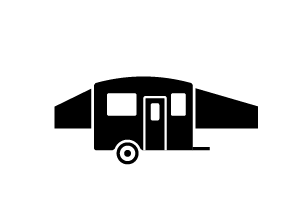
The classic pop up camper is what many people think of when they think of upgrading their tent camping experience. A pop-up camper is more lightweight than any other type of RV, making it easily towable behind almost any vehicles with a hitch. And, unlike other types of RVs, pop-ups feature a collapsable living environment designed for convenient transportation.
A pop up is the best type of RV for a young family on a budget, especially, if your crew enjoys tent camping. Pop-ups offer basic water and electricity hookups and feature sleeping accommodations for up to 6 people.
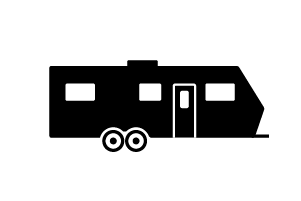
The classic camper – also known as a caravan or travel trailer – is similar to a pop-up camper, but more substantial and versatile. Whereas a pop-up trailer features a collapsible frame, camper trailers feature solid sides, making them more durable, and light enough to be pulled by most mid-size SUVs. As a pop-up, travel trailers often feature the same basic amenities and sleep between 4 to 6 people, depending on the size of the camper.
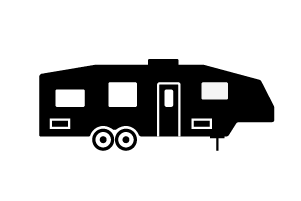
A fifth wheel RV is the height of luxury for a towable . This type of RV more resembles a home on wheels, than a camper. Fifth wheels offer the unique benefit of taking it wherever you want and living out of it for however long you want.
Many owners choose to travel to their fifth-wheel trailer, instead of taking it with them. These RVs feature full kitchens, full-size refrigerator, excess pantry space, large wardrobes, washer and dryer hookups, multiple full bathrooms, and more. These RVs sleep up to 8 people, which is why the fifth wheel offers the greatest benefit for large families or retired part-timers that want all the convenience and practicality of their home –on-the-go.
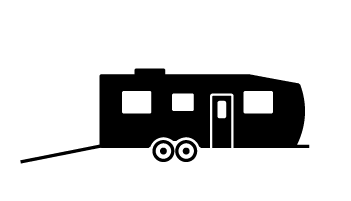
Toy hauler RVs are a big upgrade from your classic camper trailer. These oversized campers are designed with a small garage space to haul an additional vehicle, motorcycle, dune buggy – or any other toy you want to bring on your RV trip. When you want to unload your toy, simply lower the ramp and roll-out.
Toy haulers have an interior cabin that features all the luxury amenities of a fifth-wheeler or mobile home. Some toy haulers are designed with expansion panels to provide all the space you need for 4 to 6 people. The amenities of a toy hauler include a full kitchen, a master bedroom and guest sleeping quarters, and a living room with 8-foot ceilings.
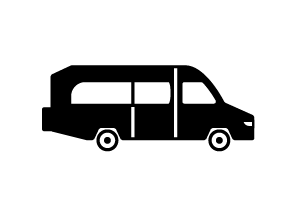
Motorhomes offer the most luxurious amenities and conveniences for camping, traveling, and more. Class B motorhomes offer the perfect combination of luxuries, practicality, and dependability. More dynamic and spacious than a truck camper, but no larger than a utility van – a class B motorhome features higher-end amenities, more living and sleeping space, and a variety of high-tech luxury amenities
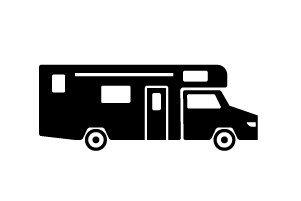
A class C motorhome is the perfect type of RV for family road trips. Class C RVs are built on a Chevy, Ford or Sprinter (and a few others) van/truck chassis, called a cutaway. A Class C RV comes with a fabricated living space built onto it.
There are several unique benefits of a mass produced, major manufacturer-built chassis: The drive, suspension, and engine is built by a household name you trust. A Class C can be driven from campsite to sight seeing without the need for a dinghy, or additional car, and it is large enough for families and pets.
A Class C RV is a nice in-between RV for those looking for a motorized unit with more space than a B but less than a big class A motorhome. And, unlike a Class A motorhome, your Class C can receive nationwide repairs and support on the vehicle chassis at Chevy, Ford, Sprinter dealerships, and more. So, you are never bogged down by searching for a special large truck repair shop if something goes wrong on the road.
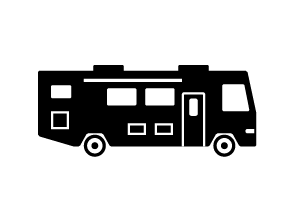
A class A motorhome features similar square-footage and luxury amenities as a fifth wheel RV, but it drives itself. The biggest difference between the two is that class A motorhomes are self-propelled recreational vehicles. Class A motorhome RVs offer the greatest convenience and benefit for traveling cross-country. Class A motorhomes come in 2 varieties: gasoline and diesel.
Gasoline class A motorhomes have enough power to pull a small vehicle behind it, but nothing too large. Diesel Class A motorhomes, on the other hand, are powerful enough to pull a full-sized car, truck, or SUV behind it. Those who opt to live in their RV full-time often get a diesel class A motorhome since it can pull additional cars, boats, and more – and it offers the same conveniences, spaciousness, storage, and luxury amenities as a real home.
Which RV is the right choice for you? It depends on how you plan to use it – and how much use you will give it. Learn about which types of RVs offer the best customizable amenities by contacting an RV specialist for a free consultation .
Select the department you wish to contact and fill out the form. A representative will be in touch shortly regarding your inquiry.
Alliance Careers
Mailing Address 301 Benchmark Drive Elkhart, IN 46516
Plant Tours
See Our Plants See how your RV is made, schedule a visit today!

Size-Charts.com – When size matters
For buyers & sellers – Size charts & Product size plugin
Rv Size Chart – A Guide To Choosing RVs and Campers
Ideally, campers and RVs are lovebirds. Camping addicts are always confused, wondering which recreational vehicle to purchase. There are different classes of RVs today, and choosing your favorite can be hectic. That is why we have created a deeply researched RV size chart to help you out.
There is a wide range of popular models of RVs which can improve your camping experience in everyday life. Don’t dilly-dally to find your excellent choice. If you don’t want the living space to be in the same vehicle, then tow a trailer.
Looking for RV and other Tire sizes? check it here
(Recreational Vehicle)RV Size Chart
Here we depict the travel trailer length in feet and cm, weight in pounds and kgs, and the number of people who can occupy the sleeping space. A travel trailer can have limited passenger space and can only be used by the family, for example, a 10-12 feet trailer. For a 39-40 feet travel trailer, you can include friends.
Recreational Vehicles (RV) in different Models
Class a size chart.
If you attended American schools you probably understand that A’s are the best grades. This is the same with Class A motorhomes. Class A motorhomes are actually the best RVs to purchase due to their super quality and features. They are luxurious and have a range in length of 29ft – 45 ft with every facility you would like inbuilt.
The Class A motorhomes are however expensive to purchase. Below is the Class A size chart.
Class B Size Chart
The Class B RVs are smaller compared to Class A but they are mobile and compact. They can easily maneuver anywhere. They also attract lower accommodation fees compared to Class A.
Even though Class B has limited amenities and limited passenger space many Rvers continue to love them. In fact, they can only onboard two people. They overlook all this because Class B is very mobile. The fuel consumption of Class B RVs is low hence saving the fuel costs. To be precise you can only compare them to the common vans. They tend to save lots of bucks during your outdoor adventure.
Class C Size Chart
Like Class A the Class C motorhomes are pretty luxurious. Did you know that you can have a Class C motorhome for your camping while spending a few hundred dollars? It is possible, as many Class C motorhome owners prefer to rent out their RVs to get some bucks to cater for maintenance and ownership.
The advantages of Class C motorhomes are overwhelming, as it has up to eight sleeps, they are pocket-friendly, and you don’t have to tow the Class C motorhome with a truck.
Recreational Vehicle Fifth Wheel Trailer Length
It is a towable RV trailer with no engine hence increasing the living space. In fact, it is very easy to pull and requires a heavy-duty truck. There are 32ft, 34ft, and 36 ft long fifth-wheel trailers Find the fifth wheel length in feet and cm.
Recreational Vehicle Overview
The table below shows the overview of the recreational vehicle with the length depicted in Feet and cm.
How much does a travel trailer cost?
In case you want to purchase a smaller trailer or the largest trailers with extra sleeping space and lots of storage space, we have done some research to determine the trailer cost and we have found an excellent option for American expedition vehicles.
There are cheap trailers with limited amenities, no cooking facilities, lack bath facilities, has limited passenger space, and limited living space, and they are valued at as low as $11,000. However, there is a popular choice of larger motorhomes with ultra-modern basic amenities and can be valued at up to $150,000. They come along with laundry facilities, air conditioners, and bathroom facility just to mention.
Below are the costs of travels trailers for American expedition vehicles, there are others we believe we left out but these are cost effective.
- Coleman CTS17FQWE – $11,000
- Coleman CTS235QBWE – $13,000
- Starcraft AR-ONE 20BHLE – $15,000
- Jayco Jayflight 145RB Baja – $14,000
- Coleman CTS262BHWE – $17,000
- Forest River Gray Wolf 24RK – $18,500
- Rockwood Mini Lite 2109S – $22,000
- Shadow Cruiser 195WBS – $19,000
- Jayco Jay Flight 23RB – $23,000
- Rockwood Mini Lite 2504s’ – $24,000
- Keystone Cougar 24SABWE – $25,000
- Forest River Vibe 268RKS – $29,000
- Heartland Mallard IDM29 – $23,500
- Forest River Wildcat 28RKX – $32,000
- Jayco White Hawk 28DSBH – $35,000
- Keystone Outback 326RL – $35000
Factor to consider when purchasing an RV.
You need to take time and conduct internet research and take your time before purchasing an RV. Also, consider visiting the local dealership to find out the available RV deals. You can also visit the truck manufacturer website to determine the starting price.
Watching RV Shows.
There are a few sites such as RV Miles which has a listing of the available deals in Canada and United States. There is excellent option for even larger models and mid-size option presented by salesmen. Attend a series of shows and talk to different salesmen before deciding on the complete solution.
Read Reviews.
If for instance, you found a company selling RVs online it is advisable that you consider reading the reviews of previous customers before deciding to spend your bucks.
Conducting Inspection
Before making any payment always ensure that you have conducted an inspection of the RV to ensure that it is not faulty.
Private Sellers.
If probably you know someone who is selling his or her own RV, it is advisable that you consider purchasing it. This is because you probably have been seeing the person drive the RV. It instills confidence that the RV isn’t damaged at all.
In-depth Research.
In reality, purchasing an RV blindly without conducting any research is foolish. If probably you are so busy you can consider hiring a researcher to help you with the research work, however, this would take you a few hours a week for 2 weeks so that you can make a sober decision.
Avoid Purchasing RVs from West East Coast.
Due to that the salty water the RVs are usually corroded and at times damaged by water and can have molds. It is unlikely that you will find a faulty RV on the coast.
Correct Timing
It is always advisable to check out when you purchase an RV. During the early winter when people are not going out for camping a truck manufacturer will offer great discounts. This also happens at the end of summer.
Consider Fuel Consumption.
As a matter of fact, a heavy-duty truck will consume a lot of fuel increasing fuel costs. It is therefore advisable you conduct an inspection to understand the fuel consumption of different RVs before making a decision to purchase.
Like purchasing any other kind of vehicle, while purchasing an Rv it is important that you ask for the warranty cover. Don’t be overexcited by the fitting in the RV. In case any part is faulty and you have already paid it will be expensive to replace the parts on your own.
Make a revisit to the factory or company.
It is advisable that you make a few visits to the factory to ascertain that the RV is in proper shape and that all the fittings are done correctly to match your camping style.
Conclusion.
In this RV size chart guide, we have put up a well-researched manuscript for campers who are planning to purchase a new or old recreational vehicle. We have included the imperial metrics of the length and weight of the different RVs available for purchase in the market. To be precise, buying an RV can be a DIY activity if you have read through this guide vividly. You should never be baffled about purchasing an RV, but you need to be careful not to purchase a faulty RV which will, in turn, cost you more to take it to the garage.
If you enjoyed reading this RV chart guide it is our humble request that you take time to leave a comment below.
Picture in this post by Willian Justen de Vasconcellos on Unsplash
Egle Goleckyte 585 Posts
Imagine a world with minimum to zero returns. Imagine a perfect fitting bought product. Our vision is to improve the online shopping experience by becoming the go-to source for accurate sizing tools and information, reducing returns, and increasing customer confidence and conversion rates.
Privacy Policy
The Partner network
Request or add a size chart
Wordpress plugin
Chat-GPT Size Advisory
Size Chart Search Engine
Size Charts by Brands
- Converse Size Charts
- Allbirds Size Charts
- Dr Martens Size Charts
- Hanks Size Charts
- Hermès Size Charts
- Veja Size Charts
- Lane Bryant Size Charts
- Diadora Size Charts
- Salvatore Ferragamo Size Chart
- Chanel Size Charts
- Levis Size chart
- Valentino Size Charts
- Moncler Size Charts
- Lee Size Charts
- Merrell Size Charts
- Diesel Size Charts
- Armani Size Charts
- Wrangler Size Charts
- Salomon Size Charts
- Miss Me Size Charts
Size Charts by Topics
- Insoles Size Chart
- Bookcase Size Charts
- Battery Size Chart
- Country size charts
- Bracelet Size Chart
- RV size Chart
- Rug Size chart
- Skateboard Size Chart
- Cap Size Chart
- Fitness Size Chart
- Music Size Chart
- Condom Size Chart
- Gun Size Chart
- Snow Size Chart
- Helmet Size Chart
- Diapers Size Charts
- Hats Size Chart
- Maternity Size Charts
- Gloves Size Chart
- Glasses Size Chart
Size Charts by Gender
- Men Size Charts
- Kids Size Charts
- Women Size Charts
Size Charts by Types
- Comfort Size Charts
- Dog Size Charts
- Fish Size Chart
- Gender Neutral Size Charts
- Golf Size Charts
- Horse Size Charts
- Luxury Size Charts
- Plus Size Charts
- Safety Size Charts
- Work Size Charts

Home » RV Lifestyle Topics » What Size RV Do I Need? Size Comparisons of Each Type
What Size RV Do I Need? Size Comparisons of Each Type

Choosing the best RV can be a difficult task! It isn’t always easy to pick the perfect solution on the first go-around, especially if you are new to the lifestyle. I drive a camper van but it may not be the right choice for you. There are times when I think it’s not even the right choice for me. I often think about owning a more spacious solution but the benefits of the Class B keep me content.
There are benefits to owning the Class B that I own and the same can be said for all the rest of the different RV types. Each has its pros and cons list and different things matter to different people. If you are unsure or still on the fence, this article will help you decide by looking at the different types of RVs and their sizes while laying out the good and bad of each.
RV Size at a Glance
Drivable rvs (motorhomes).
Motorhomes offer a ton of benefits with my favorite being that they provide an all-in-one solution . You can move between the driving and living areas without ever leaving the vehicle. This provides more convenience and safety.
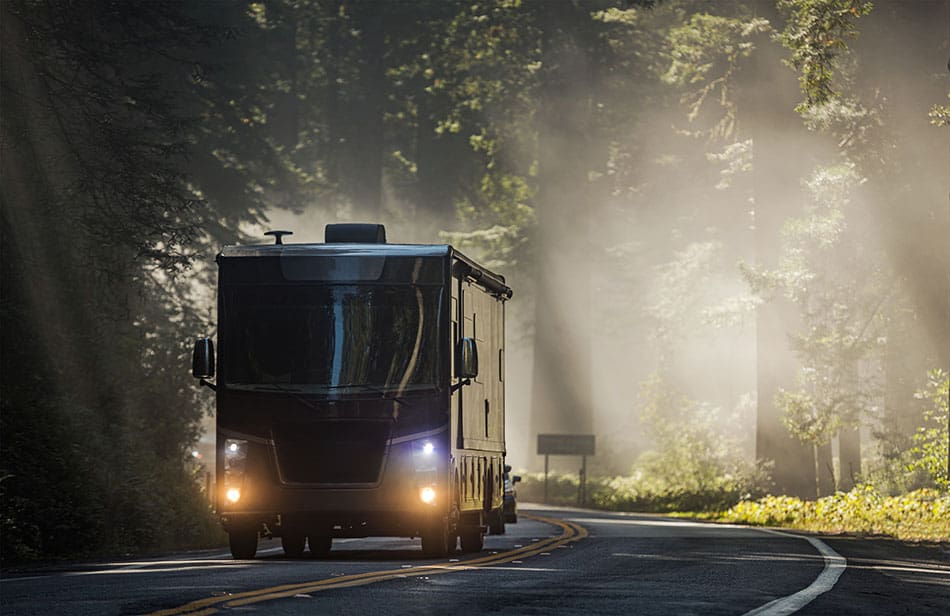
A class A RV is going to be the largest of all of the drivable types of RVs. This is the one you want if you have a large family or you want a lot of room inside so that you can get comfortable. It’s like a small house on wheels that has all the room and amenities inside that you can imagine. These come in all sizes and some of the largest ones can be upwards of 45 feet in length .
Some of the smaller class A RVs can be 25 feet in total length. However, even with this short length, these are often very accommodating with a well-thought-out floor plan and also may include slide outs that add additional living space inside.
These are usually gas hogs and will cost a lot of money to operate and drive long distances. If you are looking for an RV that will fit you, your family, and all of your belongings while maintaining a comfortable living space, a class A may be a good choice for you.
There are some downsides such as being more challenging to drive, being very expensive, and having to tow a vehicle behind for personal use.
- A class A RV has lots of living space inside
- A class A RV has all of the amenities you could expect for a comfortable living setup
- It’s drivable
- Gives you a luxurious, homey feel no matter where you go
- You will likely need a towable vehicle to pull along with you
- They are big and challenging to drive
- They are the most expensive type of RV that you can buy
- They are expensive to operate
- They require a lot of space for parking
Who’s It For?
The class A motorhome is for those who want luxury at its finest! You’re the type who has a lot to spend on an RV and wants to make sure you are comfortable no matter where you go. You’re the envy of every other camper in the campground as they look at your massive rig in amazement of all the space you must have inside. You’re not looking for the camping experience but for the feeling of traveling in comfort and style.
If you have the money, a small car to pull, and no fear of driving one of these big rigs, you’ll love it!
Class B – Camper Van

Class B RVs are the complete opposite of the Class A’s mentioned above. You won’t find lots of elbow room inside one of these RVs but you will find a lot of other conveniences. A class B (camper van) is an amazing vehicle for being able to get you into places that larger RVs just can’t go. Besides that, you can use it like a car without the need to tow an additional vehicle with you.
While you won’t find the space inside comparable to a larger motorhome, you’ll appreciate just how nimble a motorhome of this size is.
- Small and nimble, easy to drive and park
- No need for a towed car
- Fits into nearly any parking spot
- Resale value higher than most classes of RVs
- Good fuel mileage
- Small living space
- Expensive for what you get
A camper van is for someone who is looking to be able to travel far without the inconvenience of a large vehicle. A camper van can go nearly anywhere so this type of RV or for those who are a bit more adventurous and aren’t concerned as much with spacious living arrangements.
A camper van is great for one or two people but may be a challenge for a family. This type of RV has been my preferred choice for a few years now and I have thoroughly enjoyed it. While there are times that I wish I had more room inside, the benefits of driving a small home around like this outweigh any comfort issues.
Class B RVs can be quite expensive with some in the range of $200,000 or more. Most of them sell for over $100,000 brand new with only a few on the market that are below this amount. You can find used ones for a decent price but they do keep their value pretty well for an RV. You may be better off converting your own as I did if you want to save money.
If a Class B is too small for you but you still want a small footprint, the class B+ is a good compromise. These are also built on a van chassis but usually have a custom-built living area that is larger than the van itself. Because of this, you get more living space inside which can be a game-changer for this small of an RV.
Some of the best on the market include the Leisure Travel Vans Unity and the Airstream Atlas . While these are classified as Class C, they are smaller than the typical class C and more akin to a van than most. This is an expensive option but worth the price if you intend to travel and use it a lot.
- Good size without being too small or too large
- High-end features that rival that of a larger RV
- You may need to tow a vehicle
- Hard to find due to the popularity
This type of RV is for those who like the small footprint of a class B van but find the van alone to be too small. A B+ van will allow for more living space inside and be more comfortable to travel with. They maintain a small footprint but open up inside to a more spacious and luxurious living environment.
If you have a small family but want to stay small with your choice of RV, this size will fit perfectly. You will truly be traveling in style and will be able to drive and maneuver the rig without the troubles of a much larger one.

The Class C RV is the most popular of all the motorhomes on the road. This is mainly due to their spacious floorplans and affordable prices. You can find these on the new market at a good price but used ones for even better. These RVs come in all shapes and sizes and vary in total length.
Whether you are looking for a small one or a large one, you’ll find a huge range of sizes between manufacturers and models.
- Affordable motorhome option
- Variety of sizes and floorplans readily available
- Lot’s of living space inside
- Comfortable to drive, usually on a van chassis
- Lower priced models can be inferior in quality
- You will need to tow a car if you want the freedom to explore an area once you set up camp
A Class C RV is a great choice for a small family who wants to travel with a spacious living area. These often are designed with multiple sleeping areas and usually always have an extra bed over the cab. This area works great if you have children or other visitors while you are camping.
These range in size from about 20 – 40 feet in total length.
They usually have slide outs and the space can be opened up further for an even larger living space. They are often affordable and easy to acquire as most RV dealers have a wide range of this type of RV in stock.
Truck Camper

Unlike the other motorhomes mentioned above, a truck camper requires you to have a vehicle in order to use it. This is a good thing since you can choose the exact model of truck you wish to drive. Many people use a four-wheel-drive option for this and a truck camper serves as an excellent adventure vehicle.
You can drive into locations and enjoy it where you might not be able to drive other RVs. These come in a range of sizes and the size you choose will be determined by the type of truck you have. There is a truck camper that will fit almost every truck model on the market including the most compact trucks, all the way up to the most capable trucks on the road.
Unlike the other motorhomes mentioned above, you’ll need to exit the truck in order to access the camper in the back of the truck.
- It can be removed from your truck as needed
- Small and easy to store when not in use
- You must have a truck that can handle it
- Layouts and interior space is minimal
- Larger models can extend up high making them top-heavy
If you already own a capable truck, finding a camper to put on the back of it may be a great choice for you. This is especially true if you only camp occasionally and it’s only you or you and another person. The space is limited inside one of these so you won’t be able to comfortably fit a family inside in most cases.
For the person who wants to get away on off-road adventures, and camp for the night, a truck camper makes a great choice.
Towable RVs
Towable RVs are generally more affordable and offer spacious living arrangements for the size. You’ll need a vehicle to tow one and you’ll also have to get out of your vehicle in order to access the RV.
Small to Medium Trailer

A small travel trailer such as a teardrop trailer or a pop-up camper is an affordable option that allows anyone with a capable vehicle to tow it to a camping destination. While these aren’t very spacious, they do provide all that one needs to be able to enjoy a comfortable getaway in nature.
The main benefit of these types of RVs is that they are small and affordable. Not only that but they do not require a large vehicle to be able to tow them. Many SUVs and small passenger vehicles can tow a small travel trailer with no problem. This makes it a great choice for a family who already owns cars and just wants an RV to be able to go camping occasionally.
These range in prices but a small teardrop trailer can be purchased for as low as $15,000 and a small trailer that you may be able to walk around in such as the R-Pod , can run up to $30,000 and beyond for a brand new model.
- Can be towed with almost any car
- Once camp is set up, your car can be used to drive freely
- The used market is full of them
- Not very spacious
- Requires a vehicle to be towed rather than being drivable
A small travel trailer is great for someone who wants to get away on camping trips but doesn’t want to spend the money for a drivable option. The interior in small travel trailers can often be compared to a smaller class C or class B van. They are easy to maneuver around even though they do require towing.
If you already have a capable vehicle, a small travel trailer can be an instant way that you can become an RVer. They are affordable and with many of them on the market, you can purchase used for deep discounts.
Large Trailer

A large travel trailer can provide the space needed for real family fun. These are larger than the smaller ones mentioned above but can be perfect if you are wanting more room with more luxurious amenities during your travels. These often come decked out with features and provide a great experience at an affordable price.
A large travel trailer ranges in size from about 20 feet to 40 feet. There is something for everyone but some of the larger ones will require a more beefy vehicle to tow them. Some of the large trailers can weigh over 10,000 pounds so will need something that can do the job of towing it.
These are popular and you see them all over campgrounds. They are easy to find and purchase and are readily available at an affordable price.
- Spacious interior with a homey feel
- Class A motorhome size at a more affordable price
- Insurance is cheaper than a motorhome
- Lots of used options are available
- A larger vehicle is needed to tow it
- No easy access to the trailer while traveling
- Size may be too big for maneuvering in small campgrounds
If you like the size of a class A motorhome but don’t want the costs associated with one, a large travel trailer will be a great option. If you already own a vehicle capable of towing a travel trailer of this size, it may be the perfect solution for you.
For people who have families and need a large capacity RV, a travel trailer is a good route to go.
Fifth Wheel
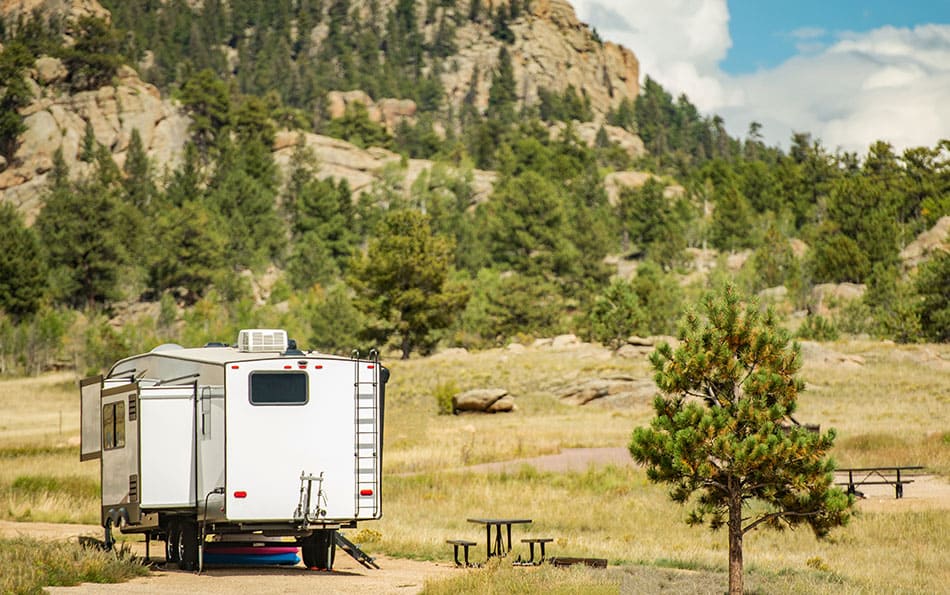
A fifth wheel is a behemoth of an RV that requires a vehicle with a large towing capacity. These RVs are amongst the largest on the market and are like a luxury home that you are towing around. These require a fifth wheel hitch and are considered safer to tow than traditional trailers.
With a fifth wheel, you will have a small turning radius even though it is such a large rig. This is helpful when needing to back in or maneuver around in small areas. These are not cheap and when combined with a truck capable of towing them, becomes a very expensive package.
The interiors of fifth wheels are among the nicest that you will find in an RV. They contain all the essentials and plenty of room for families to not only stay in but stretch out and be completely comfortable.
- Large capacity living area
- Easy to tow if you have a capable vehicle
- Requires a vehicle with a fifth wheel hitch capable of towing it
- Requires a lot of parking space for camping and storage
A fifth wheel is perfect for someone who wants the largest RV that they can get in a towable solution. If you already have a truck with a fifth wheel hitch or one that is capable of handling one, these make a great option. If you don’t mind towing around a huge trailer, these can feel like you are in a luxury home at the campground.
Bottom Line
There is an RV for everyone and each person will require a different solution. This all depends upon personal preferences and the type of camping that you will be doing. It also depends on how many people are involved and the amount of space required for a comfortable experience.
My suggestion is to rent some RVs to find out which one may be perfect for you. If you have never been inside the different types and sizes of RVs, go look at some on a dealer’s lot. Just don’t get suckered into buying one before you are ready! Figure out which sizes you are most interested in and look into a few rental options. Only after spending some time camping in them will you know the type that you prefer and will work best for you and your family.
Dan Collins
I consider myself an outdoor enthusiast. I love to travel and go to places that most people don't get a chance to go. I want to see it all and live life to the fullest while I'm alive. My camper van is helping me to do just that. I write about my experiences to help inspire others to do the same.
Recent Content
6 Reasons Why Renting an RV Is a Good Idea
Purchasing an RV can be quite an expensive undertaking! Not only is it expensive but also requires space in which to park it. Many people just don't have the room for a large RV sitting in their...
11 Must-See Class B RVs Under 20 Feet
Class B RVs are the smallest class of drivable RVs that you can own. However, some of them can extend to lengths that make them less nimble than one might desire. If you are looking for a smaller...

No products in the cart.

The Best Length for a Travel Trailer (Size Chart Included)
NOTE*** The content on this page may contain affiliate links, we may make a commission. And, as an Amazon Associate, we earn from qualifying purchases. More information: disclosure page .
Just in the last decade, I have owned, rented, and sold a number of travel trailers. I have my own share of experience with the different lengths and sizes of RVs. In this article, we get into the different travel trailer sizes and include a travel trailer size chart for you.
What size travel trailer should you buy?
Generally speaking, the ideal travel trailer length for a family of 4 is 25-30 feet long. With a 27-foot travel trailer, you can likely park in your driveway, camp at 93% of national parks, and still have room to sleep 4-6 people comfortably.
Generally, for convenience, longer travel trailers are the best choices for a family with at least 4 members or more. However, there are roads and campsites that have limits on the lengths that they can accommodate.
I have personally experienced the benefits and drawbacks of traveling in different lengths of trailers. So I made this article in the hopes of helping you determine which is the best length for a travel trailer for you. It can also serve as a guide so you can rule out the other sizes that you know won’t work for you.
No matter how long your trailer is you need to see behind you. Campsites can be tight and have obstacles (like kids). A wireless backup camera makes life so much easier .. and safer. This wireless camera on Amazon is easy to install, budget-friendly, and best for shorter trailers ( check price here )
Longer trailers and especially with metal siding will need a wired backup camera. This takes a little longer to install but you can still do it yourself. We suggest this wired backup camera on Amazon .
Best Size Travel Trailer by Length
Some will say that anything above 30 feet is too long for a travel trailer. But the truth is that the answer to whether a travel trailer is too long lies on your tow vehicle.
As a rule of thumb, the longest trailer that your tow vehicle can pull is the one that does not exceed 75% of the maximum loaded weight of your vehicle.
Travel Trailer Size Chart
I put together this travel trailer size chart to help you see the length, weight, and accommodations for travel trailers. This is based on reviewing hundreds of RVs and my own experience.
A big consideration is the number of people in your family. How long does it have to be for you and your family to live in it comfortably?
Travel Trailer Length Based on Camping Preference
Some people report that a travel trailer that is more than 35 feet is a problem when they are looking for a campground to set up base on. Many of the available campgrounds, especially national parks, only have limited and small space.
However, if you own a bigger rig, finding the right campground is possible if you are willing to stay in the vicinity of the sites.
The question will lie in your preferences. Do you plan to camp in National Forests or dispersed campgrounds? If so, then having a long rig will seldom be a problem for you as these campgrounds usually can accommodate longer rigs.
If you prefer to camp in National Parks or small private campgrounds then this might prove to be a slight problem as these campgrounds usually have limits on how long of a rig they can serve.
Read More: 11 Questions You Must Ask to Reserve the Perfect RV Campsite
Pro Tip: Make sure to look into the campgrounds that you plan to stay at. When you are thinking about tight spaces or bumpy roads take into account eh turning radius and hinge point of the trailer.
RV Rental Information
- Motorhome Rental Near Me
- Rent a Travel Trailer
- Pet-Friendly RV rental
- Rent on RVShare
RV Destinations You Will Love
- Places to Camp in Fall
- RV Destinations in October
- Incredible RV Destinations in November
- Places to Camp for Thanksgiving
- Places to Ring in the New Year
- Magical Places to Camp this Christmas
- RV Destinations for December
- Places to Camp in February
- Places to Camp this Spring
- RV Destinations for Spring Break
How to Measure the Length of the Travel Trailer

The length of the travel trailer that your manufacturer specified is the box of the trailer and considered your trailer length. State-run campgrounds and some private ones usually base their site length upon the length of the travel unit itself.
Most often than not, there will be a separate parking space for your tow vehicle.
I own a 35-feet travel trailer. It is specified by the manufacturer as 35-feet. When I call to reserve a campsite, I ask for 35 feet or longer.
However, when going through roads that have length restrictions, you have to make sure to measure the whole length with your tow vehicle.
For example, in Independence Pass near Aspen, Colorado, RVs more than 35 feet in length are prohibited to pass. We have a 35 feet trailer but our total length from the bumper from the front of the truck to the bumper at the back of the trailer is 59 feet. (We know this because we were measured when we took the ferry from Seattle. )
Does Travel Trailer Length Include the Tongue and Hitch?

The trailer length and the manufacture description do not include the tongue and the hitch. The length is only the inside box of the trailer.
If you want to know exactly how long your trailer will be you need to include The rear bumper, any accessories like a bike rack, and the front tongue and hitch. The rear bumper generally adds 6 to 12 inches. The front tongue and hitch add 2 to 3 feet to the length.
So for example my 35-foot travel trailer is 38 feet bumper to hitch. It’s even longer when the bike rack is on the back . When towing it with a truck it is 59 feet bumper-to-bumper.
How Does Length of the Trailer Affect Towing
A longer trailer will move differently behind the truck than a shorter trailer. Both the length and weight of the trailer affect the amount of weight on the tongue and swaying the backend. Most experts agree that a longer trailer is actually easier to tow because it will have a slower delay.
Weight distribution and sway bar will help you tow a trailer. This is the set that I use which is easily installed and works great. Check the price on Amazon.
However, the total radius with a longer trailer will be longer. Therefore your turns will be much wider. In addition, you only to watch the inside corner very carefully for obstacles.
What Are the Disadvantages of a Longer Trailer?
The longer your trailer is, the more difficult it is to look for camps to stay in. Generally, state parks commonly have a length restriction of 35 to 45 feet. However, when your rig is 41 feet or above, you have to expect that you will only be accommodated by less than 10% of the campsites. On the other hand, 98% of campsites can accommodate trailers that are 19 feet and less.
Another disadvantage of a longer travel trailer is the total weight. Once you get up to 30 or more feet and 7 to 8,000 pounds you will need a 3/4 ton or 1-ton truck to tow it.
Pro Tip: Keep in mind that you’re towing capacity will be reduced by up to 20% at altitude and over the mountain passes
A longer trailer has more tail drag in the back end. You will need to be driving on relatively flat roads. So you will be limited to maintained roads and campgrounds. You will not be able to off-road or boondock much.
What are the Advantages of a Longer Travel Trailer
A bigger, longer-length travel trailer has many advantages. A longer camper has more room inside giving you more space to move around. You will also have more privacy. My trailer with 35 feet length actually has 2 separate bedrooms with doors.
Another advantage is the convenience of the space. A smaller camper will need to be spending time changing the inside back-and-forth between living quarters and sleeping quarters. Our first Trailer was a 20-foot long vintage camper with no slide-outs. Every night and every morning we had to transform it back into a table put the bunks away and make the bed back into a couch just to have breakfast.
A longer travel trailer can carry more weight. Once you have a camper you will want to load it up with all your favorite camping gear. You would be surprised how much your toys end up weighing.
In addition, if you are Boondocking he will be also be carrying a full tank of water to your campsite.
A larger trailer also responds to movement when towing more slowly than a short trailer. Some people even say driving a longer trailer is easier than a shorter one. The hinge point at the back of the tow vehicle and the distance to the back end of the trailer is longer. The physics determines how quickly the very back of the trailer responds to small adjustments in the front.
Overall, I never recommend buying an RV before trying out if you like it. You can see all my thoughts here: 17 Undeniable Reasons Why You Should NOT Buy an RV
I advise renting a travel trailer similar to what you are thinking of buying: How Much Does it Cost to Rent a Travel Trailer? (Prices 2022)

Summing up the Ideal Length of a Travel Trailer
The best length for your travel trailer will depend on the needs of your family. If you are traveling long-term and want more space and amenities similar to an apartment, you will require a bigger camper. If you are planning on shorter trips to national parks and sightseeing, a shorter travel trailer will likely work for you.
Before buying a camper I always suggest that you try renting at least one similar to what you’re thinking of buying. Travel trailers are difficult to rent from national companies. However, you can rent from a private owner on Outdoorsy or RVezy .
To rent a camper similar to the one you’re thinking of buying simply go to the Outdoorsy or RVezy website. Once you’re on the website choose the destinations that you would like to pick up the travel trailer. Then from the options choose the number of people that should sleep and your ideal length.
For more resources in renting an RV, read some of our blogs under our RV series:
- 17 Tips to Know for Your First RV trip with Kids
- Questions to Ask Before Renting an RV
- Where the Best Deal on an RV Rental
- How to Reserve the Perfect Campsite Every Time
Similar Posts

Atlantic vs Pacific Ocean: Which Ocean is Better?
The Pacific Ocean is overall calmer and warmer than the Atlantic, though this is not always the case. Whether you’re heading to the beach with young children or looking for the next wave to catch, your decision could be influenced by several factors.

Earn Money Renting Out an RV on Your Property (Read This First!)
In general, you can rent out your RV on your property if your local laws and neighborhood allow it. Read this article to learn more about renting your RV on your own property.

7 Expert Tricks to Keep Mice Out of Your RV or Travel Trailer in Winter
Imagine opening up your RV just to de-winterize it, but what you see are mice! Yuck!! That’s me, I learned the hard way. So in this guide, I will give you tips on how to keep mice out of your travel trailer

Can RV Surge Protectors Get Wet? (Caution When Outdoors!)
Damage to your RV electrical systems can be totally disabling. I strongly recommend using a surge protector to protect your RV. You might wonder, are RV surge protectors worth it? What happens if they get wet? I’ll answer all of your questions here.
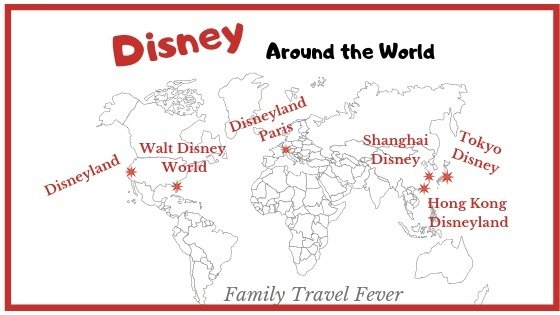
Disney Resorts and Theme Parks Around the World
Did you know that Disney has 6 Disney resorts and 12 theme parks around the world? The Disney resorts are Disneyland Resort, Walt Disney World, Disneyland Paris, Tokyo Disney Resort, Hong Kong Disneyland, and Shanghai Disney.

Do RV Outlets Work On Battery?
RV electrical systems can be somewhat of a mystery. All you want to know is if the outlets will work on battery. We have the answer and a good electrical tutorial here.
Leave a Reply Cancel reply
Your email address will not be published. Required fields are marked *
This site uses Akismet to reduce spam. Learn how your comment data is processed .
- Skip to main content
- Skip to secondary menu
- Skip to primary sidebar
- Skip to footer

Jeffsetter Travel
Travel Consultants and Travel Tips
How To Choose The Ideal Travel Trailer Size (With Size Chart)
May 26, 2023 by Stephanie Lane
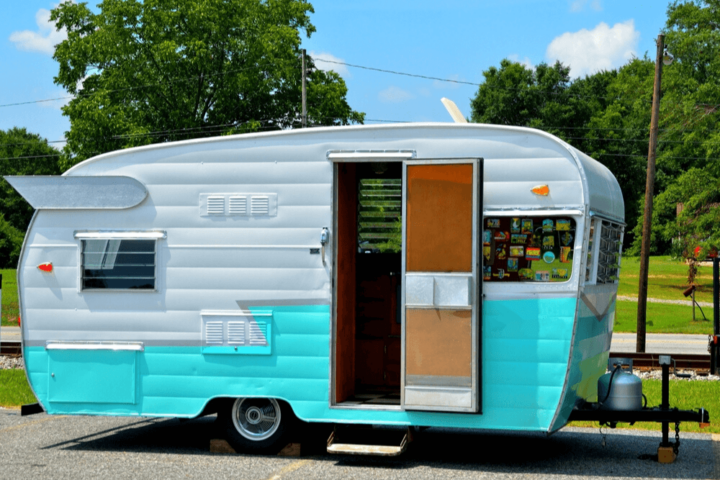
All of our reviews are based on exhaustive research, industry experience and whenever possible, hands-on testing. When you make a purchase using one of our chosen links we’ll get a small percentage of the proceeds. This supports the site and keeps Jeffsetter running. You can read more here .
If you are in the market for a travel trailer and don’t know where to start, then you’ve come to the right place. A travel trailer is a great option if you are interested in having added comfort and amenities while you camp. It can be really hard to figure out what to buy though because there are so many options on the market.
The term travel trailer seems to encompass so many different things. They come in different styles and sizes, it’s hard to narrow down what is going to be ideal for you.
So, how do you choose the ideal travel trailer Size for you?
The ideal travel trailer size for you will depend on your unique travel situation. Generally, a travel trailer should be under 27 feet in length in order to access more parks and campgrounds. That being said they can come as small as 8 feet long to over 40 feet long and any size in between.
This article will explore all the different sizes available, why size matters and should be taken into your consideration, and how to pick the perfect travel trailer for you.
What Is A Travel Trailer?
Travel trailers are the most common type of RV found on the road. They are also known as bumper pulls and are hitched to your vehicle and towed to campgrounds or parks. They offer sleeping accommodations and usually have at least some type of kitchen. Some people might even choose to live in their travel trailer full-time !
The trailer itself is usually equipped with a living space and amenities. These amenities will differ depending on the exact model you have but usually include sleeping quarters and kitchen space. The larger the model, the more amenities it will likely have. They are great options if you enjoy camping or travel and do not want to have to pay for accommodations.
Travel trailers come in many different shapes and sizes, each with its own set of amenities and qualifications. Because there are so many options on the market, it can be hard to narrow them down to find what’s best for you and your needs. We will help make sense of all the different options out there and give you a method to figure out which one is ideal for your situation.
Why Does The Size Of My Travel Trailer Matter?
You might wonder why the size of your travel trailer even matters – you just want the one with the most amenities anyways, right?
Not necessarily. There are a few factors to consider when it comes to the size of the travel trailer that will work best for you. The most amenities might mean the largest and you may not have the space to store that or the capabilities to tow it .
If you tend to go the opposite way and want the most simple one on the market, you may end up stepping on the toes of your partner or your children which won’t lead to an ideal vacation for anyone.
The size travel trailer you pick matters for a lot of reasons, let’s explore some of them together.
Reason 1: Towing Capacity
You need to ensure that the vehicle you drive has the towing capacity necessary to actually move the trailer from point A to point B. The weight and length of your travel trailer will affect how it moves behind the tow vehicle.
In addition to making sure that it’s physically possible to tow, you should make sure that you are comfortable towing it. If you’ve never towed anything behind your vehicle before, it will take a bit of getting used to and maybe even some practice. The larger the trailer, the more adjustments you will need to make to how you normally drive .
Reason 2: Storage
Ensuring that you have the space to properly store your travel trailer is a must. It’s not a small investment to make, and maintenance of your travel trailer is of the utmost importance to get the most bang for your buck over time.
Measure your storage space before making the commitment to a new trailer.
Reason 3: Park Access
Plenty of RV parks and campgrounds will have size restrictions and won’t allow you to stay there if your travel trailer is too large. This can become a hassle while traveling and make it difficult for you to find a place to stay.
Before you purchase a travel trailer, do a bit of research about the places you want to stay and visit. That way you can find the campsites in those areas and see what sizes they do and don’t allow.
If you want to avoid drama on a road trip, I recommend double-checking these specifications every time you go on a trip so that you don’t end up with nowhere to park your travel trailer for the night.
Reason 4: Road Safety
We’ve all passed signs that notate the maximum height allowed when driving underneath a bridge, overpass, or inside of a garage. Making sure that you are familiar with the size of your travel trailer is necessary to keep from damaging it or the overpass if you don’t fit underneath when trying to pass through. Not only is that an embarrassing situation, but it can also be a costly one as well.
Don’t forget that weight limits might also apply to your travel trailer depending on the situation!
Reason 5: National Parks
If you are purchasing a travel trailer with the intent of seeing the National Parks, then you should keep the length at or under 25 feet . Most National Parks have a limit to what they allow in their parks which is between 25 and 30 feet in total length.
You will also be likely navigating through roads that are unpaved, narrow, and hard to maneuver through. If the National Parks are on your bucket list, then I would make sure to keep all of this in mind before making your decision.
What Are The Different Travel Trailer Sizes Available?
There are plenty of travel trailers on the market and all of them are designed to suit different campers needs. There are micro trailers for the ultimate minimalist and luxury fifth-wheelers for the large family on the road . Each one is going to offer different amenities and has pros or cons depending on what you’re looking for.
Travel Trailer Size Chart
Below is a chart detailing the basic different sizes of travel trailers and how many people can sleep in them. There are ones on the market that are smaller than the chart shows, so we will also explain the different sizes on the market.
Large Travel Trailers
Large travel trailers are going to be at least 26 feet in length, up to about 40 feet long.
These trailers are typically designed with long-term camping in mind. If you are in need of a temporary home while camping, this is the best option because it gives you the most space to move around and live comfortably. This is also a good option if you’re traveling as a family because there are more options for sleeping accommodations.
Large travel trailers can typically only be towed by trucks that have a high towing capacity because of their size.
Mid-Size Travel Trailers
Mid-size travel trailers are going to run between 21 and 25 feet long. They are smaller than a full-size trailer, but not as tiny as their small and micro counterparts.
These offer a good amount of space for sleeping and moving around. This can suit a smaller family or a couple, but make sure you don’t mind being in tight quarters together before getting on the road!
These trailers can usually be towed by a larger vehicle like a van or a truck.
Small Travel Trailers
Small travel trailers are between 13 and 20 feet in length . They are going to offer some space for sleeping, a small kitchenette, and possibly a small area for dining, but it depends on the configuration you are looking at.
These travel trailers can definitely work for a couple but might feel a bit cramped if you add anyone else into the mix.
They can be towed by trucks and even some cars, but you double-check the specifications just in case.
Micro Travel Trailers
Another option on the market for the solo traveler or the ultimate minimalist is the micro or mini travel trailer. These are going to be the smallest options on the market and are usually between 10 and 13 feet long.
These can be used for cargo, recreation, or accommodation depending on the style. Some have a small kitchenette or outdoor kitchen, bunk beds, and other basic amenities. What amenities your micro travel trailer has really depends on the model you are looking at.
These can be towed by smaller vehicles like SUVs and cars, which can make them a good option if all you own is a car and not something heavier-duty designed to pull a larger trailer around.
What Is The Average Length Of A Travel Trailer?
The average length of a travel trailer is somewhere between 20 and 28 feet long. This makes sense based on everything we’ve stated about travel trailers so far.
The average size of a travel trailer offers maneuverability and makes it easier to travel since a trailer that size will be accepted at National Parks, RV parks, and campgrounds, while still giving enough space and amenities to feel comfortable and maybe even luxurious inside .
The most popular size of a travel trailer is 23 to 27 feet long, which is right in line with the average.
What Is The Ideal Length Of A Travel Trailer?
There isn’t an exact ideal length of a travel trailer, because the ideal really depends on the person traveling with it.
I would hesitate to say that there is a “best” or “ideal” size of travel trailer that you should be looking for but there are plenty of ways to figure out what your ideal is.
How Long Is Too Long?
The average and most popular length for a travel trailer is there for a reason.
Personally, I think a travel trailer that is longer than 27 feet can limit your overall travel experience. Longer than that, and you won’t get into a lot of U.S. State Parks and it can be difficult to plan trips because of this. It can also become a strain on your vehicle to tow something much longer than that.
Are There Length Restrictions?
There are length restrictions in some states in the U.S. These are usually found on the DOT (Department of Transportation) website for that particular state. Keep in mind that these measurements do not include the towing vehicle.
- Maximum length of 53 feet.
- Maximum length of 45 feet.
- Maximum length of 40 feet.
How Do You Measure A Travel Trailer?
Measuring a travel trailer isn’t rocket science, but you want to make sure that it’s done correctly. We’ve already gone over a few reasons why it’s important to know what size your trailer is such as making sure it will fit into storage and not hitting overpasses while driving underneath them.
Make sure to measure your travel trailer while it’s hooked up to the tow vehicle for more accurate numbers.
To accurately measure the height of your travel trailer it needs to be parked on a flat surface and you will need to have a tape measure long enough to reach the highest point. You will want to measure to the highest point from the ground. Make sure that your tape measure is straight and perpendicular to the ground for an accurate result.
To measure the width of your travel trailer, make sure all extensions are retracted and accessories are in their normal travel-ready positions. Look for the widest point of the trailer and measure across. The maximum width for a travel trailer is 8 feet 6 inches, having a trailer larger than that can result in tickets, fines, and penalties.
To measure the length of your travel trailer it should be parked on a level parking spot. Identify the front and rearmost points of your travel trailer and use a tape measure to measure the distance between the two. Keep your measuring tool as straight as possible to get the most accurate numbers possible.
The video below showcases a few tips and tricks to measure your travel trailer.
Is The Hitch Included In the Dimensions?
Not usually! If the hitch is included in the dimensions, it will likely be noted or specified for you. If it’s not specified then you can assume the hitch is not included in the dimensions of your travel trailer.
What Is The Maximum Height Of A Travel Trailer?
In the United States, there is a specified maximum height limit for any travel trailer. That height is 13 feet and 6 inches or 162 inches.
What Are The Most Popular Travel Trailers?
When you start looking into which travel trailer will be best for you, you will come across a handful of popular ones in your research. Popular things do tend to be popular for a reason, especially in respect to a product like an RV or travel trailer where buyers tend to do extensive research before making their purchases. Here we explore some of those popular options and what the pros and cons might be for each.
Teardrop Trailers
These trailers got their name due to their distinctive teardrop shape and are easily recognizable on the road. They tend to be popular because of their design, which is both minimal and stylish. These models usually have all the basic amenities you want while being on the smaller side. They tend to be 8 to 10 feet in length, which also makes them very easy to tow and maneuver.
- A great option for people who want that true camping experience
- Affordable because they are easy to maintain and have low insurance costs
- Lightweight so they are easy to tow around
- Very minimal living and floor space (not a great option for more than 2 people)
- Not designed with extreme weather in mind, so not useable all year round depending on where you live
A-Frame Trailers
A-frame trailers fold up flat, similar to pop-up trailers. When these trailers are set up they have a triangular shape, hence the name, A-frame. They have decent height due to their shape, but are still smaller in length coming in anywhere between 12 and 18 feet long depending on the exact model.
- It’s easy and quick to set them up
- They are lightweight , so they can be easy to tow and maneuver
- They are well equipped for all different weather, even colder temperatures
- They can be too tall for some places due to their height
- They aren’t designed to accommodate a large number of people
- They have limited options for customization
Standard Travel Trailers
A standard travel trailer is probably the image that pops into your mind when you read “travel trailer.” These are towed behind a vehicle and offer living space and accommodations inside.
They can be anywhere from 10 to 35 feet in length and can weigh anywhere from 2,000 pounds to 10,000 pounds. This means they are truly customizable to your needs. They are a very popular choice because of this.
- A wide range of options for amenities; full-sized kitchens, bedrooms, and bathrooms depending on the size you are looking for.
- Will offer enough storage and space for both convenience and comfort
- It will require a heavy-duty tow vehicle to tow due to weight restrictions
- Depending on the size you might have limitations on where you can park and stay
Fifth-Wheel Trailers
As the name suggests, a fifth-wheel trailer is designed to be towed by a fifth-wheel hitch. It is different from a standard travel trailer because it attaches to the bed of the tow vehicle and not just the rear hitch.
These tend to be on the larger side, coming in at lengths ranging from 22 feet to 45 feet. They tend to be the most luxurious options on the market with the largest number of amenities. They will usually have air conditioning, slide-outs for even more space, and generators.
- A luxurious way to travel with lots of amenities and features
- A large amount of space for many people to be comfortably
- Can only be towed by a sturdy pick-up truck or another heavy-duty towing vehicle
- The size makes it hard to maneuver
- The size can also affect where you are able to take your trailer and stay
Toy Hauler Trailers
These can also be called sport utility trailers. They are designed to have a built-in cargo area meant to haul “toys” like motorcycles, jet skis, or other large outdoor equipment.
In addition to this cargo area, they will also have a living space, though the size will be smaller because of the cargo area. Toy hauler trailers will usually come in between 20 and 40 feet long.
- They offer versatility and are a great option if outdoor recreation is your thing
- They also offer customization for your needs and amenities
- Their larger size can make them more difficult to tow and you need a larger tow vehicle
- The living space is smaller due to the cargo space taking up a large chunk of it
So, What Size Travel Trailer Should I Get?
Hopefully, after everything you’ve read, you have a pretty clear idea of what travel trailer is going to be the best for you to buy. There is a lot of information out there, and it can be hard to sift through all of it.
At the end of the day, the “best” travel trailer for you is going to be the one that will suit your travel needs. To make sure that you go with the right option, make sure to consider each point I’ve outlined below.
Length Of Travel
How long do you want to travel for?
Typically, the longer you intend to be on the road, the bigger the space you’ll want. You don’t have to go all out and get the largest trailer on the market, but make sure you get a trailer that is actually going to be comfortable for you and whoever you are traveling with to live and sleep in.
Storage Space
There are two questions to ask when thinking about storage space.
How much do you want to bring?
If you are not a light packer, then don’t get a trailer that doesn’t have enough space for all of your belongings.
How much space do you have to store your travel trailer?
If you have a large lot of land, an extra large garage, or a long driveway, you might not need to consider the space your travel trailer will take up when not in use. Most people do need to take that into consideration because you don’t want your trailer to be hanging into the street or unprotected during the off-season.
It Can Get Crowded
How many people are you traveling with?
It might be even more important to ask yourself how much you like the people you’re traveling with because regardless of the size of the trailer you get, it’s going to be smaller than a house and may feel cramped from time to time.
If you are traveling alone or with your partner, you do have more options and can go a lot smaller which has its benefits.
Vehicle Tow Capacity
Can your vehicle tow the travel trailer?
Unless you want to buy a new vehicle at the same time as you purchase a new travel trailer, you should make sure that your vehicle has enough power to tow the trailer you’re interested in. Many travel trailers require heavy-duty vehicles to tow them, so be careful if you have a sedan.
Parking Plans
Where do you want to take your travel trailer?
As we mentioned earlier on in this article, a lot of state, and national parks have limits on the length of trailers they allow inside. This can also go for run-of-the-mill RV parks and campgrounds. If you want to visit these places, you don’t want to get a travel trailer longer than 27 feet .
Mobility
How well can you maneuver the travel trailer?
Some of this depends on skill and some on where you plan on driving. If you are going to be on dirt and unpaved roads that are narrow with lots of twists and turns, a larger trailer is going to be inherently more difficult to maneuver around.
What Can You Afford?
This is an important question to consider before making any large purchase. Be realistic about your budget and understand that the larger the trailer, the more expensive it will be. Also keep in mind that if the trailer, even a smaller one, is highly customized or has a lot of amenities packed into it, the cost will be higher.
There are plenty of travel trailers on the market and the perfect one for you will be determined by what your travel needs are.
Sizes will vary, but each one will offer some amenities and give you the opportunity to get out into the great wide world for some adventure. The only rule of thumb I recommend going by is keeping your travel trailer under 27 feet long so that you have access to more parks and campsites. Otherwise, there are tons of different styles and types to pick from and each can be customized to suit your exact needs.
Important Links
- Advertising Policy and Affiliate Disclaimer
- Privacy Policy
- Contact Jeffsetter Travel Blog
- Ask Jeffsetter a Question
Recent Posts
- Software Upgrade Caused an Alaska Air Ground Stop
- Hawaiian Passengers Filed Suit to Block Merger with Alaska
- Expect Long TSA Waits at HNL
- Maybe Avoid Kona Airport If You Can
- New for 2024 Mastercard Benefits

- Find a Location
The Complete Guide to RV Types

There’s a lot you can do with a rectangular box! When you start looking at travel trailers, you’ll appreciate the many ways a bed, kitchen, and bathroom may be arranged. This variety is one of the main pros of the travel trailer segment of the RV market.
As the largest segment, it offers an almost endless array of options, from lightweight trailers to off-road options . What makes travel trailers so popular? First, there is the price. Aside from some pop-ups, travel trailers have the lowest starting price, especially if you already own a vehicle that can tow one.
Thanks to the wide range in trailer weights, an equally wide range of vehicles can tow a travel trailer. SUVs and lightweight pickups may tow smaller trailers, while large, heavy trailers may require a half-ton pickup.
Despite these advantages, travel trailers include some drawbacks. In some models, storage space is limited, especially for large outdoor toys and equipment. Additionally, towing a rear receiver hitch trailer can make for a bumpier ride compared to a fifth wheel hitch or motorhome. \
If you are looking at travel trailers, consider these elements:
- Towing requirements/weight : Weight will likely be your starting point if you have a tow vehicle you plan to use. Weight will vary a lot based on the size, construction materials, and amenities. Some manufacturers build the same layout in various lines, with several lightweight and heavier model options.
- Sleeping capacity: When considering sleep capacity, remember that the manufacturer will count both dedicated and convertible beds in the count. Dedicated beds are the most comfortable and require less setup, but you may need a longer trailer to get more of them.
- Features/Options: Travel trailer manufacturers offer upgraded amenities in certain packages or à la carte. You might find luxury packages, four-season builds (with thicker insulation and heated tanks), off-grid capabilities, solar power, and more.
Check out some of our favorite travel trailers from 2023.
What is the most popular type of RV?
Travel trailers remain the most popular RV type on the market, largely due to their price point and towability. Travel trailers often appeal to those looking to buy their first RV because their current vehicle is often capable of towing some version of a travel trailer from its hitch. A fifth wheel, for example, might require an expensive tow vehicle upgrade. In addition, travel trailers are typically more affordable than a motorhome.
Fifth Wheels

If you’ve decided bigger is better, a fifth wheel trailer may be for you. While some fifth wheels are petite, many take advantage of the towing setup to offer longer, heavier units that offer more substantial fifth wheel floorplans .
The heavier weight of fifth wheels is often related to two benefits of this type of trailer: heavy-duty, durable building materials and residential features, including more furniture, larger appliances, and solid interior construction.
Despite the length and weight of a fifth wheel, many RVers consider this type of RV to be easier to tow and turn due to how the trailer couples to the pickup over the pickup’s rear axle. The driving experience may be smoother.
While RVers revere fifth wheels for their space and amenities, some would need to invest in a bigger truck to accommodate the fifth wheel hitch and to handle the weight of these large RV types. Though smaller fifth wheels are available. Plus, there’s the issue of installing and handling that hitch in the truck bed.
When choosing between a travel trailer and a fifth wheel, carefully evaluate your budget, equipment, and lifestyle. The fifth wheel might win out should you prefer a more residential setup, especially if you plan to park it and leave it for weeks or months at a campsite. The travel trailer might win out if you have a stricter budget, prefer to keep your tow vehicle or enjoy road trips with lots of travel.
If you are looking at purchasing a fifth wheel, keep these considerations in mind:
- Sleeping Capacity: Many fifth wheels can accommodate large families and groups, with some sleeping ten or more. However, smaller fifth wheels may feature a single dedicated bed that sleeps two.
- Features/Options: Fifth wheels offer similar features and options to travel trailers, with upgraded packages and amenities. You may also find luxurious interiors with residential furnishings and appliances.
Interested in buying a fifth wheel? Check out the ten best fifth wheels from Camping World .
Toy Haulers

As their name implies, toy haulers have a specific purpose: hauling toys. While some RVers have serious toys, like side-by-side utility vehicles, others desire a roomy setup for bikes and kayaks. Toy haulers are available as both travel trailers and fifth wheels. The distinguishing feature is a large rear door that opens to a storage space.
The rear storage space of a toy hauler is versatile . Many toy haulers come with a lift bed and convertible sleeping space. The open floor space is also good for setting up a spot for remote work, hobbies, or pets. As an added benefit, many rear garages have special hooks and tie-down for securing freight..
Conversely, this rear storage space may also be a drawback. If you store items in it, the garage may take up a significant amount of your trailer space, reducing the living space. Plus, toy haulers are typically wider, heavier, and longer than other trailers, requiring a heavy-duty tow vehicle. Remember to include the weight of the toys themselves when considering tow capacity.
When considering a toy hauler, keep these items in mind:
- Sleeping Capacity: Sleeping capacity varies, with some models offering dedicated beds for two. Those with beds and convertible sleep spaces in the rear garage may offer sleeping space for four or more. Plus, some models have bunk beds.
- Features/Options: Some toy haulers have fuel stations. Another popular feature turns the rear lift door into a patio. Add a screen door to let the fresh air in.
Destination Trailers

Destination trailers are designed for travelers with seasonal or permanent campsites. These large trailers offer luxurious residential interiors with eye-popping amenities like sleeping lofts, kitchen islands, and upgraded appliances.
Despite their space and luxury, destination trailers are often less aerodynamic and heavier than other trailers. But liveability and durability take priority over navigability since they are not designed for frequent towing.
When shopping for a destination trailer, keep these items in mind:
- Features/Options: Aside from the plethora of interior amenities, two important features to consider are holding tanks and removable hitches. Some destination trailers have holding tanks, like traditional travel trailers, while others require onsite hookups. Removable hitches are desirable.
Want to learn more about these more substantial towables? Check out these luxury destination trailers.
Pop-Up Trailers

Good things can come in small packages, and that is the case for pop-up trailers. The entire camping space folds into a rolling box that is easy to tow and store. While traditional pop-ups have soft-sided walls, a-frame trailers have hard sides that fold in.
Pop-up trailers offer many benefits . If you have a vehicle with a limited tow capacity, a lightweight folding camper may allow you to enter the RVing lifestyle without doing a vehicle upgrade. The price point for an entry-level pop-up may be significantly lower than a travel trailer.
Thanks to screened-in walls, pop-ups let in a lot of natural light and fresh air, although the temperature may be harder to regulate. Plus, the soft-sided walls require care and maintenance.
Here are some considerations to keep in mind while shopping for a pop-up trailer:
- Sleeping Capacity : Pop-ups often offer the most “beds per dollar.” Many have two or more pop-out beds, making it easy to sleep four or more. Plus, the interior may feature convertible dinettes and sofas, expanding the sleeping capacity.
- Features/Options: Modern pop-ups are being made with both glampers and off-grid campers in mind, with many additional packages and amenities. Some come outfitted with interior bathrooms. Off-road packages add higher ground clearance, and amenities like solar power and large water tanks can make off-grid camping more comfortable.
Check out our guide to 2023 pop-up campers to learn more.
Teardrop Trailer

Teardrop trailers function the same way as traditional travel trailers. However, this segment of the RV market is popping with innovation. The aerodynamic teardrop shape is iconic, dating to the earliest travel trailers. However, modern designs are uniquely future-forward. Not all are in the traditional teardrop shape, as the term now applies to a broad range of small trailers.
Today’s teardrops come in a fun array of styles. Retro models offer a blast from the past, with checkerboard floors and colorful interiors and exteriors, while sporty models appeal to off-grid adventurers. If micro camping is for you, exceptionally tiny teardrops are available, many of which can be towed by a sedan.
A teardrop’s space limitations may be an issue for you. Some do have slide-outs or pop-out beds, allowing you to expand the interior. Others do not have dedicated beds but feature convertible dinettes and sofas instead. Check out these teardrop additions that can help you make the most of their space.
Check out these need-to-knows before shopping for a teardrop:
- Sleeping Capacity: Most teardrops sleep up to two people, while larger models may have added bunks or convertible furniture.
- Features/Options: Teardrop trailers cater to various lifestyles, with off-grid, off-road packages available. Models with interior bathrooms may have wet baths. Also, some teardrops save space by not having an interior kitchen. Exterior rear kitchens are a unique option.
Truck Campers

Truck campers are often an overlooked RVing option, but modern manufacturers continue to innovate in this realm. The interest in off-road camping is helping to drive demand for truck campers , as these allow RVers to add a comfortable living space to the pickup of their choice.
Navigability is one of the main benefits of a truck camper since you are essentially driving a traditional pickup with no towing involved. Plus, you can remove a truck camper from the truck bed and leave it at the campsite. Truck campers are also more affordable than many other RV options.
Limited space may be the biggest drawback to truck campers. However, newer models feature pop-ups and slideouts, making it possible to expand the space. Just keep in mind that larger truck campers with generous amenities weigh more. Instead of worrying about your tow capacity, you’ll need to consider your pickup’s payload.

While totally unfamiliar to those living in the lower half of the U.S., ice houses are a popular RV in some northern states, where winter temperatures freeze the lakes and ponds, creating unique fishing opportunities.
Ice houses can be towed onto frozen waters to be used as fishing RVs . Specially designed ice holes make it possible to fish from the inside of the trailer, surrounded by the comforts of home. You might find kitchens, bathrooms, and bedrooms.
Like destination trailers, ice houses are not designed for road-tripping, so they may be less aerodynamic than traditional travel trailers. Also, water is an important feature to consider in ice houses, as not all offer plumbing and running water tanks.
Now, let’s look at the motorized segment of the RV market, broken down by classes, ranging from small camper vans to large motorhomes. Class Bs are the smallest, Class Cs are midsized, and Class As are the largest.
Often, deciding which class is right for you comes down to how well the defining features fit your travel needs and liveability and driveability. To get a feel for each, tour models in each class and consider the size of the living space. Then, test drive some to see which feels most comfortable for you.

Camper vans have been a viral sensation in recent years, with social media showcasing the adventures van life offers. Spurred also by remote work, the pandemic, and the popularity of full-time RVing , the ease of hitting the open road in a vehicle not much bigger than a regular SUV appealed to many
The size of a Class B is both a benefit and a drawback. They are the easiest to drive, but they have the least living space. However, some use slide-outs and pop-up roof tents to expand the interior.
A specific type of Class B is known as the Class B+ . These utilize a larger van or bus chassis. The exterior walls expand to increase the interior living space while maintaining the van profile, unlike Class Cs, which often have a higher profile.
Class B considerations:
- Sleeping Capacity: Class Bs are best suited for solo and couple campers, with most sleeping two. Larger models may have room for more.
- Features/Options: When shopping for a Class B, some will have wet baths, and some will have separate spaces for the toilet and shower. Other popular features and options include off-road models with higher ground clearance, solar packages, pop-up roof tents, and more.
Check out some of our favorite Class Bs here .

Class Cs are the most popular segment of the motorhome market. Since Class Cs start with a traditional van or truck chassis, the driving cab will feel familiar and offer many of the safety features of regular road vehicles. Unlike Class Bs, the rear portion is cut away and replaced with an expanded living space.
Class Cs come in a range of lengths and offer a variety of floorplans. This diversity adds to their popularity, with models designed to appeal to everyone from the solo traveler to larger families. Take your pick from a variety of chassis , including both diesel and gas models.
Having the living space and driving cab integrated can be an advantage. Some RVers like the simplicity of driving with no trailer in tow. However, with this RV type, you will either need to bring a tow vehicle behind the motorhome or else drive the motorhome every time you leave the campground, which may involve unhooking your utilities and stowing gear.
If you consider a Class C, keep these features in mind:
- Sleeping Capacity : Class Cs can accommodate large families, often featuring sleeping space for four or more. Bunkhouse models are also available.
- Features/Options : Cab-over bunks are a popular feature. These beds are located over the driving cab, keeping them out of the way. Other special features include four-season packages, extra safety features for driving, solar power, and exterior storage. Pay attention to the towing capacity if you’ll be pulling a vehicle.
Check out some of our favorite Class C RVs from 2023 here .

Like regular Class Cs, Super Cs are built on a pickup chassis. However, these models use some of the largest chassis available, such as the Ford E-450 or Chevrolet Silverado 5500, which bring additional power. Some are even built on semi-truck chassis.
The additional power offered by a Super C adds to the towing capacity, allowing them to tow larger cars and trailers. The large chassis also enhances the size of the motorhome, making these more comparable to the largest Class As. Unlike Class A RVs, regular service centers may be equipped to work on Super Cs.
The size may be a drawback, as the driving experience may not be as smooth as that offered by a smaller vehicle. The price point for Super Cs may be significantly more than most Class Cs, Class As, and other RV types. However, for that price, you can expect a luxurious interior outfitted with top-of-the-line amenities.
Consider these items when buying a Super C:
- Sleeping Capacity : The large Super C interior can be outfitted with a generous number of dedicated bedrooms, bunk beds, and convertible furniture. The largest models can easily sleep as many as ten people.
- Features/Options: If towing a car or a trailer (perhaps with sports utility vehicles), pay close attention to the towing capacity. You can find models rated up to 25,000 pounds.

With a body resembling a bus, Class A motorhomes are among the largest RV types. Some are built on commercial bus or truck chassis, while others use a specialized chassis for motorhomes. Class A motorhomes offer diverse floorplans, amenities, and levels of luxury.
These spacious RVs have plenty of interior space and storage. Plus, you can easily access the kitchen and bathroom during travel stops. While the driving experience is quite different from a regular vehicle, the huge Class A windows offer a delightful way to look out on the scenery.
The driving experience may be a drawback, as some RVers are less comfortable behind the wheel of these large, wide vehicles, especially at longer lengths. Some states even require a special license for the operation of a Class A. The size can also make them more difficult to park and reduce fuel efficiency. Also, the driving cab may not have the same safety features as a traditional car or truck.
If you are shopping for a Class A, consider this:
- Sleeping Capacity : Class A RVs come in a variety of floorplans and may offer private bedrooms, bunk beds, cab-over bunks, and convertible furniture, giving them the ability to sleep as many as 10 people.
- Features/Options: In addition to special packages and upgrades, Class As may have multiple bathrooms, additional safety features for driving, rear- and side-view cameras, washer/dryer hookups, and more.
- Gas versus Diesel: Class As are available in both gas and diesel models. Those called “diesel pushers” feature a rear-mounted engine.
Diesel Pushers
These Class A RV get their name from their fuel type and engine placement. Located in the rear of the motorhome, the engine pushes the RV forward. Diesel pushers are more fuel efficient than their Class A gas counterparts and can travel further between fill-ups. They are better suited for hilly and mountainous travel, offering more torque, and their engines typically last longer. Plus, with the engine located in the rear, the ride is notably quieter than Class A gas RVs. The drawbacks? Diesel pushers have a significantly higher sticker price, and repairs and maintenance are often more expensive than other RV types. Parts, too, can be harder to find and can lead to increased repair times.
Class A Gas
Diesel pushers have a lot going for them, but Class A gas RVs offer similar luxury, mobility, and size at a much lower price tag. In addition, repairs and maintenance are more affordable than diesel pushers, and parts are widely available. Class A gas motorhomes remain a popular option among RVers.
While it may be daunting at first to tackle the terminology and choose between types and styles, the wide array of RV types means there is a rig out there for practically every buyer at every level. Narrow down your search by thinking critically about your needs and then visiting a dealership near you.
Did this complete guide answer your questions about the different types of RVs? Which type of RV is your dream rig? Let us know in the comments below!
Leave Your Comment Cancel Reply
Save my name, email, and website in this browser for the next time I comment.
Shop By RV Type

Your Adventure Awaits
Copyright © 2023 cwi, llc all rights reserved.
- RV Glossary |
- Privacy Policy |
- California Privacy Rights |
- Do Not Sell or Share My Personal Information |
- Targeted Advertising Opt Out |
- Terms of Use

Best Travel Trailers – Complete Buyer’s Guide
Also referred to as towable RVs, travel trailers offer you the comfort of your home while you are on the road. However, choosing the best travel trailer for yourself from a variety of thousands can be difficult.
They're perfect for a trip to the beach, mountains, or just to get away from the city and chill in an RV park. Whatever the reason, a travel trailer will be one of the best decisions you can make for your family’s enjoyment.
Travel trailers differ from motorhomes in that they're towable. However, they're similar design to 5th wheels , and although they're not as luxurious, they can be as spacious as and much cheaper than fifth wheels .
Today, there are so many types of trailers, so you need to be careful when looking to buy one. There are a number of things to consider, and it's always a good idea to rent the model you intend to buy beforehand.
That said, to help you select the best travel trailer for your next road trip, this article will be of great help. You will also find a helpful buying guide below to further assist you in decision making.
What is a Travel Trailer?
A travel trailer acts as a towable unit that consists of solid walls, along with other features such as kitchens, living rooms, and plenty of storage and cupboards.
The purpose of a travel trailer is to offer homey comfort to you when you are on the road. Compared to other RVs such as 5th wheels , travel trailers are smaller in size but offer very similar designs and features.

- Radius entry door
- Full LED lighting interior
- Rooms have electric slide doors
- Comes with solar panel and Wi-Fi prep
- Exterior is made with high-grade aluminum
- Number of Floorplans: 17
- Length: 22 to 30 feet
If you are a little tight on the budget, but still don’t want to compromise on your comfort during the traveling experience, then the Shasta travel trailers are your best pick.
These trailers are all affordable and also more lightweight and well-built. They feature well-lit interiors and exteriors, with the exterior being built with high-grade aluminum to ensure longevity.
Also, the trailers feature back-up camera prep, along with Wi-Fi options and solar panel prep as well. The entry doors are the most distinctive feature of these trailers since the radial entrance with a protective screen makes it stand out.
Extra features that further make this the best choice include safety features, including smoke detector, LP leak detector, and fire extinguisher.
Best Bunkhouse Travel Trailer: Jayco Eagle HT

How Long Do Travel Trailers Last?
A good, reliable travel trailer will last somewhere between 10 and 12 years, but it depends on how often you use it and how well you look after it.
What Does GVWR Mean on a Travel Trailer?
GVWR stands for Gross Vehicle Weight Rating . This is the maximum weight that the trailer can take while operating. This weight will also include the trailer’s own components, such as wheels.
Should You Cover Your Travel Trailer?
If you are traveling to an area with lots of rain or unpredictable weather, it is advised to cover it with various types of covers found on the market. These will protect it from the harsh elements of nature, including rain, snow and strong sunshine.
The Best Travel Trailers - Perfect Companions for Road Trips
So, there you have it: the best travel railers. It's important to note, however, that there are many different travel trailer sizes and designs that suit different people.
Overall, if you are searching for a travel trailer, you will have to make several considerations before you can make the final choice. The best trailer is the one that meets your needs, gives you comfort on your traveling days, and does not require lots of maintenance.
All of the above are recommended, but don't let this be your final stop. it's essential that you get the right one, because you'll hopefully be spending a lot of time in yours. Whichever trailer you go for, however, we're sure you've made the right decision and will start making many amazing memories. Happy camping!
Travel Trailer Buyer Guides
If you are looking for more travel trailer-specific guides, here they are:
- Forest River Travel Trailers Reviews
- For Jeep Wranglers
- For Retired Couples
- Lightweight
- Travel Trailer Insurance
- Travel Trailers Under 3000 Lbs
- Under 4000 Lbs
- Under 5000 Lbs
- Under 8000 Lbs
- Vintage Travel Trailer Manufacturers
- Wheel-Bearing Grease
- Jayco Travel Trailers
- Best Brands
- Bunkhouse Under 30 Feet
- Travel Trailer Accessories
- Dry Camping
- For Families
- For Full-Time Living
- Four-Season
- Half-Ton Towable
- Remodels-Before and After
- Travel Trailers Under 2000 Lbs
- Travel Trailer With Bunk Bed
Share to Pinterest

Every product is independently selected by editors. Things you buy through our links may earn Vox Media a commission.
From Tiny Trailers to Huge RVs, a Definitive Guide to Every Type of Camper
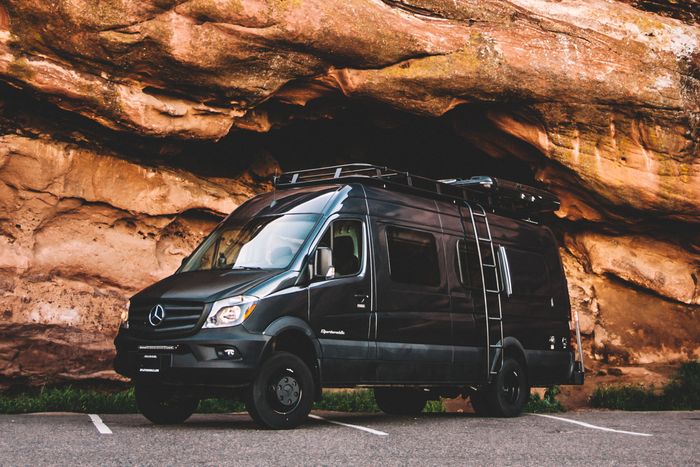
This story was originally published by Curbed before it joined New York Magazine. You can visit the Curbed archive at archive.curbed.com to read all stories published before October 2020.
There’s a lot to love about campers and RVs — that’s why we started a community group just for camper addicts. But even the most enthusiastic camper aficionado can get confused: What makes a Class C different from other RVs? Why is a fifth wheel trailer called, well, a fifth wheel? And are camper vans considered an RV or…something else?
Whether you’re looking to buy a new camper or just want to level up your camper vocabulary, this guide is a good place to start.
In the Recreational Vehicle (RV) world, you’re either towing something, or you’re not. It sounds simple, but that’s the first main distinction. If you’re not towing a trailer, then the vehicle and the living space are on the same chassis and you can always access the interior of your camper when you’re driving.
If you’re towing something, you’re likely pulling some sort of trailer. How much that trailer weighs and how you actually pull it depends on a few factors, and that’s what we break down in this guide. From Class A RVs to the tiniest featherweight trailer , here’s every kind of RV you can find on the road.
Class A RVs: The Biggest Beasts on the Road
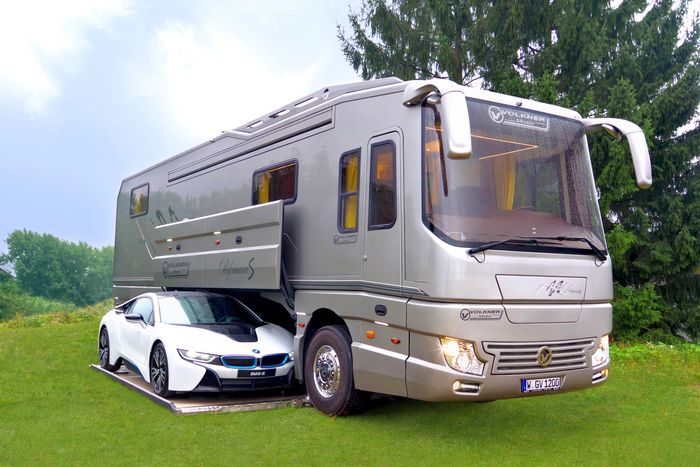
Size: 26 to 45 feet
Weight: 13,000 to 30,000 pounds
Details: The biggest motorized RVs on the market, Class As are like giant homes on wheels. They can be relatively simple or come with all sorts of bells and whistles , including over-the-top amenities like king-size beds, washer and dryers, and mobile garages that can hold a sports car . You get a lot of space with a Class A, and potentially some serious luxury. Another benefit is that you can usually tow a car behind a Class A. But Class As can also be very expensive, have low fuel efficiency, and are limited on where they can travel due to their size and hookup needs.
Class C RVs: A Mid-Size Option
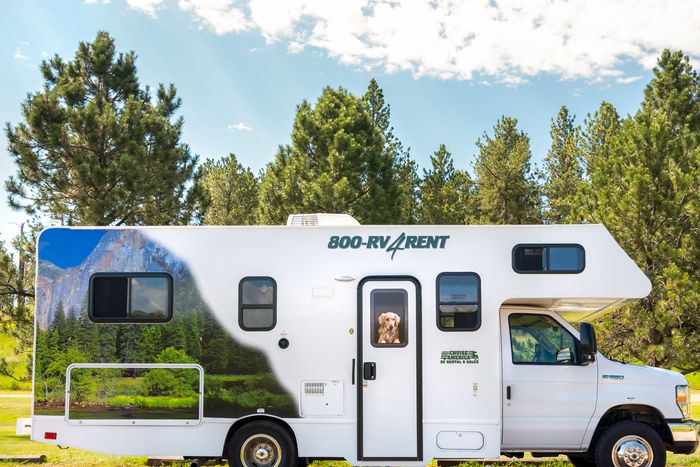
Size: 20 to 30 feet
Weight: 10,000 to 13,000 pounds
Details: Not quite as big as a Class A, but not as small as a Class B. Yeah, we know that’s confusing. Sleeping quarters in a Class C are often over the cab with another area in the back, and you might find slide outs similar to those common in larger Class As. Class C RVs usually have a separate bathroom area, whereas a Class B camper van might not. Class Cs work well for people who want something smaller and less expensive than a Class A, but think a camper van is too small. Note that Class C RVs usually aren’t big enough to tow another vehicle.
Class B RVs: Van Life and So Much More
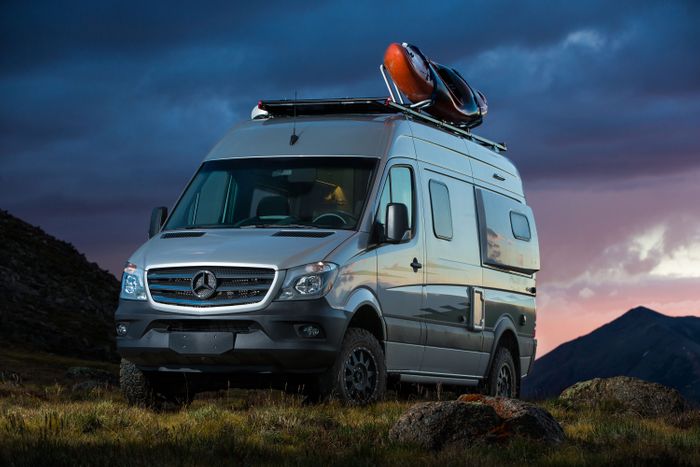
Size: 17 to 23 feet
Weight: 4,000 to 9,000 pounds
Details: Often called camper vans, Class Bs are a mid-size option that are much smaller than the big Class A RVs. Common van bases include the Mercedes Sprinter, Ford Transit, and Ram Promaster , and these small but mighty campers can be basic — think bed and storage — or have extras like bathrooms, dining areas, and room to sleep six . The biggest drawback is that you don’t get as much space or amenities compared to Class As and Cs, but there are also benefits to the Class B; some come in a four-wheel-drive option , get good fuel economy, can fit in many parking spots, can stay off the grid , and are easy to drive.
Travel Trailer: Big, Small, and Everything in Between
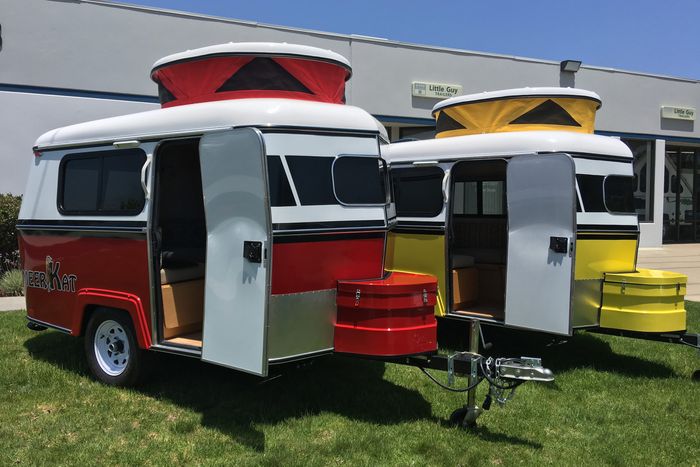
Size: 10 feet to 40 feet
Weight: 1,100 to 12,000 pounds
Details: There’s probably no greater range of campers in a single category than the travel trailer. Bumper pull travel trailers connect to a standard trailer hitch, and they can range from lightweight to fairly heavy. This means that the smallest travel trailers can be pulled by a small SUV, while others might require a large truck. Travel trailers are good for campers who want to unhitch and store the camper more easily when not in use, and a plethora of options means that there is something for everyone. Just how diverse is the travel trailer category? The 10-foot Happier Camper is a travel trailer, and so is the 33-foot Classic Airstream , a trailer that’s more than three times as large. You’ll also see convertible trailers , teardrops , and trailers with vintage style .
Pop-up Trailer: Compact and Easy to Store
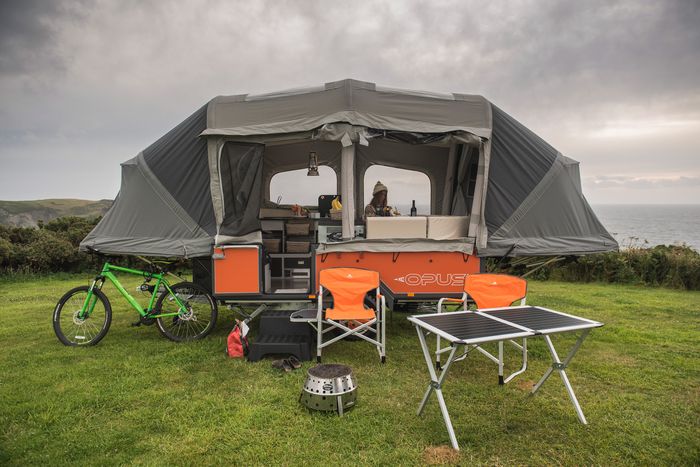
Size: 8 feet to 16 feet
Weight: 700 pounds to 4,000 pounds
Details: Also called a folding trailer, the pop-up trailer is a lightweight camper that folds into itself for easier storage and towing. Think of pop-up trailers as an alternative to a tent, since you get a similar open-air feeling , with a living area in the center and two sleeping areas on either side. Pop-up trailers are great if you don’t mind fewer amenities, can’t tow a lot of weight, and your main goal is to avoid sleeping on the ground. Many are also reasonably priced. The downside? Folding trailers aren’t as well insulated for weather — think of them as three-season camping tents.
Fifth Wheel: The Largest Trailer You Can Buy
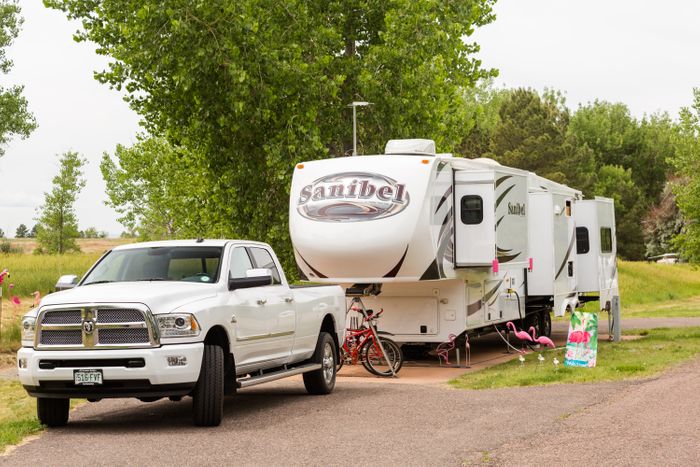
Size: 22 to 40 feet
Weight: 7,000 to 20,000 pounds
Details: Fifth wheel trailers are the largest trailers you can tow behind a vehicle. They are called “fifth wheel” because the front of the trailer extends over the bed of the truck. The truck bed contains the hitching mechanism — a u-shaped coupling component — which can make fifth wheels easier to tow than some other travel trailers since it’s easier to turn. Fifth wheels offer all the space and comforts of a Class A RV — including slide outs, bathrooms, and even multiple bedrooms — but they also require a pickup truck with a specifically fitted hitch. This type of RV is best for someone who wants all the amenities of a large Class A, but wants to tow it and then store it when not in use.
Truck Campers: From Weekend Campers to Expedition-Ready Vehicles
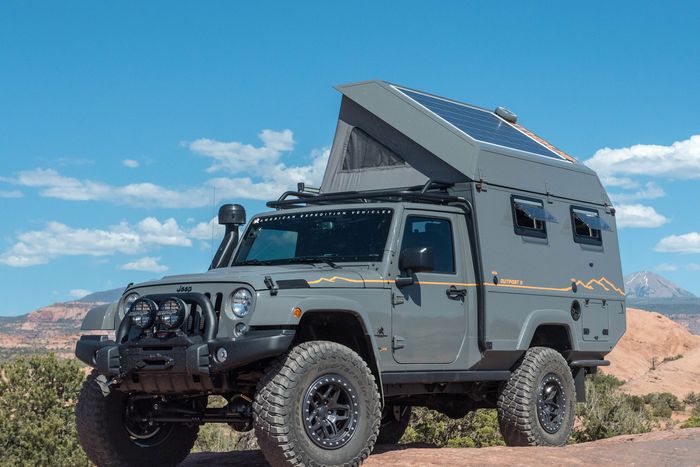
Size: A few feet longer than your truck
Weight: 1,000 to 5,000 pounds
Details: Truck campers like the one pictured above are best for traveling off-the-grid for weeks, months, or even years. This isn’t a camper meant for a large family; it works best for one, two, or a maximum of three people. Four-wheel-drive capabilities and burly suspension mean that these campers can go anywhere but have limited storage and only the most basic amenities. There are also truck campers with more amenities meant for regular campground stays; these often use a rear door and can include an overhead sleeping cabin. Options for truck campers include long and short beds, hard-side and pop up, as well as slide outs.
- corner shop
Most Viewed Stories
- A Greenpoint Condo With a Private Outdoor Pool
- Good Luck Trying to Resell This West Elm Coffee Table
- The City’s Boat-Breakers Get to Work
- A Robert Durst Refresher
- The Biggest, Brightest Apartment in an Old Brooklyn Schoolhouse
Editor’s Picks

Most Popular
What is your email.
This email will be used to sign into all New York sites. By submitting your email, you agree to our Terms and Privacy Policy and to receive email correspondence from us.
Sign In To Continue Reading
Create your free account.
Password must be at least 8 characters and contain:
- Lower case letters (a-z)
- Upper case letters (A-Z)
- Numbers (0-9)
- Special Characters (!@#$%^&*)
As part of your account, you’ll receive occasional updates and offers from New York , which you can opt out of anytime.

Types of Travel Trailers 101: Everything You Need to Know

If you’re considering purchasing a travel trailer, there are numerous options to consider. Travel trailers are adaptable campers that come in a variety of sizes, weights, and configurations. Almost any car can tow at least one type of travel trailer thanks to all of these options. As a result, they’ve become popular among RVers.
The following are the various types of travel trailers:
Classic Travel Trailers
Toy haulers, teardrop trailers, stand-up trailers, pop-up trailers (aka camper trailers).
Different amenities, floor plans, layouts, and dimensions can be found in each of these types. In addition, there are a plethora of different manufacturers to choose from, which can be overwhelming. We’ll go over the pros and cons of each type of travel trailer down the page.
Table of Contents

The term “ travel trailer ” can refer to a variety of campers. There are various characteristics that distinguish one type from another, but let’s start with defining what a classic travel trailer is.
In general, a travel trailer is a camper that is towed behind a car. Standard ball hitches are required, as are weight distribution hitches if the models are particularly long or heavy. Traditional travel trailers are tall enough for people to fully stand up in and typically include mobile living space on the inside. They have firm exterior shells and range in length from 10 to 35 feet.
Specifications vary by model, but many classic travel trailers include a bedroom, a bathroom, a kitchen/dining area, an entertainment center, and built-in storage spaces.
Many classic travel trailers have slide-outs to increase their square footage. When the trailer is parked, these sections are designed to extend outward. Large furniture and kitchen appliances are frequently built into these slide-outs to keep them out of the way of passengers moving around the space.
Classic travel trailers come in a variety of sizes, but they are typically the largest and most luxurious models. While these trailers can be pulled by any car with a high enough towing capacity, the largest travel trailers are usually only pulled by heavy-duty trucks. If you want to buy a classic travel trailer, make sure your tow vehicle can handle the weight before you buy.
I’ve selected a few examples of classic travel trailers for you to look at below. This will give you an idea of what these trailers can offer, as well as what to expect as you continue to explore.
- Unladen Vehicle Weight: 4,273 lbs.
- Hitch Weight: 565 lbs.
- Cargo Carrying Capacity: 3,292 lbs.
Visit their website for more information on this trailer, including other floor plans and more detailed specifications.
Heritage Glen Hyper-LYTE 22RBHL
- Unladen Vehicle Weight: 5,413 lbs.
- Hitch Weight: 570 lbs.
- Cargo Carrying Capacity: 2,157 lbs.
Wildcat MAXX 262RGX
- Unladen Vehicle Weight: 8,847 lbs.
- Hitch Weight: 1,660 lbs.
- Cargo Carrying Capacity: 3,013 lbs.

Toy haulers are travel trailers designed specifically to transport large amounts of cargo, camping equipment, or even small recreational vehicles. These four-wheelers, UTVs, jet skis, and other “toys” are ideal for transporting in this type of camper!
Toy haulers are frequently the same size as traditional travel trailers due to the need to transport large equipment. In some cases, the two can actually combine to form a single unit!
Many travel trailers have a garage in the back or furniture that can be removed or stowed away to make room for extra cargo. This type of layout combines living space and storage space, which is ideal for people who want the best of both worlds.
Almost every toy hauler has some kind of ramp or lift that leads to the garage. This makes it easier for people to load heavy equipment into the back of the truck. This loading gear can then either retract inward or fold against the trailer’s back end.
Toy haulers may be a good compromise for people who want a living space as well as a garage. Because of the large amount of space required by a garage, your elbow room will be even more limited than usual.
To pull a toy hauler, you’ll also need a fairly tough tow vehicle. They’re typically quite heavy on their own, and when you add the weight of additional vehicles and heavy cargo, they become difficult to move. Trucks are usually the best bet for towing toy haulers, but if you have another type of powerful tow vehicle, see if you can find a toy hauler that fits within its maximum weight limitations.
I’ve selected a few of my favorite toy haulers below, including models with integrated living space. Examine them out and see if they appear to be a good fit for you.
Sandstorm T251SLC
- Unladen Vehicle Weight: 7,499 lbs.
- Hitch Weight: 1,055 lbs.
- Cargo Carrying Capacity: 2,500 lbs.
Visit their website for more details on this trailer, including other floor plans and specifications.
Grey Wolf 27RR
- Unladen Vehicle Weight: 5,960 lbs.
- Hitch Weight: 934 lbs.
- Cargo Carrying Capacity: 1,974 lbs.
Ozark 2500TH
- Unladen Vehicle Weight: 4,913 lbs.
- Hitch Weight: 635 lbs.
- Cargo Carrying Capacity: 2,722 lbs.
You might also want to read this: Camping Ice Makers: The Best Portable Ice Makers

Tiny teardrop trailers can be towed by just about any vehicle, making them ideal for weekend getaways. Every part of these has been streamlined and compacted to make them as light as possible. They make the most of a small space and pack in a lot of luxuries and conveniences!
People with small tow vehicles prefer teardrop trailers because they are light and easy to tow. They’re also easy to store in a garage or storage facility during the winter. Here, there’s no need for a special garage!
Due to their small size, teardrop trailers usually lack bathrooms. Mattresses and sofa beds take up the lion’s share of their interior space. However, there are some models that prioritize living space over sleeping space and include a table and a lot of storage.
However, a cooking and meal preparation station is included in nearly every teardrop trailer, allowing you to take your cooking on the road with you. The back of the teardrop can often be opened to reveal a countertop, storage drawers, a mini-fridge/cooler, and other optional kitchen appliances. In many of these setups, an outdoor stove is a given.
Short-term road trips and camping trips are made better with the addition of teardrop trailers. After all, they’re not built for cross-country journeys and can only carry so much cargo! These trailers are surprisingly comfortable for their size, considering they’re so compact.
I’ve selected a few teardrop trailers to discuss in the paragraphs that follow. Consider all your options thoroughly because each teardrop is different from the rest.
Polydrop Trailer Limited Edition
- Unladen Vehicle Weight: 760 lbs.
- Hitch Weight: 80 lbs.
- Cargo Carrying Capacity: N/A
Mean Bean Teardrop Trailer
- Unladen Vehicle Weight: 1,650 lbs.
- Hitch Weight: 200 lbs.
Timberleaf Classic Teardrop Trailer
- Unladen Vehicle Weight: 1,400 lbs.
- Hitch Weight: 150 lbs.
Please read this also: How Tall Is A Typical Fifth-Wheel Camper?
Towing a stand-up trailer is similar to towing a teardrop trailer in that it is a miniature travel trailer that can be towed by a wide range of automobiles.
They’re not teardrop trailers, however, because of the way they’re built and how large they are. Stand-up trailers, in contrast to teardrop trailers, tend to have a more diverse assortment of interior furnishings. People can stand up comfortably in them, which is why they are taller than most teardrop trailers.
For stand-up trailers, there’s no standardized design because each manufacturer creates their own unique model. Some have full beds, while others have bathrooms and kitchens inside. For those times when you need to sleep, many stand-ups have dining and relaxation areas that can be converted into sleeping areas.
Although stand-up trailers aren’t as common as other types of travel trailers, they are worth considering by anyone who is considering purchasing a travel trailer. Teardrop trailers are still small enough to be towed by most types of vehicles, but they also offer a bit more variety.
For your convenience, I’ve gathered a few stand-up trailers. Enjoy!
Little Guy MeerKat
- Unladen Vehicle Weight: 900 lbs.
- Hitch Weight: 100 lbs.
- Cargo Carrying Capacity: (approximately) 1,000 lbs.
5×8 Standy Teardrop
- Unladen Vehicle Weight: 998 lbs.
- Hitch Weight: (approximately) 100 lbs.
ProLite Suite
- Unladen Vehicle Weight: 590 lbs.
- Hitch Weight: 55 lbs.

With their unique design, pop-up trailers bridge the gap between camping in a tent and traveling in a motorhome. During travel, these trailers resemble the classic travel trailers in the most significant way. However, once they’ve been parked, sections of them extend outward. Canvas or other weather-resistant fabric is commonly used to enclose these fold-outs.
The main sleeping areas are usually found in the fold-outs of these trailers. When the trailer is parked, more living space is available because these fold outwards from the rest of the interior. A lot of campers will find this feature appealing!
Pop-up trailers can be divided into two main categories: soft-sided and hard-sided. With canvas sides, soft-sided pop-ups offer better airflow. Camping enthusiasts will appreciate these because of their ability to replicate the open-air experience they get when using them.
On the other hand, the rigid sections of hard-sided pop-ups provide extra protection from the elements because of the way they’re constructed. Because they don’t have canvas coverings, these have more protected interiors. More enclosed than those with soft sides, but less exposed. One of these options may be better for you than the other, depending on your personal camping preferences.
Pop-up trailers are designed to serve as quick and easy campsites, with minimal set-up time. It is common for them to include cooking appliances, either inside or outside, and many have bathrooms and dining areas built into the interior.
Pop-up trailers are a great option for people who enjoy the great outdoors but also want the conveniences of home when they travel. You’ll still need a tow vehicle capable of towing them, even though they’re lighter than most classic travel trailers.
Pop-ups are a great way to learn about this type of trailer. You can see them all right here.
Rockwood Tent 1940LTD
- Unladen Vehicle Weight: 1,608 lbs.
- Hitch Weight: 195 lbs.
- Cargo Carrying Capacity: 683 lbs.
Flagstaff Hard Side Pop-up T21DMHW
- Unladen Vehicle Weight: 2,700 lbs.
- Hitch Weight: 353 lbs.
- Cargo Carrying Capacity: 653 lbs.
Shamrock 233S
- Unladen Vehicle Weight: 5,063 lbs.
- Hitch Weight: 708 lbs.
- Cargo Carrying Capacity: 1,645 lbs.
In terms of appearance and overall design, Airstreams are a distinct type of trailer. There are a variety of sizes and weights available, but all of them have rounded ends. In addition, each airstream has a shiny metallic plating that distinguishes it from the rest of the system.
There are no slide-outs or floorplan extensions in airstreams, unlike in traditional travel trailers. Despite this limitation, these trailers are still able to make excellent use of their available space and provide a pleasant living environment for their occupants.
There are a lot of options when it comes to airstream floor plans, including bathrooms, kitchens, dining areas, and entertainment centers.
These travel trailers require a strong towing vehicle because of their large dimensions. Even the smallest airstreams on the market are still heavy, so keep an eye on their weights when purchasing one.
If you want to buy an airstream, you’ll also need to find a reliable supplier. As a brand rather than just a trailer design, you can only purchase them from authorized dealers and used-car auctions. Because they are less common, the market for Airstreams is also smaller. Airstream continues to sell and release updated models, so there is still a market for those who are interested.
For your perusal, I’ve compiled a list of airstream models below. Don’t be fooled by their superficial resemblance. Their interiors are diverse and well-equipped.
Classic 30RB
- Unladen Vehicle Weight: 7,788 lbs.
- Hitch Weight: 886 lbs.
- Cargo Carrying Capacity: 2,212 lbs.
Globetrotter 23FB
- Unladen Vehicle Weight: 5,297 lbs.
- Hitch Weight: 591 lbs.
- Cargo Carrying Capacity: 1,003 lbs.
Caravel 16RB
- Unladen Vehicle Weight: 3,500 lbs.
- Hitch Weight: 490 lbs.
- Cargo Carrying Capacity: 800 lbs.
Top RV Air Conditioners in 2023

An RV is all about seeing the country in comfort. This necessitates the use of a good air conditioner to keep the interior cool and comfortable on warm, warm, and…
How to Determine the Best Used RV Price

How to Determine the Best Used RV Price It’s that time of year again, and the weather forecast looks promising for camping and RV activities. Looking for a new RV…
How to Purchase an RV

Before you pull the trigger on one of the larger purchases of your life, consider some of these finer points on how to efficiently purchase an RV. Let’s take a…
Best RV Air Conditioner: Top Models for Efficient Cooling on the Go

Traveling in an RV offers the perfect blend of adventure and comfort, but extreme temperatures can compromise the latter. An efficient air conditioner becomes a vital feature, pivotal in maintaining…
All You Need To Know About RV TVs

Because there are so many factors to think about, shopping for an RV TV might be overwhelming. You must first decide on the kind of television technology you want, the…
The Top 5 12 Volt TVs for Your Campervan or RV

What Should a 12V TV for Campervan or RV Contain? (6 Items) You are aware that your campervan or RV needs a TV, but what should you seek for? I’ve…
FAQ: Can RV Air Conditioning Run Continuously?

Can I operate my RV’s air conditioner continuously? Without creating a problem, you can leave the air conditioner on continually in your RV. Set your thermostat a little lower if…
How do you choose an RV air conditioner?

Regardless of the kind of RV air conditioner you pick, make sure to do your homework and read reviews from other RVers before making a purchase. No matter where the…
6 Tips for Making Your RV Air Conditioner Quieter

One of the reasons you travel on vacation to the vast outdoors is to escape the city sounds. Nature is tranquil and calm, and you appreciate the times when there…
Best of Micro Camper Necessities 2023

Best of Micro Camper Necessities 2023 Are you going on your first Micro Camper vacation? Let’s speak about getting ready for an early season adventure in your Micro Camper. It’s…
The Top 5 RV Air Conditioners Units for 2023 (15,000 BTU Rooftop)

In the summer, Vs can become extremely hot. An RV is essentially a metal cage with no inside. The metal box will quickly become warm when left in the sun,…
The Winnebago Micro Minnie: Seven Things You Should Know

One of the most well-known lightweight campers on the road today is the Winnebago Micro Minnie. Thanks to its high-quality building, market-leading features, and a variety of well-designed floorplans. But…
How Long Can You Keep an RV Air Conditioner Running?

A Complete Guide on How Long an RV Air Conditioner Can Run The best time of year to travel in an RV is during the summer. However, you must make…
Leave a Reply Cancel reply

This post may contain affiliate links or mention our own products, please check out our disclosure policy .
The 11 RV Types: a Guide to Understand the Differences
Published on November 20th, 2019 by Brian Newman
Did your excitement to purchase a recreational vehicle end when you became overwhelmed by the choices available in RVs? Don’t feel alone, the array of camper styles on the market today is mind-blowing. Let me help you end “camper confusion” with this comprehensive guide that explains the 11 different RV types available, what items you need for them, the ideal places to take them, and the number of people they comfortably fit.
Read along to learn more about RV types so you can find the perfect camper for you!
The 11 RV Types
Recreational vehicles come in many different styles. Each group within that style has unique benefits and needs. There are campers you drive, campers you pull, and campers made for seasonal or long-term use.
DON’T MISS OUT ON CAMPER SMARTS UPDATES
Sign up for the newsletter today.
Please enter a valid email address.
An error occurred. Please try again later.
Thank you for subscribing to the Camper Smarts newsletter, keep your eye on your inbox for updates.
The following are the RV types I will discuss from smallest to largest:
- Teardrop Trailer
- Truck Camper
- Pop-up Camper
- Hybrid Trailer
- School Bus and Cargo Conversion
- Travel Trailer
- Fifth-Wheel Trailer
Next, I will break down the variations among each group, and any special considerations that apply when using that particular camper.
What Is a Teardrop Trailer?
A teardrop trailer or camper has a compact, lightweight design that derives its name from its iconic teardrop shape. Teardrops are typically small and meant for two adults. Newer models are becoming quite large and offer a full range of amenities found in most standard RVs. Teardrop trailers are aerodynamic and easy to pull, which saves on fuel expenses.
Teardrop trailers are becoming very popular due to their compact size that makes it easy to pull by car or motorcycle.
Teardrop campers are a practical solution for those who want more comfort and protection than using a tent and want a camper that is easy to park, store, and set up just about anywhere. The average length of teardrops is four to ten feet long.
Although some larger teardrop campers have kitchen or toilet options, most do not. You will have to bring a grill for cooking, a 12-volt space heater or heated blanket for chilly nights, and gallons of drinkable water.
These are unbeatable for ease of use on short weekend camping trips. Another great feature is that you can stow your camping gear safely inside, which eliminates the need to pack and unpack supplies every time you wish to camp.
You can even buy a teardrop with rugged tires which enables you to take it to backcountry locations, off the grid, off the road, to the beach, as well as setting up at regular campgrounds.
What Is a Truck Camper?
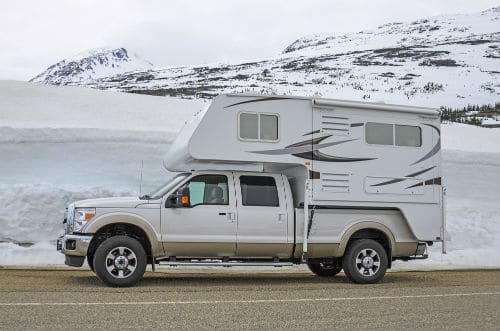
Known to many in the RV community as a “TC”, a truck camper refers to any recreational vehicle that sits in the bed of a pickup truck. These campers can be set down at the campsite and allow you to utilize your truck for sightseeing or trips or shopping. Sometimes people refer to a truck camper as a cab-over or slide-in camper.
A truck camper is a recreational vehicle that you mount temporarily or permanently into the bed of a pickup truck. Models can be bare-bones or feature bathrooms and slide-outs. Most are eight to 12-feet in length.
Truck campers are for those who want to utilize their current truck, yet don’t want to invest in a travel trailer or motorhome. Camping safely with protection from the elements, and being able to have full use of your truck are the most significant benefits to owning a truck camper.
I have seen campgrounds that do not accept truck campers, so keep this in mind and always call ahead to check your status. Of course, this is not a concern if you choose to camp in more remote settings.
Having a portable solar power system in your truck camper is very versatile and allows you to charge phones and use lights anywhere you camp.
Extra tie-downs are a must in the event one of your straps breaks during travel. It also won’t hurt to have a portable water filtration system and composting toilet if you are going off the grid to camp.
Common uses for truck campers are for hunting and fishing expeditions into the backwoods, or anywhere you can drive your truck. Although I’ve seen seasonal campers in them, they are best for trips shorter than a week for one to two people.
What Is a Pop-Up Camper?
A pop-up camper is a pull-behind type of RV that collapses into a compact box for easy transport and storage. A favorite camper for families because when set up, this type of camping trailer folds out to allow a large amount of interior space for sleeping and hanging out. A pop-up camper is an affordable choice for those looking for more comfort and protection than you can get from a tent.
Pop-up campers are any type of fold up tent trailer that collapses into a box for towing and storage.
Between the fancy new designs and the convenience of these units, they are making a resurgence in the camping market. Pop-ups range in length from eight to 16 feet and are towable by most vehicles such as trucks, SUVs, crossovers, sedans, and even some compact cars.
They protect you better from the weather but provide less sound protection or privacy from other campers. Extra space heaters and fans will be necessary to maintain interior temperature control.
You’ll need to carry a supply of repair tape in case the fabric on your pop-out section tears. Plastic totes are handy for clothing and food since there’s no place to store them while the camper is collapsed but on the floor of your camper.
Installing a front trunk on the camper is very beneficial for storing wheel chocks, the winch to raise and lower the roof, and your emergency toolbox.
A pop-up camper is fitting for weekend escapes up to weeklong trips. You can pull them into remote locations, and because they incorporate pull-out bunks, they are exceptional for a couple with one or two small children.
What Is a Hybrid Trailer?
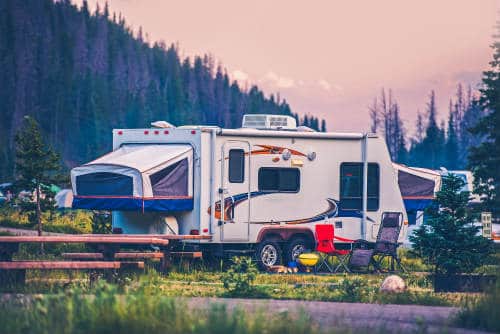
The hybrid travel trailer is a cross between a tent-style camper and a hard-sided travel trailer. The ends of the camper fold out to provide sleeping space. Newer models have pop-outs on the side of the camper to extend the dining area. Since it’s towable by many mini-vans and SUVs, the hybrid trailer is another family favorite.
Hybrid or expandable trailers are conventional travel trailers that have additional tent-type extensions to expand space. The relatively lightweight trailer is attractive for those who don’t want to upgrade to a vehicle with more towing capacity.
Some hybrids have sleeping areas that fold out as you see in a pop-up camper, some have a push-up roof with screen or tent-like sides. Most hybrids include a bathroom and kitchen area, which make them more appealing than a traditional pop-up camper.
Because the bunk ends are screening and fabric, temperature control is difficult. You’ll need to carry fans for summer and space heaters for colder weather.
Hybrids lack in storage space, which means you may have to carry your camping gear like folding chairs, grills, and coolers in your tow vehicle.
The added space of these extensions makes hybrid trailers a good selection for couples with small children to take on backwoods camping trips or to regular campgrounds for weekends or weeklong excursions.
School Bus and Cargo Trailer Conversions
People make conversion campers from an old school bus or a new or used cargo trailer – commonly called a “skoolie”. In a school bus conversion , people retrofit plumbing, appliances, and furniture to make the bus into a spacious RV. A standard enclosed cargo trailer is another option that people transform into a camper. These types of conversions often have issues gaining entry into campgrounds because they aren’t RVIA certified campers.
School bus and cargo trailer conversions are fairly common in the camping world. Both of these types of RV conversions have their positives and negatives, so knowing exactly where and when you will be camping will determine if this is the right option for you.

What Is a School Bus Conversion?
A commercial school bus RV conversion can be bought fairly cheaply and provide lots of interior space to fit a larger family.
The addition of kitchen and toilet facilities, as well as propane heaters, make these appear like traditional RVs on the inside, yet the outside remains looking like a school bus, no matter what color you paint it.
What Is a Cargo Trailer Conversion?
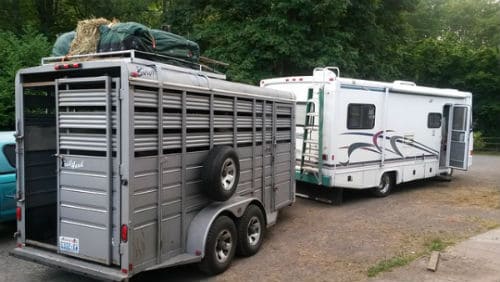
Private people or outdoor companies like to convert plain cargo trailers with living spaces which are becoming popular with campers.
The biggest giveaway the unit started as a cargo trailer is the lack of windows. Most cargo trailer conversions do not bother with bathroom facilities but do have water hookups for a sink. DIY enthusiasts like the customization possibilities of cargo trailers and the ability to control cost expenditures.
School bus and cargo trailer conversions are good for weekend escapes, with longer trips easier to handle as you add more amenities to the interior. Since wiring these for RV types power is uncommon, you will always have to carry a generator or plenty of extension cords to reach any possible power source to run lights or outlets.
The biggest issue with these types of conversions is many campgrounds do not allow them, or only let them in on a case by case basis. That is why these styles of campers are best for off-grid destinations like remote state parks, deserts, and beach areas where rules are more relaxed.
On the bright side, there are many rallies held around the country to show off your school bus conversion.
What Is a Travel Trailer?
A travel trailer is a tow-behind camper that provides the comforts of home while traveling. Sleeping quarters, kitchens, and bathrooms make vacations cost-effective and fun. Also known as a caravan, pull-behind, bumper-pull, or camper trailer, a travel trailer can have the basics for daily needs, or be lavishly outfitted.
Travel trailers have rigid sides that you tow with a pickup truck, SUV, or large crossover via a hitch.
Possibly the most common of all recreational vehicles, there are models to suit just about anyone’s camping needs. From simple units with no slide-outs to units with two, three, or even four slides and tons of amenities are available.
Most travel trailers range from 18 feet to 34 feet long. The longer the trailer, the larger your tow vehicle needs to be to pull it safely. Bumper or frame hitches connect to the tongue of the camper and disconnect at the campsite, for full use of your tow vehicle.
Travel trailers are more like a tiny home , and therefore people expect the comforts of home while camping. That is why you should always carry a 25-50 foot length of coaxial cable to hook up to a park’s TV system.
You should also carry 15, 30 and 50-amp power converters so you can have at least some power if your pedestal’s breakers are faulty, and a sewer donut for a tight wastewater connection if the park does not have screw-in type fittings.
Travel trailers are an affordable choice for a week, month, or seasonal stay at campgrounds for any size group. These are also easy to retrofit for solar power if you choose to camp off-grid for any length of time.
What Is a Class B RV?
A Class B RV or motorhome looks like a sleek oversize van and is sometimes called a campervan. The ceilings are lifted in Class B motorhomes to accommodate a person to stand fully upright inside. These motorhomes are the best on fuel economy and are very easy to drive and park.
I have seen a surge of Class B RVs (often also referred to as Class B motorhomes) in campgrounds and on the road. Class B units are built on a conventional or Sprinter-type van chassis, to which alterations are in the body like a raised roof.
With great gas mileage for an RV, and available in gas or diesel options, Class B RV are easy to park just about anywhere. Regulations classify a van to be a Class B RV when they include:
- A refrigerator
- AC unit and heater
- 110v electrical system
- Cooking equipment
- Water system with sink/shower
These RV types do not offer slide-outs, and you should think of them as a van with amenities. Carrying a spare tire and appropriate tools is critical. Inside space is very limited, so an outdoor table and chair set is also important.
If you have the option of adding an awning to the outside, do it. An awning allows for extra shade to keep your camper interior cooler, as well as protection from light rains when sitting outside.
Class B RVs are the most affordable option in this category of driveable RVs. Due to ease of parking, they are great for constant travel to many places, city or rural. If you are a single or couple looking to explore the country, Class B is a fantastic option.
What Is a Class C RV?
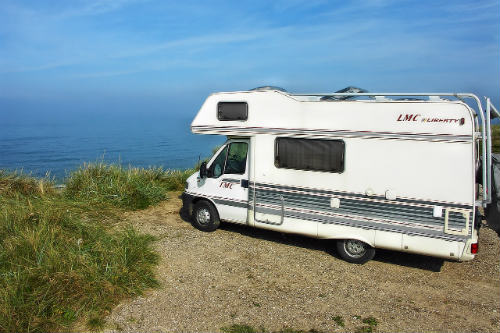
A Class C RV or motorhome is a mid-size recreational vehicle built on a van or truck chassis specifically made to handle the extra weight of the camper framing and interior amenities. The driver’s cab features an overhang that holds a platform for sleeping quarters or extra storage. Most sleep 4-6 people comfortably.
A Class C RV (also referred to as a Class C motorhome) is the most recognizable of all recreational vehicles. Built on a truck platform, it has a front engine with a cab-over above the driver compartment.
Class C RVs can run on gas or diesel and come in lengths from 16 feet to 36 feet. The engine and chassis can allow for additional towing of a vehicle for those who wish to explore an area further after reaching their camping destination.
The cab-over compartment is usually a bed, but can also be for a TV and entertainment system, or added storage. Class C RVs are full of equipment to provide comfort while camping. Refrigerators and freezers, full bathrooms, water heaters , and stoves are standard in most models.
I own this type of camper and can attest to the versatility of this style, but it does have some extras you should always have on hand.
A round bubble level is crucial for leveling the unit. For your fridge and freezer to run correctly and for your shower to drain properly, the RV must be within three inches of level in any direction.
Fortunately, most campground parking pads are within these parameters, but if not, you must always carry leveling blocks to place under tires to level the unit.
Most late-model Class C RVs have hydraulic leveling jacks available that will level up your unit with a push of a button. It will save you hours of stress when trying to set up on an uneven campsite if you can afford the upgrade.
Having a quiet generator will allow you to park at places outside of campgrounds and still have power for making coffee, charging phones, and for lighting.
Class C RVs are great for weekend trips or longer at a campground, or for long road trips around the country. Best for two to four people, which will allow plenty of space for everyone to stretch out.
What Is a Toy Hauler?
A sub-category of recreational vehicle is the toy hauler. Appropriately named, a toy hauler is designed with extra space in the rear of the camper with a fold-down door that turns into a ramp to load an ATV, golf cart , motorcycles, kayaks, or more.
With the front of the toy hauler set up as a traditional camper , it has amenities like a kitchen, bathroom, and bedroom. These are best for those who travel to sports events with their “toys” or like to take their ATVs out to backcountry locations.
Extra straps and tie-downs are a necessity to keep your gear from shifting during travel. A generator that can power the unit’s appliances is also imperative since it’s common for this type of camper to go off-grid.
Toy haulers can be made in Class C, Class A, and fifth-wheel configurations. Many people also transform this additional space for extra bunks for sleeping or as an office.
A toy hauler is excellent for sports enthusiasts who attend ATV, motocross, or motorcycle rallies, and for those who love to fish or kayak.
What Is a Fifth-Wheel Trailer?
Some towable camper trailers use a fifth-wheel configuration hitch that attaches to the bed of a pickup truck, hence the moniker “fifth wheel.” An owner will need a reliable tow vehicle to pull these sizeable campers, buy many people find pulling them to feel much smoother than with a travel trailer. Most fifth-wheels have several slide outs, a large bedroom, and nicely appointed kitchens.
Fifth-wheel travel trailers range in length between 22 feet and up to 45 feet, with the most popular sizes sold in the 32 to 36-foot length. Slideouts are common in the living room, bedroom, and kitchen/dining room area.
Fifth-wheels are made to hitch onto a medium to a heavy-duty truck with an in-bed attachment called a fifth-wheel coupling or gooseneck hitch. Due to the hitch taking up most of the truck’s bed space, it takes away the use of this space for storing camping gear.
Part of the trailer extends over the truck bed, which shortens the total length of the vehicle and trailer combined, which many campers feel is more comfortable to tow . These campers do have interior stairs to reach either the bedroom or living room, so choose a different style of camper if you have mobility issues.
Most fifth-wheel campers have two or three wastewater holding tanks. Having extra lengths of sewer hose is imperative to efficiently reach sewer connections that could be 20-30 feet away from the camper’s sewer line.
A large, powerful generator is another must. If the power goes out, or is not available, running the air conditioner is only possible with a big generator.
Fifth-wheels are the go-to camper for those who want the most in space, amenities, and design, and also want their tow vehicle free for local travel. This camper is great for a week or longer trips for families with kids, or as a seasonal or permanent camper for long-term stays by retirees.
What Is a Class A RV?
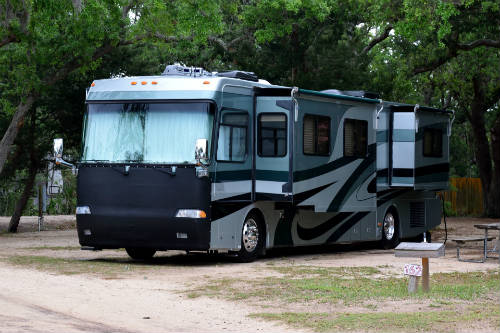
A Class A motorhome or motorcoach starts with a robust commercial truck or bus chassis. Large Class A motorhomes are known to have the worst fuel economy but are very desirable due to first-class design and amenities that make travel luxurious. In some states, you need a special non-commercial license or a commercial driver’s license (CDL) to drive one.
Class A RVs (also referred to as Class A motorhomes) are a driveable recreational vehicle that is built on a commercial truck or bus chassis. Class A RVs are simple to recognize by the flat front end, including large windows.
The Class A can range from 20 to 45 feet in length and feature four or five slide-outs and two to three air conditioners. Amazing amenities inside and out make this RV type the favorite for those who want it all while camping. Because of that, you will need to carry a powerful generator to keep things running smoothly.
Unfortunately, you will also need to carry a supply of caulk and waterproofing tape to deal with leaks that are very common on the top of the slide-outs. You must also consider that these will need all the routine maintenance of a small house, along with that of a vehicle so they can be a lot of work.
Another downfall is that older campgrounds have minimal space for an RV in the 40-45 foot length, and you can strain even a 50-amp electrical service by the appliance demands in the larger Class A campers.
Newer campgrounds usually fit the large campers popular today, so make sure you do your research when selecting your camping destination. Overall, for a retired couple looking for a month-long or seasonal stay or long hauls across the country, this unit will have you traveling in comfort and style.
What Is a Park Model?
A park model RV is a trailer-type recreational vehicle made to provide temporary accommodation for camping, recreation, or seasonal use only. You can transport a park model, but their primary design is for long-term placement at a campground and is a favorite for older “snowbirds” who are tired of driving or pulling a camper to their seasonal camping location. This type of camper, built on a flat-bed trailer, must have under 400-square-feet of interior space or they would classify as a manufactured home and be subject to different taxes and regulations.
A park model is a large travel trailer with a design specific for long-term parking, yet be easy to move between campsites or off-site for seasonal storage.
A park model’s interior layout has more space than most other RV types, with slide-outs adding to the dimensions. A park model usually forgoes wastewater holding tanks in exchange for direct plumbing into the sewer system and feature regular flushing toilets, which is a boon for those used to typical RV toilets.
Park models are prevalent in “snowbird” campgrounds where residents drive or fly to the location, and have no desire to move their camper. Usually, they offer only one bedroom, which limits use to a single or couple.
11 RV Types Conclusion
I do hope this guide has clarified the differences between the types of campers available so you can begin your journey in choosing a recreational vehicle.
Watch the below video for even more details about the different RV types available. Locating the right unit for your specific needs will make your camping experience as stress-free and enjoyable as possible.
What RV type is your favorite and why? Share your thoughts and help others find their perfect camper!
Share this post:
Related posts:.

Why RV Sewer Hose Supports Are a Must-Have: Improving Sanitation & Stability

Safe Camping Near Alligators: Essential Tips and Destinations in the US

Choosing the Best Toilet Paper for RVs: Myths vs. Facts
About the author:.

Brian Newman and his wife joined the full-time RV lifestyle in 2017. Brian has been a freelance writer since 2019 and has a diverse background that includes literature, religion, business, finance & investment, disability, recreational vehicles, and U.S. history.
2 thoughts on “The 11 RV Types: a Guide to Understand the Differences”
Interesting article. I had no idea there were so many different types of RVs.
So many! My favorite is the teardrop camper – hadn’t heard of this one before
Leave a Comment Cancel reply
Welcome please follow these guidelines:.
- Be kind and respectful.
- Keep comments relevant to the article.
- Avoid insults, threats, profanity, and offensive remarks.
- Refrain from discussing gun rights, politics, or religion.
- Do not post misleading information, personal details, or spam.
We may hide or remove comments at our discretion.
I have read and accepted the Comment Guidelines and Privacy Policy *
Follow Camper Smarts:
- Follow Us On Facebook
- Follow Us On Twitter
- Follow Our Pins
Motorhome Classes
Travel Trailer
- Fifth Wheel
- Pop Up Camper
- Teardrop Camper
- Hybrid Camper
- Truck Camper
- RV Manufacturers
- Best RV Brands
- Buying An RV
- Backup Camera
- Electric Trailer Jack
- Portable Generator
- Portable Refrigerator
- Portable Solar Panel
- RV Power Cord
- RV Surge Protector
- RV Vent Fan
- RV Camping Chair
- Camping Table
- Portable Dog Playpen
- Propane Fire Pit
- RV Leveling Block
- RV Patio Mat
- RV Wheel Chock
- Wood Burning Fire Pit
- Portable Camping Toilet
- RV Black Tank Treatment
- RV Macerator Pump
- RV Portable Waste Tank
- RV Sewer Hose
- RV Shower Head
- RV Toilet Paper
- RV Water Pump
- Towed Vehicle Braking System
- Weight Distribution Hitch
- 12-Volt Air Compressor
- Collapsible RV Ladder
- Discount Camping Club
- Good Sam Club Membership
- Portable Propane Heater
- RV Mattress
- RV Step Cover
- Quick Reviews
- Full-Time RV Living
- RV Upgrades
- RV Boondocking
- Public Lands
- Overnight RV Parking
- Amazon Storefront
- Must-Have RV Accessories
- Travel Trailer Accessories
- Pop-Up Camper Accessories
- RV Kitchen Accessories
- Luxe RV Accessories
- Gifts For RV Owners
- RVers Online University
- Talk To RV Mechanic
- About Camp Addict
- Events & Press
- Camp Addict
- 🏕️ RV Types
Ultimate Guide To RV Types: Demystifying RV Classes
By Marshall Wendler
Figuring out the difference between RV types is a confusing endeavor.
What's a motorhome? What's a travel trailer? How do you tell the different RV styles apart?
On this page, we answer the question, 'What are the different classes of RVs?'
We'll cover the basics of the different RV classes, giving you a high-level overview of what's available in recreational vehicles.
You're about to have a head full of knowledge, and by the end of this, you will have a basic overview of the different types of RVs available today.
Bring All The Toys!
- Build quality can vary wildly between manufacturers. Read our top rated RV article to find out who makes the best quality RVs.
Definition Of RV
If you have ever wondered what the word RV means, we will answer that question. RV means Recreational Vehicle. In other words, 'RV' is an abbreviation for 'Recreational Vehicle.'
Another great mystery is solved. You are welcome!
Now onto what are the different types of recreational vehicles
Motorhomes are motorized RVs that don't require another vehicle to propel them down the road. They are broken into different 'classes,' which describe their basic size and shape.
Here are the three different motorhome classes :
Class A : This is your basic box on wheels (The shape that probably comes to mind when you think 'motorhome').
Class B : This is a van conversion, which starts its life in one form or another as a van.
Class C : This is also a box on wheels but has the nose (front end) of a full-sized van or a pickup truck.
Keep reading to learn in more detail about the different types of motorhomes.
Class A Motorhomes
Class A motorhomes may be what you think of when you think 'motorhome.' It's the traditional rectangular box on wheels that is common on roads and in campgrounds.
This type of motorhome offers the most interior space of all motorized RVs, with more storage capability than any other type of RV.
Often chosen as the best RV to live in , Class A motorhomes come in lengths ranging from about 28 feet to 45 feet and interior furnishing levels from the spartan to rivaling luxury condos, complete with washers and dryers.
Class A Motorhome
This class of RV starts life as a bare chassis. Next, the fiberglass 'box' is built onto the chassis.
There will be either a gas engine (lower cost) or a diesel engine (more expensive), a single rear axle (shorter rigs), or a dual rear axle (longer RVs).
If you are looking for a motorhome with lots of living space and exterior storage, multiple seating areas, and a tall, commanding view, the Class A may suit you.
Class A Motorhomes In-Depth
- Learn more by reading What Is A Class A RV? where we go in-depth on everything you want to know about these type of campers.
Who Makes Class A's? Which Brand Is The Best?
- Who makes Class A motorhomes? Find out by visiting our list of Class A RV manufacturers .
- Which brand is the best? Find out by visiting our list of the best Class A motorhome manufacturers .
Class B Motorhomes
Class B motorhomes are also known as van conversions. They are built using a bare van body with RV components installed inside.
The result is a small, fully self-contained camper that can navigate urban areas and camp out in the wilderness.
Class B Motorhome
Another take on this class of RV is the Class B+ motorhome. Instead of using a complete van shell as the starting point, a Class B+ uses a cutaway van chassis (just the van's front cab with a 'bare' van frame behind).
A more traditional RV 'box' living area is built from the ground up on the bare frame portion of the cutaway chassis, resulting in a broader, roomier space while keeping the shorter overall length.
Class B Motorhomes In-Depth
- Learn all about camper vans by reading What Is A Class B RV? where we go in-depth on everything you want to know about these motorhome styles.
Who Makes Class B's? Which Brand Is The Best?
- Who makes Class B motorhomes? Find out by visiting our list of Class B motorhome manufacturers .
- Which brand is the best? Find out by visiting our list of the best Class B motorhome manufacturers .
Class C Motorhomes
Class C motorhomes are a type of recreational vehicle that is built on a van cutaway chassis. It means it has the van's cab (driver's compartment) and the living quarters built behind it.
This type of camper is great for someone who wants to have a drivable rig sized right to make it easier to maneuver.
Class C Motorhome
Class C RVs come in either gas or diesel engine versions and range in size from mid-20 feet ( compact Class C RV ) to mid-30 feet in length.
This RV category is excellent if you don't want to tow a trailer but don't need some monster motorhome.
Class C Motorhomes In-Depth
- Learn more by reading What Is A Class C RV? where we go in-depth on everything you want to know about these motorhome types.
Who Makes Class C's? Which Brand Is The Best?
- Who makes Class C motorhomes? Find out by visiting our list of Class C RV brands .
- Which brand is the best? Find out by visiting our list of the best Class C motorhome manufacturers .
Types Of RV Trailers
The most diverse and popular camper types are the towable RVs or trailers.
RV trailers require another vehicle (the tow vehicle) to pull it to your destination.
Once you have arrived at your campsite, towable RVs will be disconnected from the tow vehicle, which then can be used to explore the area you are staying in.
There are two main travel trailer classes - the bumper pull trailer and the fifth wheel.
Bumper Pull Trailers
Bumper pull travel trailers are broken down into different camping trailer types - the traditional travel trailer , the pop-up trailer , the hybrid travel trailer , and the teardrop trailer .
Because they come in such a wide range of sizes and price ranges, bumper pulls are the most popular of the different types of recreational vehicles.
They all have one thing in common.
They attach to the rear (bumper area) of the tow vehicle using an anti-sway hitch .
Following is an explanation of the different options bumper pull travel trailer class:
Travel Trailers
Travel trailers are the traditional box on wheels that are towed behind another vehicle. Once you arrive at a campsite, you unhitch the trailer and have a 'normal' vehicle to drive around as you explore.
Sizes range from short rigs with minimal comfort items to 30+ foot long campers with multiple slide outs with plenty of living space for a large family.
Because of their relatively low cost, this type of camper is an excellent choice for someone looking for a low barrier of entry to get into RVing yet has all the amenities you need while camping.
Travel Trailers In-Depth
- Learn more by reading What Is A Travel Trailer? where we go in-depth on everything you want to know about this type of camper.
Who Makes Travel Trailers? Which Brand Is The Best?
- Who makes travel trailers? Find out by visiting our travel trailer manufacturers list .
- Which brand is the best? Find out by visiting our list of the best travel trailer manufacturers .
Pop-Up Trailers
Pop-up trailers do just what their name states. They pop up. The top half pops up when you are setting up camp.
A pop up camper expands when the space is needed, and it collapses when it's time to move locations or when storing the RV.
Pop-Up Trailer
When in towing position, these types of camper trailers are lower and more aerodynamic, making them easier to pull.
They are lightweight because the walls are canvas. Almost any car can tow one due to its small size and lower weight of a pop up camper .
This is one of the more affordable camper trailer types and is best for people who don't want to tent camp but aren't ready to buy a regular RV.
Because these are small recreational vehicle types, they may not come with toilets and showers but will give you a comfortable place to sleep and get out of the weather.
Pop-Ups In-Depth
- Learn all about these types of towable campers by reading What Is A Pop-Up Camper? where we go in-depth on everything you want to know about them.
Hybrid Travel Trailers
A hybrid travel trailer is one of the more interesting camper classes. They combine many of the features of a conventional travel trailer with the added benefits of increased sleeping areas from pop-out areas similar to what you'll find in a pop-up camper.
Hybrid Travel Trailer
They allow more people to sleep in a given length of trailer, which means you can bring a larger family on a camping trip without having to haul around some long towable RV.
However, the pop-outs only have canvas/fabric walls, so they offer little protection from the elements and certainly lack the privacy you may enjoy in a more traditional trailer.
Hybrid RVs In-Depth
- Learn more by reading What Is A Hybrid Travel Trailer? where we go in-depth on everything you want to know about this kind of RV.
Teardrop Trailers
Teardrop trailers stand out from the other classes of RV trailers by having a very distinctive, teardrop aerodynamic shape to them.
Teardrops come in all different sizes, with smaller teardrops being little more than a dry, safe place to sleep, while larger ones offer all the amenities of a traditional travel trailer.
Small Teardrop Trailer
Some have no cooking facilities, while others offer an outdoor kitchen accessible by opening up the rear clamshell hatch. Bigger teardrops have inside kitchens just like a 'normal' camping trailer.
Smaller rigs have no bathrooms, while larger ones can have a bathroom complete with a toilet and shower.
Teardrops In-Depth
- Learn more by reading our blog post titled What Is A Teardrop Camper? where we go in-depth on everything you want to know about this type of RV.
Who Makes Teardrop Trailers? Which Brand Is The Best?
- Who makes teardrops? Find out by visiting our list of teardrop camper manufacturers .
- Which brand is the best? Visit our list of the best teardrop trailer manufacturers to find out.
- Check out our page on the best teardrop trailers to see a great selection of these small RVs.
5th Wheel Trailers
5th wheels are a type of towable RV that attaches to the bed of a pickup truck.
A 5th wheel trailer is one of the more popular types of camping trailers for full-time RVers and those who like to have plenty of interior space while on the road.
Fifth Wheel Trailer
Because part of the trailer is over the bed of the tow vehicle, the overall length when towing is less than a bumper pull trailer of comparable size.
However, fifth wheels are often taller than regular travel trailers, making for a formidable vehicle going down the road.
The front living area will be elevated from the rear, requiring you to go up and down steps while inside, unlike all other type of RVs.
5th Wheel Trailers In-Depth
- Learn more by reading What Is A Fifth Wheel Trailer? where we go in-depth on everything you want to know about 5th wheels.
Who Makes 5th Wheels? Which Brand Is The Best?
- Who makes 5th wheel trailers? Find out by visiting our fifth wheel manufacturer list.
- Which brand is the best? Find out by visiting our list of the best 5th wheel manufacturers .
Toy Hauler RVs
Toy haulers are arguably the most unique of the RV categories in that they have garages you can store outdoor playthings. ( What is a toy hauler? )
The smallest toy hauler is no more than a short towable RV with a large access door to a cargo area that allows you to put in a bicycle or small watercraft. The largest is a monster beast capable of having at least one off-road vehicle or multiple dirt bikes.
Travel Trailer Toy Hauler
Class A Motorhome Toy Hauler
Toy haulers come in three RV types: Toy hauler motorhomes , travel trailer toy haulers , and fifth wheel toy haulers .
Typically a toy hauler will have a rear access ramp that comes down to allow loading of the garage.
Toy Haulers In-Depth
- Learn more by reading What Is A Toy Hauler? where we go in-depth on everything you want to know about these different RV types.
Who Makes Toy Haulers? Which Toy Hauler Is The Best?
- Who makes toy haulers? Find out by visiting our toy hauler manufacturer list .
- Which brand is the best? Find out by visiting our list of the best toy hauler manufacturers .
Truck Campers
Truck campers are types of RVs that sit inside a pickup truck bed, making for an excellent compact recreational vehicle.
Because they don't have a massive interior space, they are not among the most popular RV class types for long-term camping adventures.
However, their overall short length (not much longer than the truck) means they are relatively easy to maneuver and let you access campsites and areas that larger recreational vehicles would have difficulty getting to.
There are two types of campers - the slide-in camper and the pop-up camper.
Slide-In Truck Campers
A slide-in camper is a hard-sided RV that sits in a truck bed. They offer all the basic amenities of larger RV sizes and types in a compact package.
Slide-In Truck Camper
Due to their small size, they don't have an abundance of storage space (or room in general), and their holding tanks tend to be smaller.
A slide-in camper can be removed from the truck bed at a campsite, allowing you to use your vehicle normally.
Pop-Up Truck Campers
Pop-up truck campers serve the same primary purpose as their slide-in camper counterpart but have the advantage of lighter weight and a lower overall height when in travel mode.
Pop-Up Truck Camper (Open Position)
Pop-Up Truck Camper (Closed Position)
The roof of this type of camper moves up to increase interior room while in 'camp mode' and lowers down while in 'travel mode.' It can do this because part of the sidewall is made of canvas material.
These are designed for camping way down off-road trails or when you need a lighter, more overall compact camper .
Truck Campers In-Depth
- Learn more by reading What Is A Truck Bed Camper? where we go in-depth on everything you want to know about the two different camper styles.
Who Makes Truck Campers?
- Who makes truck campers? Find out by visiting our truck camper manufacturer list.
Frequently Asked Questions
What is the most popular rv type.
The most popular RV type is the travel trailer. These types of pull behind campers sell the most each year and come in a wide variety of sizes and price ranges.
What Type Of RV Is The Easiest To Drive?
The easiest type of RV to drive is the Class B motorhome. Also known as camper vans, these compact vehicles usually are no more than 22 feet in length and drive much like a regular full-sized van.
What Are The Different Types Of RV Classes?
There are five basic types of RV classes: Motorhomes, bumper pull trailers, 5th wheel trailers, toy haulers, and truck campers.
What Is The Biggest Type Of RV?
The biggest type of RV is either the Class A motorhome or the 5th wheel trailer, and both can come in lengths of 45 feet (or longer).
What Is The Smallest Type Of RV?
The smallest type of RV can be broken down into motorized or towable. They are the Class B motorhome (van conversion) and the teardrop trailer.
That was a ton of information about the different types of campers available.
Hopefully, now you know more about which of the RV classifications is best for your needs.
Most anyone can find the right (or good enough) rig among the RV classes explained above.
Understanding the different RV classes can be difficult when you are entering the world of recreational vehicles. Still, the above should have given you a basic understanding of the different kinds of RVs.
Now go out and see some in person.
Nothing compares with walking through a few of the classes of campers to get an idea of what makes a quality RV and to find one that is right for you.
Author: Marshall Wendler
As the co-founder of Camp Addict, Marshall Wendler is a seasoned expert in the world of RVing, with years of hands-on experience living the full-time RV life in his travel trailer. From 2014 to 2020, Marshall learned the ins and outs of the lifestyle and has enjoyed sharing his knowledge and expertise with others. After a brief hiatus as a part-time RVer in 2021 and 2022, Marshall is back on the road full-time, embracing the vanlife and all the exciting possibilities it brings. He particularly enjoys the freedom and flexibility of boondocking and is excited to share his technical insights with the Camp Addict community. Whether you're a seasoned pro or new to the RV world, Marshall has valuable insights and information to share, and is here to help you navigate the exciting world of RVing with confidence and ease.
Hi Marshall, just discovered your site, I`ve been camping for at least 25 years, going up the ladder we started tenting to pop up trailers and going on, we now own a fifth wheel Flagstaff 524 RLS, we retired and we want to travel quit a bite once of course the COVID is over and done with. We are now looking at a smaller travel trailer, 20-22 feet with one pull out and 2 axels. We want something comfortable but not too big, we are presently looking at Rockwood mini lite 2205S or the equivalent Flagstaff micro lite 22FBS. I was told to be very carefull with the lite models, they could be very fragile, do you have any recommendations? Regards, Benoit Lance
I’m glad you discovered Camp Addict!
While I don’t have any specific recommendations for a lightweight travel trailer (it’s on my to-do list, just hasn’t been done yet), we do have an article about the best RV brands .
I’m not sure it’s fair to say that lightweight trailers are fragile. What I think is fair to say is that if you buy any RV from an RV manufacturer that produces junk RVs, you stand a greater chance of having issues. Doesn’t matter if the RV is in the ‘lightweight’ category or a ‘normal’ weight RV.
So investigate the better RV brands, see what they offer as far as lightweight (or lighter weight) trailers, and see if you find something that fits your requirements.
You stack the odds in your favor by purchasing a rig built by a quality manufacturer. This doesn’t mean you won’t have problems, it must means you are less likely to have problems.
Happy RV hunting!
Hi Marshall Really enjoying your site. I am a total Newbie. I saw your top 5 Class A picks. I am curious if there are any “Runner-Ups” so to speak. The top five are somewhat hard to find and expensive. Is there any one or two of the rest of the pack that are tolerable? Or, are there any one, two or so of them to REALLY stay away from?
I’d suggest you purchase one of the top RV brands used. Heck, I’d suggest any RV you purchase be used. But best go with a top brand.
There are a lot of brands you should stay away from. As in most of them!
Join the RV Consumer Group and see which brands are among the better ones. The ones that we didn’t include.
Educating yourself is the smartest investment you can make before buying an RV. Knowing how to tell good from not so good will save yourself a lot of potential grief down the line. 🙂
Quite comprehensive for a newbie like me. We recently bought a bumper pull – and are very happy with our purchase – but it was enlightening reading about all the other options.
Congratulations on your new RV! We hope it serves you well. Thank you for taking the time to send us the kind note about the post. : D
RV types can be confusing. Glad to hear this helped you out a bit.
Is there a camp trailer NODEL RIVERSIDE
Hi Phillip,
There is a Riverside RV that makes travel trailers, including a retro line. I’m not aware of any “Nodel” trailers though.
Session expired
Please log in again. The login page will open in a new tab. After logging in you can close it and return to this page.
Choosing the Right Travel Trailer Sizes for Your Next Adventure
You’ve been looking at buying an RV for a while now. You’ve settled on a travel trailer , but that’s still a big category to choose from. Like every home, every trailer is unique. Understanding different travel trailer sizes and types is going to narrow down your search even further, so you can find the perfect fit for your needs.
Key Takeaway
- Travel trailers vary in size from 8 feet to over 40 feet , with average lengths between 20 to 28 feet . The size dictates the living space, amenities, and the type of vehicle required for towing.
How to Choose the Right Travel Trailer Size for You
Selecting the ideal travel trailer size isn’t a universal choice. You have to assess your own needs and wants based on…
- What Are You Going to Use It For?
If you plan on traveling to remote places down dirt roads and around windy mountain roads, then you’ll want something maneuverable . If you’re traveling to campgrounds, then you want to consider any length restrictions that RV parks have .
- What Style Do You Prefer?
Choosing the right travel trailer size isn’t just about length and width. You need to consider what style of camping you prefer. Do you like to cook your meals indoors or outdoors? Do you prefer to spend all your time outside and use your camper solely for sleeping? Are you planning on living in your RV full-time?
- How Many People Does It Need to Accommodate?
Are you bringing your family, your hunting buddies, ski mates? It’s more than just who you’re bringing, but what accommodations do they need? Do they require privacy and separate rooms or is everyone good with sleeping in the same space?
- Are You Hauling Smaller Recreational Vehicles With Your Camper?
Do you like to bring dirt bikes, four-wheelers, paddleboards, kayaks? Those toys count against your GVWR, so keep them in mind.
- What Terrain Do You Plan to Travel?
Make sure the trailer you choose can stand up to the trails you take it on. You can take trailers off-road, but you need a camper that can absorb the bumps.
- What’s Your Vehicle’s Towing Capacity?
Your current vehicle’s tow capacity is how much weight you can safely tow . So if you have a Gross Combined Vehicle Weight Rating ( GCVWR ) of 10,000 lbs and your vehicle weighs 2,000 lbs, then you can tow a trailer weighing up to 8,000lbs.
- How Do You Plan to Store Your Trailer?
Do you have enough space on your property? Or do you need to find storage? If you need more storage space than you have, then you can look at renting a storage place with something like Neighbor .
Neighbor is a peer-to-peer storage marketplace where you can find safe, affordable RV storage close to home.
- How Much Are You Looking To Spend on Your Travel Trailer?
It’s easy to go looking and forget that your budget is limited. So decide on a good price range for you to narrow down the selection.
To help you think through these questions, let’s look at different types and sizes of travel trailers.
What Are the Different Travel Trailer Sizes?
Travel trailers range between 10-40 ft. Average RV lengths are between 20 to 28 feet. That means there’s a perfect fit for you, so let’s find it!
How Neighbor is changing RV storage
Transparent monthly savings.
Renters save 30-50% on RV storage, on average. No rate hikes.
Keep your RV nearby
25,000 locations means that your RV is always close by.
Storage made simple
Don't settle for stone age tech and long contracts. Neighbor makes it easy.
Micro or Mini Travel Trailers
Mini or micro trailers are a minimalist’s dream. They measure between 10 to 14 feet and are easily towed by smaller vehicles like crossovers and SUVs.
These are best for a quick getaway with your significant other (sleeps 2-3) or if you prefer a minimal approach to camping – without having to sleep on the ground.
Here are some examples for inspiration:
- Earth Traveler’s T300
- Kodiak Stealth
Small Travel Trailers
Small travel trailers include a small kitchen, air conditioning, and sometimes a wet bath. They range from 14 to 20 feet and provide room for 2-4 people to travel comfortably.
Because these trailers tend to weigh over 2,000 lbs , you’ll need an SUV or pickup truck to tow a trailer of this size.
- Meaner Bean – Off-Road Trailer
- Alto R1713 Travel Trailer
- Airstream Flying Cloud 27FB Floor Plan
Mid-Size Travel Trailers
Mid-size travel trailers ( 21-35 ft ) come with all the basic amenities and offer more space and sleeping accommodations for families. These trailers provide amenities such as:
- Multiple sleeping areas
- A separate bedroom
- A full kitchen
- A dining area
- An entertainment center
To tow these trailers, you need a tow vehicle that can tow over 6,000 lbs .
- Ozark 1900THK
- 2021 Autumn Ridge Travel Trailer
- Seabreeze Limited New
Large Travel Trailers
Large travel trailers, like fifth wheels , require a heavy-duty tow vehicle with more power that can safely tow 10,000+ lbs. If you’re planning a long road trip or even living in it full-time and you want more living space, large travel trailers are the way to go.
These recreational vehicles typically measure between 35-40+ feet in length , and they come with all the comforts of home. The largest trailer that you can buy has a total length of 40 ft 7 in .
Now be careful committing to one of these big boys because some campsite regulations don’t allow for them. Also, to tow large trailers, you may need a fifth-wheel, hitch, or gooseneck.
- Cherokee 324TS
- Winnebago Voyage 3438RK
- Solitude | 376RD
Save up to $1,200/year on RV storage & parking
Popular travel trailer types and camper sizes.
The variety of campers available is one thing that makes RVing appealing to an eclectic range of people. Each camper type has its own unique features and size ranges, catering to different traveler needs.
Teardrop Trailers
Teardrop trailers are:
- Small, stylish, and lightweight
- Offer basic amenities
- Easy to tow by small vehicles
The hallmark of a teardrop camper – other than its shape – is that the kitchen space is in the trunk area of the camper. So you sleep inside the body of the teardrop, and then you get out of the camper to access your kitchen.
A-Frame Trailers
Image courtesy of RV Share
A-frame trailers are easy to set up and light enough for crossovers to tow. They’re narrow, fit into a compact space, and are mainly designed for sleeping and light food prep for one or two people.
Travel Trailer
Travel trailers are the most common choice among travelers. They vary in size and configuration from 10 to 40 feet and provide a mix of comfort and convenience. Travel trailers include a:
- Full kitchen
- Sleeping and dining areas
- Storage space
- Heating and air conditioning
- Complete water and sewage systems
There’s a lot of variation on the market, so you’ll be sure to find the size and configuration that suits your needs.
Fifth-Wheel Trailers
Fifth-wheel trailers are spacious, luxurious, and heavy . That’s why they use a gooseneck hitch . They typically measure between 21 to 40 feet.
They are an excellent option for full-time RVers because of their spacious living area, full-sized bathroom, optimal storage, and home-like amenities.
Toy Hauler Trailers
Toy hauler trailers have a built-in cargo area specifically designed to carry a separate recreational vehicle – like an ATV. They come in various sizes and offer versatility for camping trips.
Toy haulers typically have convertible beds/sofa units. When traveling, the bed can be lifted to the ceiling to create space for the toys, then lowered for use once the toys are unloaded.
Choosing the right travel trailer size is a journey in itself. Once you’ve reconciled your wishlist items with your budget restrictions, you’ll be well on your way to finding the right travel trailer at the right size and the right price.
While shopping, do your best to savor the buying process . Go to an RV show. Look at everything from sport utility trailers to truck campers, so you can pick the right travel trailer size for your next adventure.

Related Posts
Choosing your adventure rig: travel trailer vs toy hauler , the 5 best travel trailer brands to buy, comparing 5th wheel vs. travel trailer: what’s the difference, making the right choice: rv vs. trailer, top picks for 2024: find the best teardrop camper for your adventures.
- RV Ownership
RV Dimensions: Length, Width, and Height Explained

Justin earns $650/mo on Neighbor. Find out how you can too!
Stay in the loop ↓

Average Length of Travel Trailers – Yes It Matters
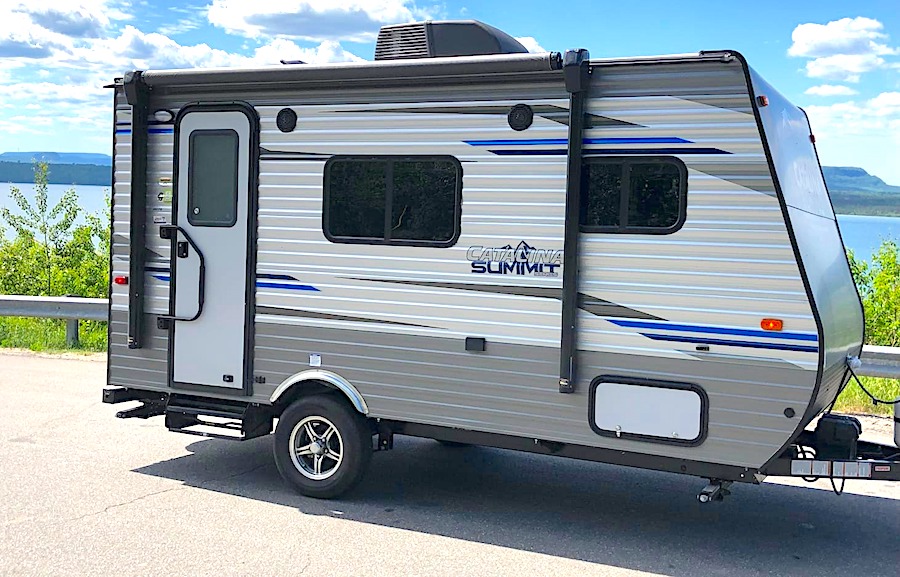
Sharing is caring!
Thanks for your support! If you make a purchase using our links in this article, we may make a commission. And, as an Amazon Associate, I earn from qualifying purchases. See the full disclosure here .
Is there such a thing as an average travel trailer length? Mathematically speaking, yes, it’s about 30 feet. But you can always average out numbers, so let’s do some checking into why travel trailer length might matter to you.
Susan and I are considering buying a travel trailer and we were discussing how long it should be. We want it to be big enough for us to live in comfortably, yet small enough to tow easily. We also want to make sure it fits into most campsites. But the number one thing we kept coming back to was the length of the travel trailer.
Of course, we will go through Outdoorsy to find our travel trailer rental. They have a great platform that makes renting an RV easy and hassle free.
Is There a Maximum Travel Trailer Length?
The maximum allowable travel trailer length is determined by each state. I took a look at the lengths allowed in states throughout the USA and averaged out the travel trailer length as a whole. The number I came up with was 41 feet – sounds like a large travel trailer, right? Let’s look at a few state-by-state numbers, however, as examples. Please note, “total length” means the length of your travel trailer and vehicle combined.
- Alabama: Total length: 57 feet – Travel trailer: 28 feet, 6 inches
- Colorado: Total length: 75 feet – Travel trailer: 45 feet
- Florida: Total length: 65 feet – Travel trailer: 48 feet
- Iowa: Total length: 65 feet – Travel trailer: 45 feet
- Louisiana: Total length: 65 feet – Travel trailer: 30 feet
- New Mexico: Total length: 65 feet – Travel trailer: 40 feet
- Texas: Total length: 65 feet – Travel trailer: 28 feet, 6 inches
- Wisconsin: Total length: 70 feet – Travel trailer: 48 feet
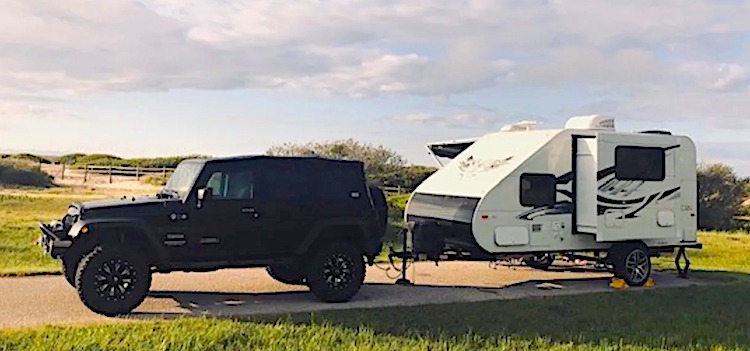
Since many RVers travel throughout the United States, it leads one to believe that states tend to not be overly strict with the length of RVs. How could they be if you are traveling with your 35-foot travel trailer from Florida into Louisiana or Alabama?
The total length combination seems to be a more reasonable length to adhere to for obvious safety reasons while making one’s way across the USA. However, keep in mind that each state does have specifications regarding tow vehicle and motor home lengths.
Several websites discuss state requirements and laws. One such site you can use as a good resource is RV Trip Wizard which lists length height and width for travel trailers in every state. We are an affiliate of RV Trip Wizard and love their trip planning software because you can enter the exact dimensions of your RV into the program. RV Trip Wizard will then plan your trip route so you fit everywhere you want to go!
We learned the hard way that Waze or GoogleMaps will not work to plan the best route when driving an RV. We actually got stuck at a bridge we could not drive under in rush hour traffic in the North East! Yikes! Anyway, we highly recommend RV Trip Wizard not only because you can enter the size of your RV but also because it is the BEST trip planning tool we have found. We absolutely think it is awesome and you will too. Just click on any of our RV Trip Wizard links to check it out for yourself.

Typical Travel Trailer Lengths
Listed below is a variety of travel trailers on the market today. You’ll find that, as with any RV, you can choose from tiny to ginormous when it comes to the size that suits your wants or needs. These examples are a fragment in the world of travel trailers.
It’s best first to determine what you feel most comfortable with towing, the weight your tow vehicle will accommodate, and you and/or your family’s needs. You will have more than enough to choose from when shopping.
From the list below, you’ll see there is no such thing as a “typical” travel trailer length. The sampling of travel trailers below range in an overall length from 9 ½ feet to 42 feet. The world of travel trailers is yours for the taking.
- The Osprey by American Teardrop: 9 feet, 5 inches; 518 dry weight
- My Pod by Little Guy Trailers: 11 feet, 5 inches; 630 dry weight
- The Cricket by Taxa Outdoors: 15 feet long, 1,732 dry weight
- The Independence by Casita: 17 feet; 2,210 dry weight
- Little Guy Max by Little Guy: 21 feet; 3,140 dry weight
- No Boundaries NB19.6 by Forest River: 24 feet, 4 inches, 4,284 dry weight
- Cougar 22RBS by Keystone: 25 feet, 11 inches; 5,607 dry weight
- Vintage Cruiser 23RSS by Gulf Stream: 26 feet; 3,920 dry weight
- Imagine 2250RK by Grand Design: 27 feet, 11 inches; 5,497 dry weight
- Minnie 2301BHS by Winnebago: 29 feet, 10 inches; 6,000 dry weight
- Freedom Express 275BHS by Coachmen: 31 feet, 9 inches; 5,881 dry weight
- White Hawk 29FLS by Jayco: 34 feet, 6 inches; 6,800 dry weight
- Atlas 3302RL by Dutchman: 37 feet, 4 inches; 8,848 dry weight
- Solitude 390RK by Grand Design: 41 feet, 5 inches; 14,562 dry weight
- Puma Destination by Palomino: 42 feet, 1 inch; 10,709 dry weight
Travel Trailer Sizes Best Suited for National Parks
Each National Park has its own policy regarding campground(s), amenities, and RV lengths best suited for their sites. Very few, in fact, we only found 3, provide full hookups. Many provide electric, but no water hookups and a large number of national parks offer no hookups whatsoever in their campgrounds. For those wishing to experience the campgrounds without hookups, you may have the option of using a generator during certain hours and/or filling your freshwater tank for personal use.
We found that, as an average, a length of 30 ft. is the maximum to fit into a national park campground. With that said, you’ll find a surprising number of national parks that now offer availability for 40-foot RVs. One to two parks we looked at even have accommodations for RVs 50 to 60 feet. Some campgrounds only have a few sites available for larger RVs, so it’s best to make your reservations as quickly as you can.
Camping reservations are generally made 6 months in advance of your arrival at www.recreation.gov. To be assured you reserve the appropriate campsite you need, sign up with a login and password ahead of time at the recreation.gov site. Then double check what amenities are provided, the allowable trailer length on the particular campsite (s) you are interested in, if the campground is pet-friendly, and how far in advance you can make a reservation. A few national parks allow reservations more than six months in advance. Many parks can book up quickly, depending on location and time of year.
Some national park campgrounds are contracted out to concessionaires to manage. The recreation.gov site will alert you if this is the case and direct you to the appropriate website so that you can make your camping reservation.
As an added note, remember that most state parks also adhere to sites that can accommodate only RVs of particular lengths. State parks tend to offer sites with electricity and water at a minimum and do provide dump stations. Be sure to check each state park’s amenities and allowable lengths before reserving.
RELATED READING: For some great info about camping in National Parks check out our article called 11 Essential Tips for RV Camping in National Parks .
Measuring the Length and Height of Your Travel Trailer
Travel trailers and RVs, in general, can have a few length and height criteria depending on why you need the measurement. The interior length, width, and height is your actual living space. The width, therefore, would be measured with all slides extended to include actual living space.
The exterior length and height are helpful to know for several reasons. Perhaps you need to pay a toll, which requires you to travel through the toll booth. You may have covered bridges along your route or small bridges that cross a river or creek. You’ll also need a total length for fitting into campsites or storing your RV.
The exterior width can be measured with the slide in, giving you the width for traveling particular roads or bridge crossings, as well as a measurement with the slide out, which will be beneficial when making campground reservations.
For safety’s sake, measure the height of your RV once it is hooked up to the tow vehicle. Be sure to include any vents, air conditioning units, or even antennas that extend up from the roofline. This assures you complete confidence in making it past any drive throughs, toll booths, bridges, tunnels, and the like.
The exterior length of your travel trailer will always be longer than the interior. The exterior length will be the overall length, including the tongue and bumper. It’s also a good idea to take a total length measurement of the trailer and vehicle once you are hitched up and ready to roll.
Keep these measurements either in the glove compartment of the tow vehicle or an easily accessible place inside your travel trailer. They can come in handy when you least expect it.
As you see, the answer for what an average length travel trailer is may not be quite as simple as it sounds, but rest assured once you find your “average,” it will be just the right answer for you.
RELATED READING: If you are considering buying a Travel Trailer check out our articles called 9 Best Travel Trailers Under $10,000 10 Best Travel Trailers Under 5000 lbs 6 Best Hybrid Travel Trailers with Bathrooms 8 Best Travel Trailers with Bunk Beds 10 Best Travel Trailers with 2 Bedrooms 10 Awesome Travel Trailers with a King Bed 10 Best Lightweight Travel Trailers Under 3500 lbs
We aren’t sure which travel trailer length will be right for us. But we do know that the length of the travel trailer will be a major factor in determining which travel trailer we will ultimately choose.

Leave a Comment Cancel reply
Save my name, email, and website in this browser for the next time I comment.

11 Tips for Choosing the Best RV Size for Your Lifestyle
Get the lowdown on RV sizes and choose wisely for your travels. Our detailed guide takes you through all you need to know.
RVing can be a lot of fun, but it’s essential to choose the right size RV for your needs.
If you choose something too small, you might not have enough room, and if you choose an RV too large, you might end up paying more in gas and fees for RV parks than you wanted to.
It can be hard to know which size RV is suitable for your family. You don’t want to end up cramped or uncomfortable on your trip, but you also don’t want to spend more than necessary.
So, how do you pick the perfect RV size for your needs?
Well, it’s not as simple as just picking a motorhome you like the look of or going off of what someone else tells you.
Instead, you need to consider all the different factors that might influence your decision.
This guide will help you choose the perfect size RV for your needs.
We’ll walk you through the different types of RVs available and help you figure out how much space you need based on the number of people in your family and your travel style.
Whether you’re looking for a spacious and luxurious RV or something more compact and easy-to-handle, we’ve got you covered. We’ll help you find the perfect fit for your needs and budget.
RV Sizes & What Type of RV do you Want?
There are many different types of RVs to choose from, so it’s important to know what type of RV is right for you. Here is a breakdown of the most common types of RVs:
Class A Motorhome
These are the largest and most luxurious RVs on the market. They can be up to 45 feet long and sleep up to 6 -10 people.
If you’re looking for a lot of space and luxury, a Class A motorhome is the way to go.
Class B Motorhome
Class B motorhomes are smaller and more compact than Class A RVs. As a result, they’re ideal for couples or small families and can sleep up to 4 people.
These RVs are typically around 25 feet long and are perfect for weekend trips or shorter road trips.
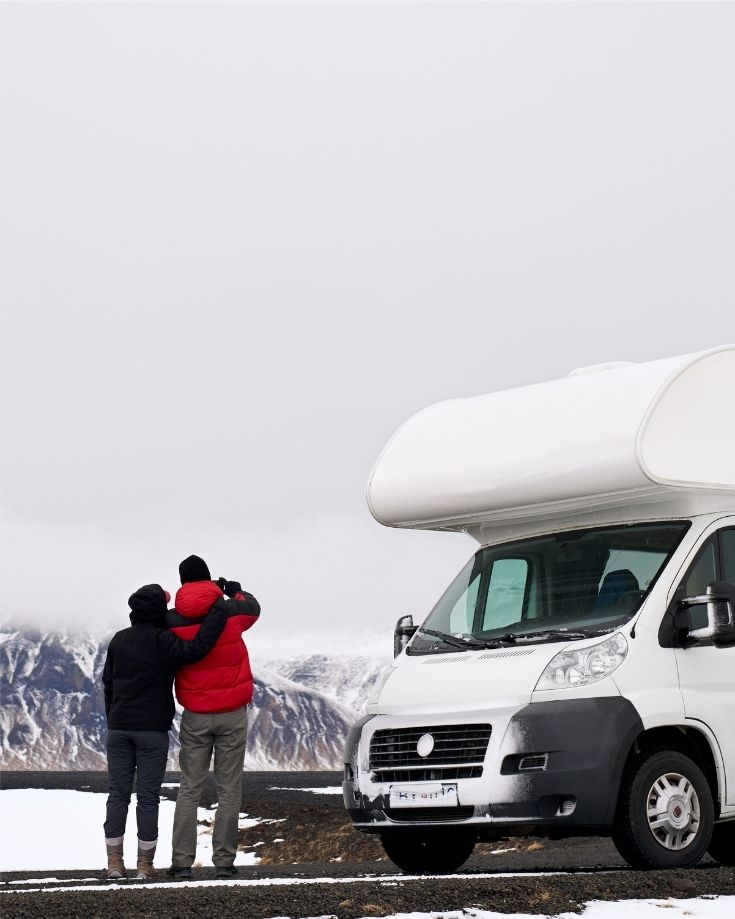
Class C Motorhome
Class C motorhomes are a good option for larger families. They can sleep between 4 and 8 people and are around 20-35 feet long.
These RVs are a good mix of space and convenience, and they’re often less expensive than Class A motorhomes.
Fifth Wheel Trailer
Fifth wheel trailers are a popular option for families and people who enjoy the outdoors but looking for convenience to use their towing rig without hauling the trailer everywhere.
They can sleep anything from 4 – 10 people and are around 30 feet long.
Travel Trailer
Travel trailers are a good option for smaller families or couples. They can sleep up to 4 – 10 people and are around 10-30 feet long.
They’re easy to set up and take down, making them a good option for weekend trips or longer road trips.
Pop up Trailer
Pop up trailers are the perfect option for people who want the convenience of a recreational vehicle without all of the space.
They can sleep 2 – 8 people and are around 10-15 feet long. They’re also straightforward to set up and take down.
How Often Will You Use Your RV?
How often you plan on using your RV plays a vital role in choosing the best size motorhome.
If you’re only going to use your RV a few times a year, then you may not need one that’s as big as a house.
Likewise, packing for a short trip won’t require as much storage space as packing for a long trip.
On the other hand, if you plan on living in your RV full-time, or even just for six months at a time, then you’ll need something that can accommodate all of your needs.
For example, you might not consider a washing machine or TV an essential accessory for a weekend getaway, but for long-term RV living, they’re a great convenience.
Choosing the right RV size to meet all your needs is essential for a comfortable and enjoyable experience.
What Accessories & Comforts do You Want that You Cannot Live Without?
Giving this question due consideration will help you ascertain how much space you need.
For example:
- Do you need a fixed bed that you don’t have to make up daily, or is a rock‘n’roll bed acceptable? The former will take out an amount of living space, leaving less space for daytime activities.
- Is a washing machine or dishwasher essential items? They’re not usually compact and take up a lot of space. So a small Class B is unlikely to be an appropriate size.
- Are you a digital nomad working in your camper and need a dedicated office space? A fifth wheeler or Class A is probably right for you.
- Do you have hobbies that use large pieces of kit like cycling or surfing? You’ll need an RV big enough to provide the storage space for your kit.
How Many People Will Travel & Sleep in Your RV?
One of the most important factors in choosing the best RV size is how many people will travel and sleep in your RV.
If you have a large family or you like to travel with friends, you’ll need a larger RV that can accommodate everyone.
On the other hand, if you’re traveling solo or with a small group, a smaller RV might be more suitable.
You also need to think about what kind of sleeping arrangements you want. For example, do you want bunk beds or beds for each person?
Consider visitors. You may travel as a couple, so a smaller, Class B RV would be suitable most of the time.
But what happens when the children and grandchildren turn up for a weekend? You could accommodate them in tents, or you may prefer them to have their own beds inside.
Your situation and family are unique to your travel style, so it’s an essential factor to consider when choosing how big or small to go.
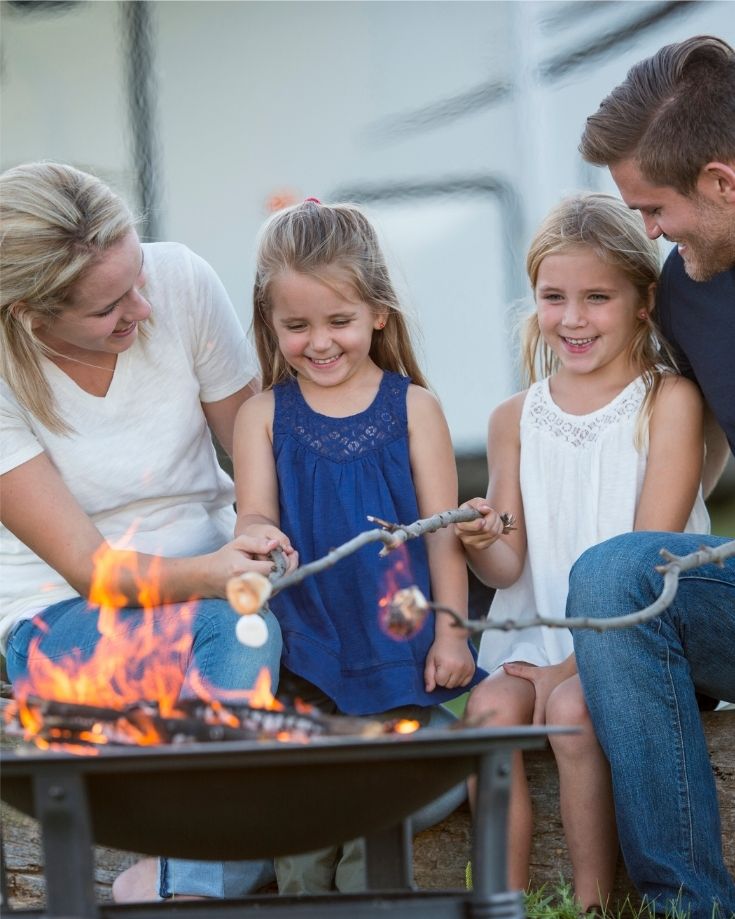
How Tall are You?
Some campers, especially Class B’s, have pretty low headroom. If you’re taller than 5ft, you’ll want to check you can stand up inside your RV without crouching.
For those planning occasional weekend getaways in fair weather, the lack of standing height may be no issue, but otherwise, think on.
Our Class B has a high roof, so there’s no real problem for anyone up to around 6ft.
That makes it comfortable for us to live year-round (we’re both relatively short). But if we were taller than 6ft, it wouldn’t be ideal.
Do You Travel with Pets?
Another important factor to consider is whether or not you travel with pets. If you do, you’ll need to make sure you have enough space for them (and you) to roam around and be comfortable.
If your pet likes to stretch out, you may want to dedicate a particular sleeping area of the RV for them.
You also need to factor in the space required for food and water bowls, litter boxes, bedding, and toys, plus all the other paraphernalia pets inevitably end up with.
When it comes to cats specifically, a larger RV will give them more room, especially if they’re not the kind of moggie to go on walks.
On the other hand, dog owners don’t have the same challenge as their pets use the outdoors more for exercise.
But a Class B motorhome might be the perfect size for a miniature Cavalier or Scotty dog, but an Alsatian (or 2) might be pushing its limits.

Consider RV Floor Plans
Floor plans vary by manufacturer, and each one offers its own unique set of benefits and drawbacks. For example, some floor plans are better-suited for extended trips, while others are more comfortable for short weekend getaways.
Choosing a layout that fits your lifestyle and travel needs is important. The exact same RV vehicle models and sizes usually have several layout options.
Some offer more storage space than others, which is crucial if you plan to do a lot of camping and hiking. Others have more living space, which can be great for families or groups.
The point is that while the overall size of the RV is important, pay attention to the layout and floor plan to maximize the space for your needs.
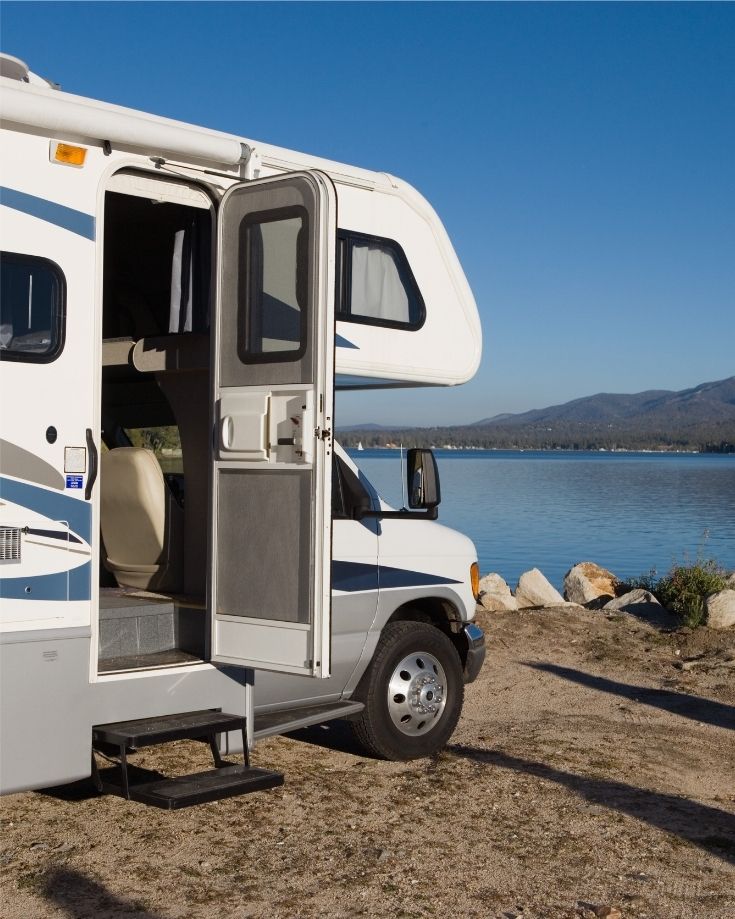
Where will You Camp?
The size of your camper has a bearing on where you can camp, so it’s crucial to consider where you think you want to camp.
For example, will you be near big cities and attractions? Or will you be in more remote areas? Will you use campgrounds or prefer boondocking or stealth camping?
Huge Class A motorhomes and fifth wheels aren’t ideal for stealth camping – they simply draw too much attention to themselves.
Any RV that looks like an RV isn’t ideal for stealth camping. Class B RVs are most likely your best choice if you’re trying to go unnoticed.
Do you plan on staying at National Park camprgounds? Unfortunately, they have limits on the RV lengths allowed to enter.
In general, anything up to 35 feet is ideal, but there are exceptions. For example, Banff National Park campgrounds limit RV length to 50 feet, while it’s 25 feet in Death Valley National Park.
State parks also have varied limitations on the RV length permitted to stay.
The upshot is that when you’re considering buying an RV, consider any limitations at the parks you’re most likely to visit most often and use that as a guide.
And if its a trailer you’re considering, don’t forget that the tow vehicle adds to the overall RV length too.
Do You Spend Time Inside or Beside Your Camper?
Your camping lifestyle can affect your choice of RV size, too. For example, if you spend more time outdoors, either exploring away from your rig or living beside it, you may not need a huge RV.
Fairweather camping may allow you to dine and work, if necessary, outdoors.
But, of course, that means you won’t spend so much time inside, so having plenty of space to feel comfortable may not be so important.
If you opt for a smaller RV, you can always use an add-on camper screen room to effectively extend your usable living space.
Alternatively, if you spend a lot of time indoors, a larger RV will provide a more pleasant space, especially for long-term living.
What’s Your Budget?
Your budget plays a crucial role in determining what size RV you can afford. Many factors determine the price of an RV other than simply its size.
That said, everything else being equal (age condition, brand, etc.), you can typically expect to pay more for a larger RV.
And when considering your budget, there’s more to consider than simply the upfront costs of the camper:
- Registration & documentation
- Campground fees
- Maintenance & fuel
In addition, if you’re hoping to reduce the cost of the RV by buying a travel trailer, make sure you account for the tow vehicle.
If you already have a tow vehicle, you may need an upgrade, depending on the size of the trailer.
And if you don’t already own one, you’ll need to budget for its purchase.
Before setting your heart on a specific size, make sure you’ve calculated your total affordability.

Consider Renting an RV Before You Buy
Renting an RV is a great way to test the waters and see if this lifestyle is for you.
It’s also much cheaper than buying one outright – which means that if it turns out you don’t like camping or traveling in your RV, then at least you didn’t spend too much money on it.
But once you’ve decided to buy an RV, renting allows you to try different types and sizes of RVs so that when you decide to purchase one, the chances are good that it will be the right fit for your needs and preferences.
The best part about renting an RV is that you can take your time deciding whether or not to buy one.
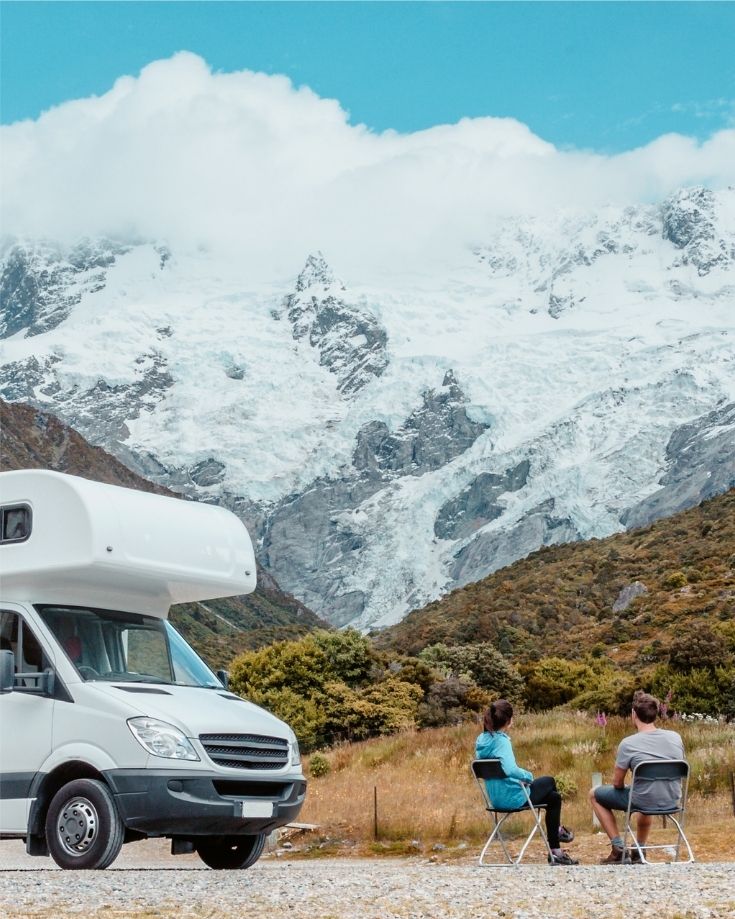
Advantages of Small RVs
Bigger isn’t always better, and small RVs have many advantages over their larger counterparts. Here are a few advantages a smaller RV has over a large one.
Note that these are generalizations, but there are many exceptions.
More Budget-Friendly
A small RV is typically much more affordable at purchase than a larger one.
Depending on the age and model, you can save tens of thousands of dollars by opting for a small RV.
For anyone storing an RV out of season, a smaller one demands lower storage costs too.
Less Fuel Consumption
A smaller RV will generally consume less fuel than a larger one, which is important to consider when traveling long distances.
This also means that your RV may have a smaller environmental impact.
This isn’t always the case and depends on make, model, age, and other factors, but it’s a fairly solid generalization.
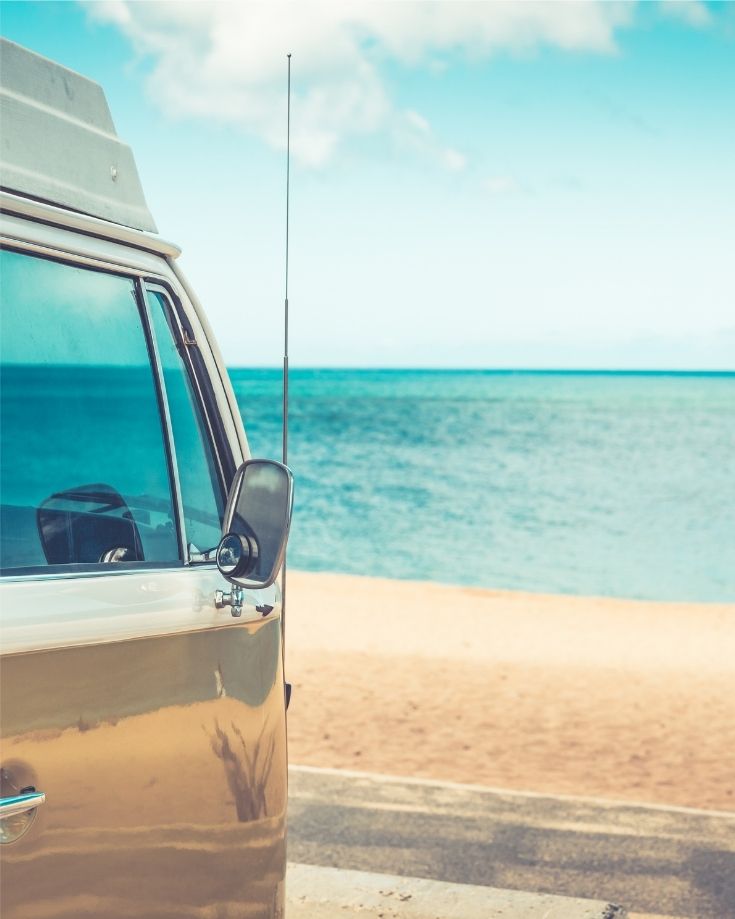
Take Up Less Space
Smaller RVs, by their nature, require significantly less space than large ones. This is great for people who don’t have a lot of storage space or want to keep their recreational vehicle close to home.
Most of us don’t have super long driveways, but many small RVs can fit neatly onto many home driveways.
Their shorter length also helps when parking, either at rest stops or store parking lots.
Easier to Drive & Maneuver
Smaller RVs are good for tight spots. They can get into campgrounds and parking lots without you having to back up or turn the RV around.
This is helpful when the spots are tight and you don’t have a lot of space to work with.
Less stress while on the road is another great benefit of opting for a smaller RV.
When you aren’t trying to maneuver your way through tight spaces, you have more time to relax and enjoy the journey.
Plus, you won’t have to worry so much about damaging your RV or running into something.
So, if you’re looking for an RV that’s easy to drive and maneuver, a smaller model is the perfect option. You’ll save yourself a lot of time and stress on the road.
Smaller Towing Vehicle
Trailers Smaller trailers don’t need such powerful towing vehicles.
If you’ve opted for a travel trailer, remember that smaller trailers don’t need such powerful towing vehicles.
Depending on what towing rig you already own, you may not need an upgrade with a smaller model.
More Campground Options
The smaller your RV, the more options you’ll have more camping. Because of the restrictions on RV length in national parks, larger RVs have limited options.
Boondocking is much easier in a smaller RV too. And if you have a low-profile Class B RV, you could even consider stealth camping.
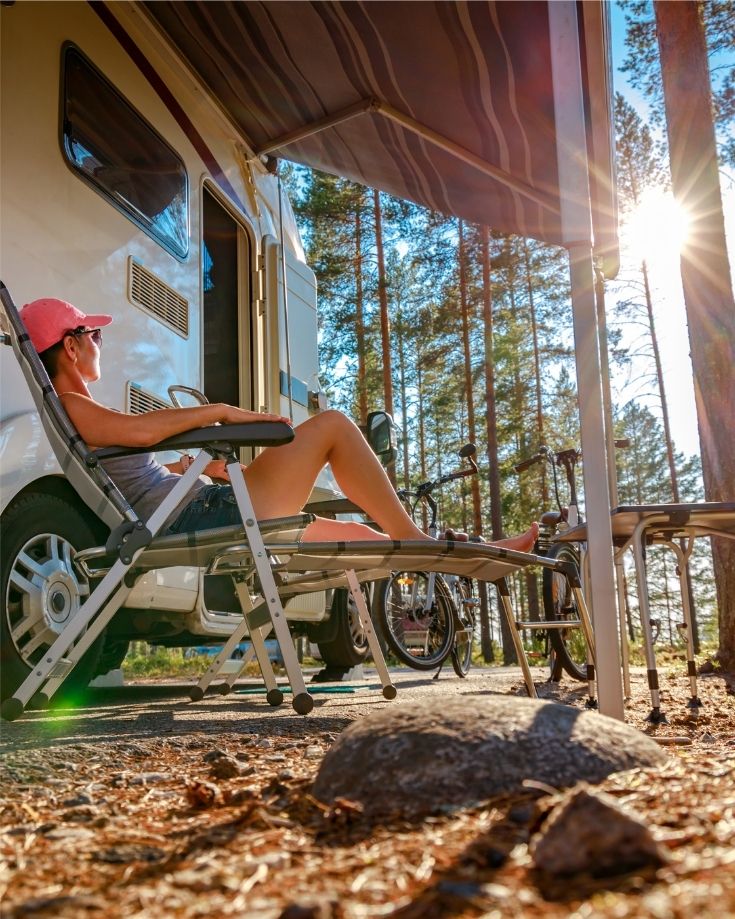
Easier to Setup & Decamp
Smaller RVs don’t take as much time to set up. For most models, you can pull into your camp spot, level up, and you’re done.
There are fewer, or no, slideouts to retract, and you may not need to (un)hook up sewage and water tanks.
That makes smaller RVs ideal for those frequently on the move.
If you had to go through the palaver of setting up and decamping a few times a week, or even more often, you’d soon get tired of it.
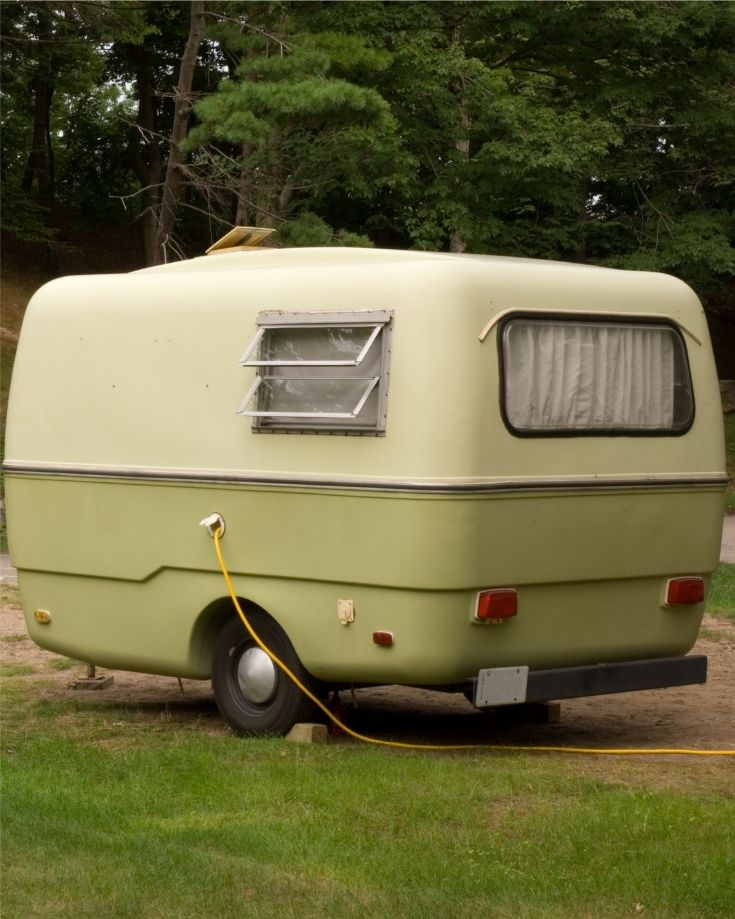
Benefits of Large RVs
And then sometimes, bigger is most certainly better. It’s only a shame we can’t have the best of both worlds!
Here are a few of the benefits of choosing a large motorhome or travel trailer for your RV travel adventures.
Larger Interior Space
A larger RV means a larger interior space. This can be great for families or groups who want to travel together.
You’ll have plenty of room to move around, and multiple slide-outs can expand the interior even further.
The largest RVs can be a home away from home, with all the creature comforts needed to live in it full-time should you wish.
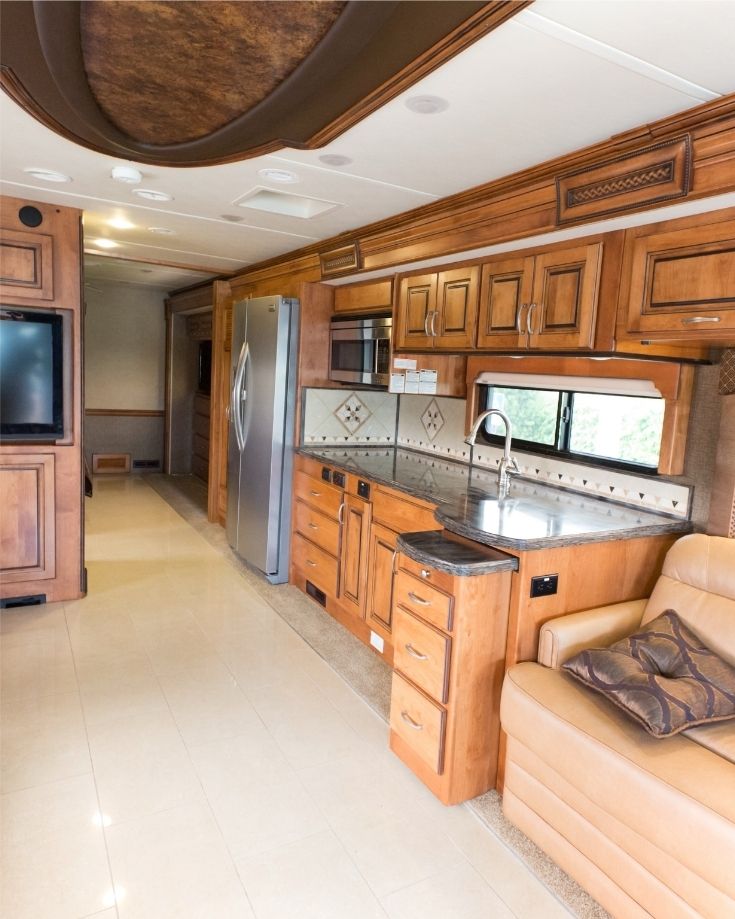
Ideal for Full-Time RVing
When it comes to full-time RVing, there are a lot of factors to consider when choosing the right rig for your needs.
But if you’re looking for an RV that can provide plenty of space and comfort, a large RV is often the ideal option.
One of the most significant benefits of a large RV is that it can easily accommodate a family or group of friends.
So whether you’re on a cross-country road trip or just taking a weekend getaway, there’s plenty of room to spread out and relax.
Plus, many large RVs come equipped with full-sized kitchens and bathrooms, making them the perfect home away from home.
The largest RVs may not be permitted to stay in National Park campgrounds, but a large RV is worth considering if you’re looking for plenty of space and comfort.
More, More, More of Everything
Just look at the amount of storage in a Class A motorhome.
That enormous underbelly can house massive holding tanks and provide fabulous storage for outdoor equipment like grills and outdoor furniture.
The interior space is vast, so you have no worries about finding space for luxury goods like a washer and dryer, large refrigerator, and coffee machines.
Then there are the sleeping arrangements. Not only can you find RVs capable of hosting a large family, but they also provide plenty of space.
Those bedrooms aren’t all cramped, or bunk beds, with many large RVs, offer spacious sleeping accommodation for everyone.
And large RVs usually have enough towing capacity so that you can haul around your daily runaround.
On the other hand, toy haulers are designed to carry small vehicles inside.
That negates some of the downsides of driving a large vehicle, albeit it also extends the total RV length while you’re traveling.
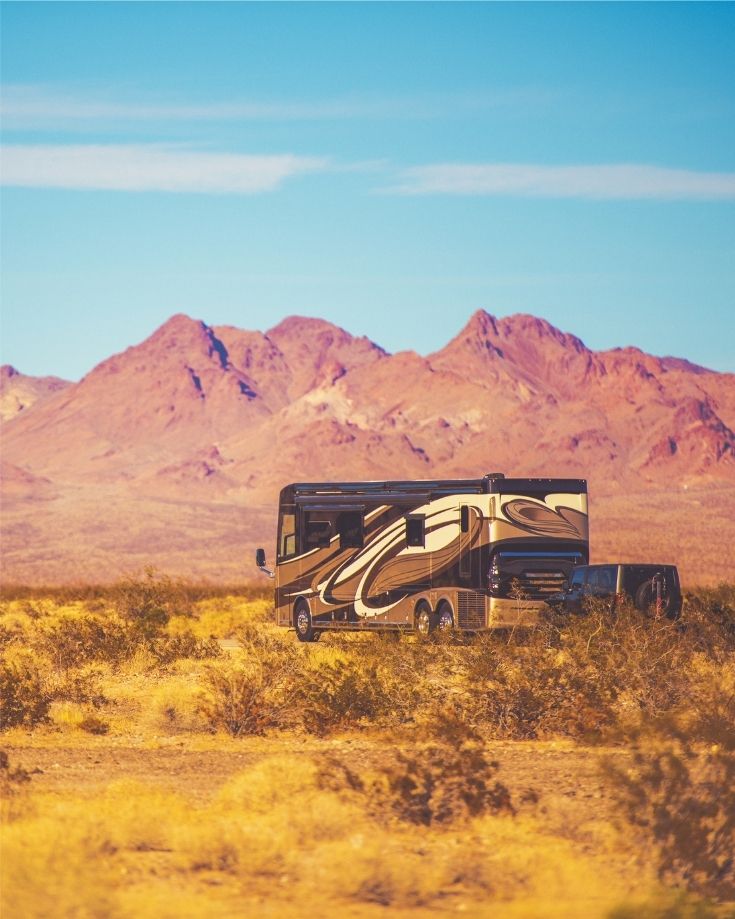
Wrapping It Up
When considering what size RV is best for you, it’s essential to consider various factors such as your budget, the type of camping you plan on doing, and how much time you spend inside or outside your camper.
Ultimately, the best RV size for you will depend on your individual needs and preferences.
All of the factors we’ve considered in this list are important when determining what size RV is best for you.
Whether you’re looking at how much space you need or what your budget can afford, it’s key to think about all of these things before making a purchase.
And if you’re still not sure what size RV is right for you, renting is always an option.
If you’re still unsure what size RV is right for you, renting is always an option. You can try out different sizes and types of RVs to see which is best for you.
Angela Devaney

Angela Devaney, a former IT project management professional, embarked on an adventurous journey of full-time travel, which included touring West Africa in a converted overland truck and converting an ex-military 4×4 Sprinter van into a camper for a five-year South American expedition. She now utilizes her hands-on experience to create practical RV living and van life advice as a full-time digital media producer, reaching over a million users annually through her YouTube channel , blog, and newsletter. Angela also lends her expertise as the editor-in-chief of the Campervan Electrics Handbook .
Leave a Comment Cancel reply
Save my name, email, and website in this browser for the next time I comment.
Related Posts

© 2024 mowgli adventures
Privacy Policy | Terms Of Service | Sitemap
Part of Mowgli Adventures Media Ltd. Registered in England and Wales. Company Number 13558893

12 Different Types of RV Trailers (Towable)
Posted on Published: October 14, 2018 - Last updated: June 13, 2022

Camping is a popular outdoor activity for Americans. About 9 million families own an RV trailer while there are more than 16,000 public and private camping sites for RV owners in the US. Since 1980, RV ownership has gone up to almost 60 percent.
3 years ago I went on my first RV camping trip . We rented a motorhome and drove from Vancouver, BC to the Yukon. I loved it. Since then, we’ve rented an RV every summer.
Comfort, convenience, and mobility are just some of the allure to owning an RV . Using an RV also reportedly saves its owners 23-59 percent on their vacation cost.
Also check out 10 Types of Motorhomes and this good RV overview article for all types of RVs and don’t miss my RVezy Review (RV rental marketplace where I rented an RV trailer).
Related: 10 Lightweight Travel Trailers (Under 2,000 Pounds) | 19 Different Types of Trailers | 7 Awesome DIY Teardrop Trailer Projects (Access to Full Instructions) | 7 of the Best Small Travel Trailers
Overview RV Types Chart

1. Regular Travel Trailer

A travel trailer is the largest of all towable RV trailers and is a great option if you want to enjoy the convenience and amenities of being in your own home while on the road. They come in a variety of styles and can either be very plain or fancy on the inside, depending on what you are looking for when you are on vacation.
Because some of these travel trailers are incredibly small, it’s a good idea to look for one that has a section that will stretch out from the main area when the trailer is parked. This is a great way to expand the living space of your travel trailer, but still enjoy the ease of pulling one that is smaller.
You don’t need to purchase a specific vehicle to pull this type of RV trailer, as long as your SUV, truck, or van has a ball hitch and is rated to be able to handle the weight of the trailer. This makes it a great option for people who are on a budget. It can be difficult to set up the travel trailer on the hitch and to keep it level, and many people find that maneuvering with their travel trailer is hard. However, they are a wonderful option if you are comfortable with your driving and your living space being separate while you are on the road.
2. Airstream

Airstream is a high-quality type of travel RV trailer. They’re very popular, but expensive.
3. 5 th Wheel Trailer

While at first glance these RV trailers may look exactly like travel trailers, there is one major difference that sets them apart. They have a gooseneck connecter that will allow the trailer to attach to the towing vehicle. This does come with its own set of pros and cons, making it important to understand what this would mean for you before you buy this type of trailer.
The gooseneck connector makes towing your trailer incredibly easy and decreases the problems that you may have when trying to connect the trailer to your towing vehicle. Additionally, since the gooseneck extends over the towing truck, there is additional space in this trailer that can be used for storage.
The problem that you will run into if you are interested in a 5 th wheel trailer is that you have to have the right type of vehicle to be able to pull it. It’s mandatory that you have a truck with a flat or an open bed, or you will not be able to tow this RV trailer. While they are significantly easier to maneuver than a travel trailer is, it is illegal for anyone to ride in the 5 th wheel trailer while it is in motion. This means that you need to have enough space in your towing vehicle for everyone to sit while you are on the road.
4. Truck Camper

This is a self-contained RV Trailer that will actually fit into the bed of a pickup truck, making driving, maneuvering, and backing up all incredibly easy. They have been made to fit in most any type of pickup, and many truck companies have created models that are designed to easily handle the additional weight of a truck camper without sacrificing the quality of the vehicle or how it drives.
Because you can attach the truck camper to the truck itself, you can pull an additional trailer with gear and supplies, if desired, which makes it easy to bring along with you everything that you will need while you are on vacation.
These campers generally have amenities, although not as many as other RV trailers do, so you need to consider what is more important: having all of the amenities that you want or a lower price point and an RV trailer that is easier for you to drive and handle.
Because the room inside is so extremely limited, these trailers are not a great option if you want to bring the whole family with you on vacation. They are not designed for use for a long period of time, but because they have everything that you need, if you want to travel on a budget, then this is an option to consider.
5. Trailer with Pop-Out Tent(s)

This is the least expensive type of RV trailer that you can use to sleep and live in while you are on the road. They are designed to be very lightweight while still making sure that you have most of the amenities and comforts that you expect while you are on vacation.
They are very small, which makes them a great option if you want to pull an RV trailer with your personal vehicle and don’t have a large truck or SUV to use. To ensure that you can easily open and set up your folding RV trailer, you need to make sure that you look for one that has not only a rigid roof but also a lift system.
It is hard to store much of anything in these trailers since they will fold flat when they are not in use, but once opened, they are incredibly spacious and will offer plenty of space for your family to sleep. They generally have space to cook, pull-out beds, and an electrical system so that you can stay comfortable.
Unfortunately, due to their design, they do take a lot of effort to set up and to take back down when you are ready to get on the road. It’s a good idea to practice this a few times to ensure that you can do it smoothly and easily when on vacation.
6. Teardrop Trailer
The teardrop trailer is a cross between a tent and traditional RV trailer. They’re compact, light and in many cases, towed by a car. In fact, the need for a pickup truck is a big barrier to buying a larger trailer because pick up trucks are expensive. The teardrop solves that problem, but as you see below, there isn’t nearly the amount of space as you’d get with a full size trailer. Essentially it’s a sleeping compartment with a kitchen hatch.

Side view of a teardrop trailer with kitchen hatch.

Close up of kitchen area at rear of teardrop camper.

The sleeping compartment of a teardrop trailer.

Side view of a teardrop trailer with open door and hatch. Table attaches to the side.
7. Sports Utility RV Trailer with Garage
There is generally a small living space in these trailers where you can sleep at night, but many people are not comfortable sleeping so close to motorized equipment and gasoline. It can be difficult to keep the air inside these RV trailers fresh and clean.
Because they can be outfitted with appliances to ensure that you are comfortable while on the road, they are a great option for any family who wants to travel and bring along their motorized equipment. It’s important to make sure that you choose one that is large enough to fit your equipment and other supplies while still providing you with living space, if necessary.
8. Hard-Top Pop-Up Trailer

If you like the light weight of the tent trailer as well as how compact it is, but prefer a hard top, here’s a hard-top style triangular RV trailer.
9. Pop-Up Tent Trailer

These are popular for several good reasons. They’re:
- Inexpensive
- Lightweight (many cars can pull these)
- Off plenty of sleeping space – you can easily accommodate 4 people.
10. Retro Trailer

If you like retro, here’s a great example. Actually, it’s a popular option buying an old trailer from the 50’s or 60’s and fixing them up to their former glory.
11. DIY Ice-Fishing Camping Trailer

I don’t think you’d want to rip along the highway at 70 mph with this sucker, but if ice fishing is your thing, this is actually a decent option to stay warm. Clearly you can see this is a DIY product, but who knows – maybe RV manufacturers will come out with this in the future.
12. Vehicle-Tent Combos
In recent years, two types of vehicle-tent combos have hit the market. They are car roof tents and pickup flatbed tents. They’re a great option if you don’t want to shell out for a trailer but also don’t want to sleep on the ground. Here are some examples.
a. Car Roof Tent
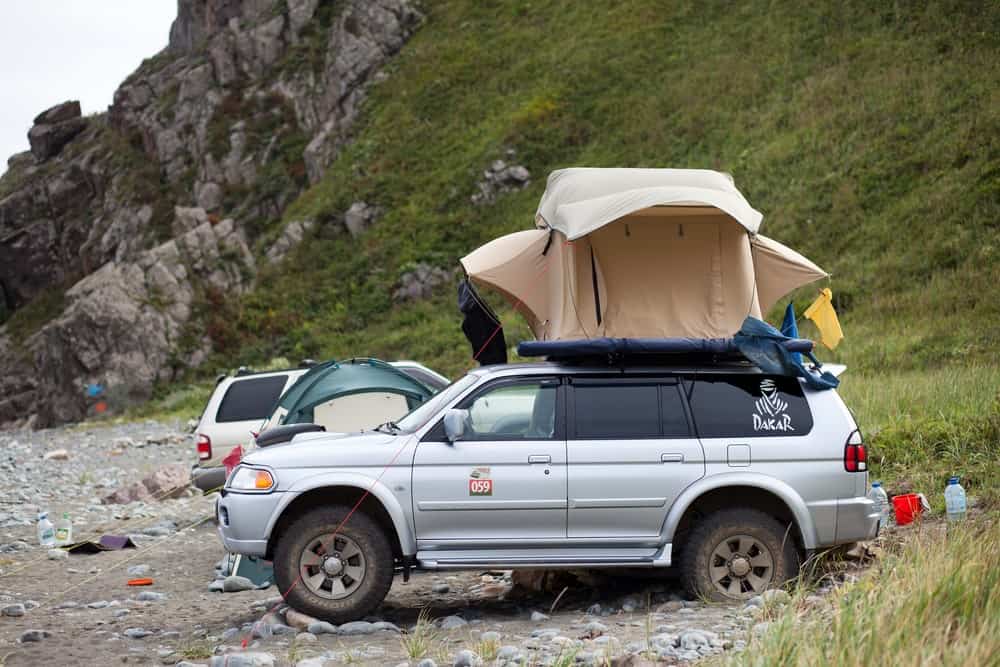
One interesting option that has become popular in recent years is the rooftop tent. You may not even know what this type of tent is until you look into a little further. This tent is meant to go on top of the roof of your vehicle. It is a popular option for people that own SUVs and other large vehicles.
When you want to be able to experience camping out in a tent, but don’t want to be stuck on the cold hard ground, this option is great. You’ll be able to camp up off of the ground without any hassle. Setting up the rooftop tent is going to be very easy overall. You’ll just have to fold it out and make the proper adjustments in order for it to be secure.
Many of these rooftop tents have a little ladder that comes with it. You can use this to crawl up into the tent and position yourself for sleeping. Of course, you should note that these tents aren’t exactly huge. They will be large enough to fit a couple of people and you might be able to fit three people comfortably, depending on how big everyone is.
You will want to make sure that you bring some nice bedding or bedrolls with you in order to make things as comfortable as possible. As long as you line things properly with blankets , you shouldn’t feel the metal of your vehicle underneath you too much. This solution isn’t going to be optimal for everyone, but it is something that is worth considering. Being up off the ground has its advantages and the tent is very easy to set up.
b. Pickup flatbed tent

Click for price
Truck bed tents are the exact same idea as the rooftop tents mentioned above. The big difference is that these tents are designed to be placed in the bed of your truck. In some ways, this is going to feel preferable because it is a bit more stable. If you want to be able to camp up off of the ground, then this option will be able to make it easy for you to do so.
The tent itself is nice and will keep you protected from the elements. Even if it starts raining during your camping trip, you should be able to keep from getting wet inside of the tent. It is made out of strong materials that won’t buckle under heavy rain. You’ll be able to sleep comfortably and will be glad to be off of the ground most certainly.
These tents come in different sizes too, so that you can match it up with your specific truck bed. You should be able to find a tent that will match your truck just right. Once you have the right tent, you’ll never have to worry about camping out on the ground again. This option is becoming more prevalent every year, so you may want to start looking into the trend.
Options such as this are different from tent trailers, but they really do go hand in hand. People who purchase these types of tents are looking for a convenient and cost-effective method for camping. Sometimes buying a tent such as this is going to be preferable to owning a pop-up camper. It depends on what you are looking to get out of the experience and what your budget is like.
Slide-Out Section
Depending on the type and size of RV trailer that you are going to buy, you will want to consider one that has a slide-out section. These sections will easily pop out once you are off the road and settled for the night, and they are a great way to increase the amount of living space that you have in your RV trailer. Make sure that you choose one that is easy to operate so that you don’t spend a lot of time trying to slide it in and out and so that you aren’t frustrated.
Primary Bedroom Suite

If you are going to be traveling with your whole family and want to make sure that you can have some privacy at the end of the day, then look for an RV trailer that has a primary bedroom suite. While this will obviously not be as roomy or as comfortable as your room in your home, being able to access a private bathroom and to shut the door at night may give you the privacy and peace and quiet that you crave when you are on the road.
Washing Machine and Dryer
The last thing that you want to try to do is find a place where you can wash laundry while on the road. Not only is it sometimes difficult to find a location and then to navigate their parking lot, but this will also eat up the precious time that you have on vacation. Being able to do to your laundry without having to leave your RV trailer will ensure that everyone always has clean clothes and will keep you from being frustrated with trying to find somewhere to stop.
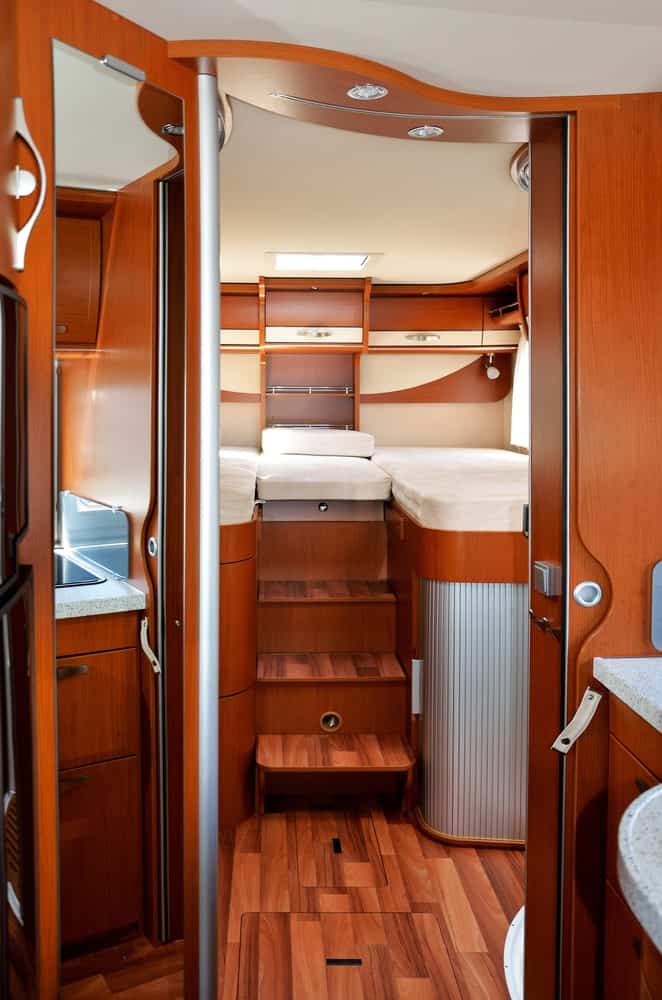
Rather than opting for an RV trailer with a tub/shower combination that can be cramped and uncomfortable to use, look for one that has a full bath with a walk-in shower . While this may not seem like a deal breaker, especially if you have an RV trailer in mind that you really like, being able to stretch out in the shower can really make traveling more pleasant. This is especially important for people who are going to live in their RV trailers for extended periods of time to consider.
Energy Management System

Source: Amazon
To make sure that you do not run out of energy while you are on the road, an energy management system is a great idea. Rather than you having to keep an eye on what appliances are in use and how much energy they are drawing, this system will monitor how much current each electrical device draws, and it is able to turn them on and off to limit the amount of energy that is used. This will prevent major problems while you are on the road and reduce the stress that you feel regarding keeping an eye on your energy use.
Day/Night Shades

Some RV trailers can really benefit from these shades so that you can control how much light comes through them. Not only is this a great way to keep the extra sun from beating in your RV trailer, but they can also prevent people from seeing in at night. This is great if you want to make sure that you have privacy while on the road, but you don’t want to have to worry about curtains or hanging up blankets or sheets in the windows.
The shape of the nose of your RV trailer will have a huge effect on how fuel efficient you are when on the road. While many older models have a flat front, this style is not very fuel efficient and can cause you to have to stop and refuel more regularly. If you are able to choose an RV trailer with a v-nose then you can cut through the wind more efficiently and decrease the drag that you experience while traveling.
Auto Leveling System

In general, RV trailers are notorious for being difficult not only to level before you start out on your trip but to keep level. This is not only uncomfortable for anyone who may be inside but makes it very difficult for you to keep your supplies from shifting or falling. If you are tired of dealing with items that have toppled over while you are on the road, then you will want to look for an RV trailer that has an auto leveling system. This will prevent your trailer from being shaky while you are on the road and make it easy for your RV to stay stable.
No matter whether you are going to be riding in your RV trailer or simply hauling gear and supplies, you need to make sure that everything will stay in place while you are on the road. An auto-leveling system is a great idea, but it isn’t something that everyone can have in their trailer. Instead, look for an RV trailer that has numerous tie downs in the space. These tie downs make it easy to ensure that your furniture, boxes, and equipment don’t shift around or fall over, no matter how curvy the roads are where you are traveling.
Insulated Floor
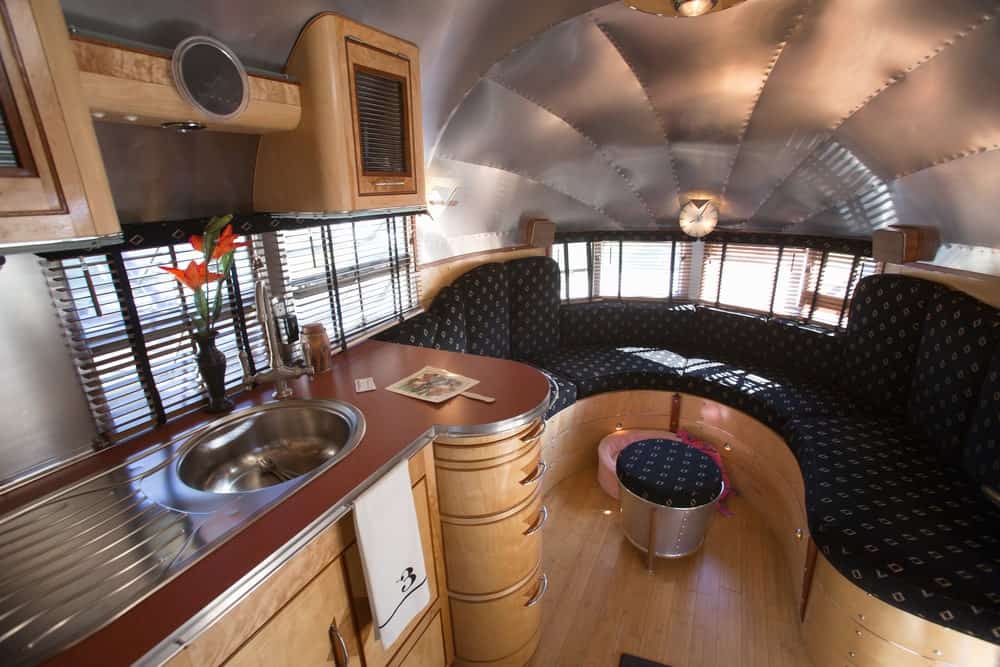
You are going to lose a lot of heat through your floor and will experience temperature changes throughout the day and the night if you do not opt for an insulated floor. This is especially important if you are going to be staying in your RV trailer at all or are going to be hauling items that are temperature sensitive. Since this is not a standard feature on all RV trailers, you will have to look for one that offers this if you are worried about how well you can control the temperature inside your RV. This will also decrease the amount of energy that your RV trailer requires.

This may seem like a luxury to some people, but if you want to relax at the end of a long and hot day on the road with a cold beverage, then it’s a good idea to look for an RV trailer that has an ice maker. Not only can you easily chill your drinks whenever you want to, but having access to ice means that you can create a cold compress quickly if you have an accident or someone is injured while you are on the road.
Basement Storage
Some larger RV trailers come with optional basement storage, and this is a feature that you will definitely want to consider if you are going to be living in your RV trailer for a long period of time. You want to make sure that you are going to be as comfortable as possible and that you will have with you all of the supplies that you need. Ample storage will also decrease the number of times that you have to stop and visit a store, which will help you travel more efficiently while on vacation.
Large Sun Visors
Any RV trailer that you are going to be driving needs to have large sun visors so that you can effectively block the sun that is coming in your front window. Make sure that you opt for sun visors that are easy to adjust and will stay in position when you move them so that you don’t have to worry about them shifting while you drive. Some RV trailers even come with motorized sun visors so that they are even easier to get into place and to control.
Related: Tiny Homes vs. RVs – What’s Best for You?

The ultimate hub for all things RVs
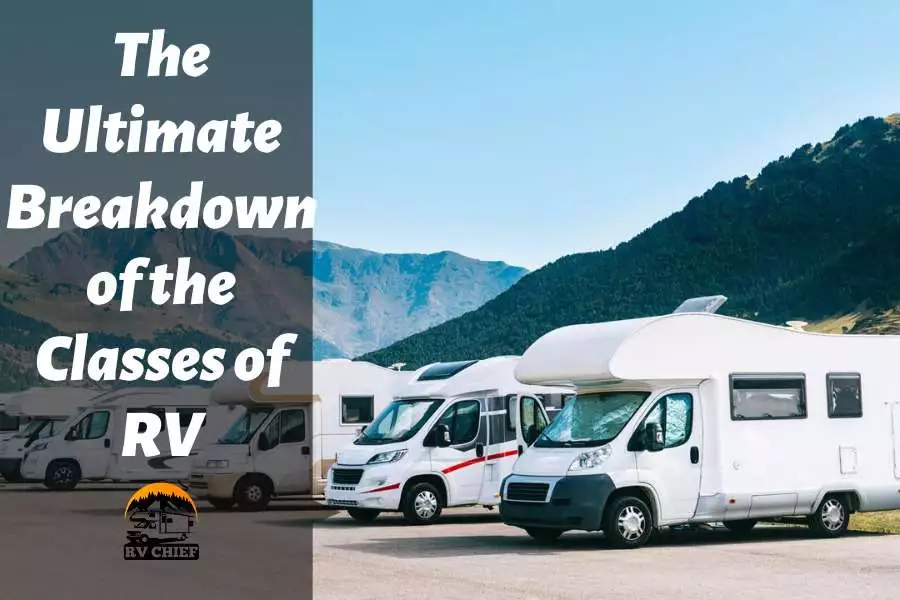
Different Classes of RV Explained: The Ultimate Breakdown
Traveling on the open road has never been so versatile, thanks to the different classes of RV available to modern adventurers. But understanding the different classes of RV can be a winding journey of its own. Now, to the big question: “What are the classes of RVs?”
Generally, there are different classes of RV classified into three main categories: Class A, Class B, and Class C. Class A RVs are the largest and most luxurious; Class B RVs are compact and versatile; and Class C RVs offer a balance of amenities and maneuverability. Each class has unique features, size ranges, uses, and target audiences. And they all represent a unique blend of comfort, style, and versatility.
From the compact and elegant to the grand and luxurious, the classes of RVs are tailored to suit every traveler’s yearning for the extraordinary. By understanding the different classes of RVs, you can select the one that best suits your travel style, desired amenities, and overall preferences.
Table of Contents
- 1.1 Class A RV (Largest Motorhome)
- 1.2 Class B RV (Camper Van)
- 1.3 Class B plus RV (Class B plus Motorhome)
- 1.4 Class C RV Motorhome
- 2.1 Travel trailers
- 2.2 Toy haulers
- 2.3 Pop-up trailers
- 2.4 Truck campers
- 2.5 Fifth wheels
- 3 What is the difference between a Class B and a Class B+ RV?
- 4 What is a class A RV?
- 5 What are class B RVs?
- 6 What is a Class B+ RV?
- 7 What is a Class C RV?
- 8 Is my RV a Class A or C?
- 9 Choosing the Right Class of RV for Your Needs
What are the Different classes of RV?
The world of recreational vehicles is vast and varied, with different classes of RV tailored to every kind of traveler. Each comes in various classes and types to suit different needs and preferences.
Some of the classes of RV are Class A, Class B, and Class C. Each class offers unique features and advantages, catering to different travel styles and requirements.
- Class A RVs are the largest and most luxurious, resembling a bus-like structure and offering ample living space and amenities.
- Class B RVs, also known as camper vans, are compact and versatile, built on a van chassis with amenities for comfortable travel.
- Class C RVs are a mid-sized option featuring a distinctive cab-over design, often with a sleeping area above the driver’s compartment. They provide a balance of amenities and maneuverability.
Class A RV (Largest Motorhome)
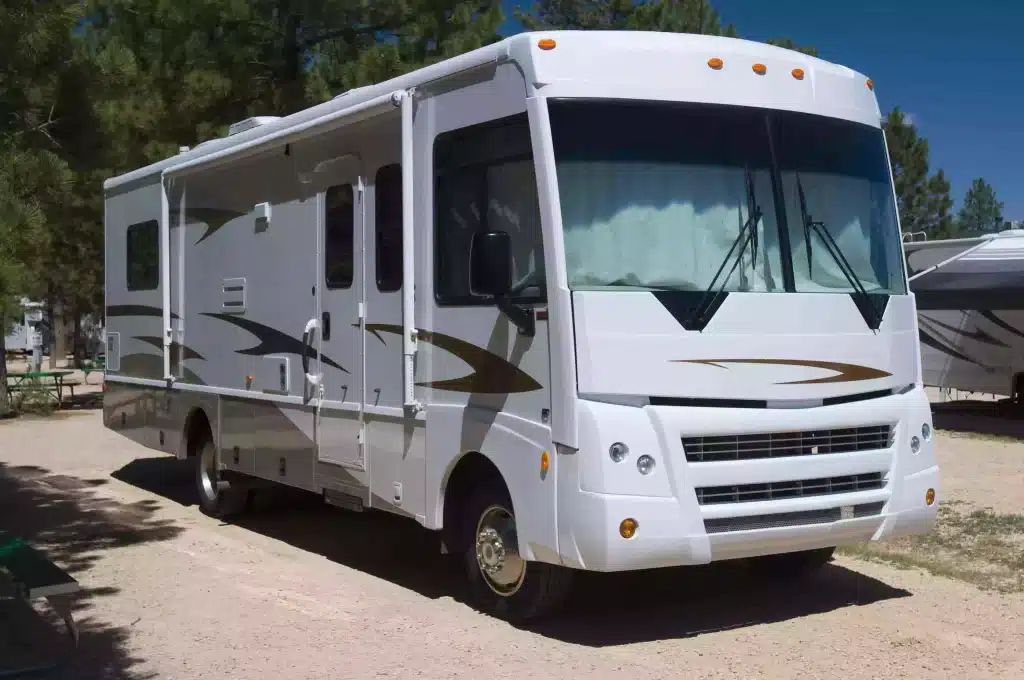
- Length: 29 to 45 feet (7.9 to 13.7 meters) in length
- Height: 10 to 13.5 feet (3 to 4.1 meters)
- Weight: 20,000 to 40,000 pounds (9,000 to 18,000 kilograms) or more.
Class A RVs offer a wide array of amenities and living spaces. The interior is designed to maximize comfort and convenience. It often includes a spacious living area with comfortable seating, entertainment systems, and large windows for panoramic views.
This type of RV often has separate sleeping quarters, including a master bedroom with a queen or king-size bed, wardrobe storage, and sometimes a washer and dryer.
Additional amenities include:
- Heating and air conditioning systems
- Power awnings
- Slide-out sections that expand the living space
- Built-in generators and advanced technology systems.
Due to its size and weight, driving a Class A RV requires a special driver’s license in some jurisdictions. However, these motorhomes provide a spacious and comfortable living environment once parked.
Making them a popular choice for full-time RVers or those seeking a luxurious home on wheels.
Class B RV (Camper Van)

- Length: 16 to 22 feet (4.9 to 6.7 meters)
- Height: 7 to 9 feet (2.1 to 2.7 meters)
- Weight: Between 6,000 and 10,000 pounds (2,700 and 4,500 kilograms)
The Class B RV is one of the classes of RVs with a compact and versatile design. They provide the convenience of a motorhome in a smaller package.
These types of RV are built on a van chassis, which offers mobility, ease of driving, and efficient fuel consumption. Despite its compact size, a Class B RV is designed to maximize functionality.
It has various amenities, like:
- Freshwater and wastewater tanks
- Electrical systems with batteries or generators
- Entertainment options like TV and audio systems.
Due to its smaller size, a Class B RV offers excellent maneuverability, making navigating narrow roads and parking lots easier. It provides the freedom to explore both urban areas and natural landscapes comfortably.
Some models offer additional features like awnings, exterior storage compartments, and solar panels for energy efficiency.
Overall, the Class B RV is a versatile and self-contained vehicle that offers a compact and efficient camping experience.
Class B plus RV (Class B plus Motorhome)

- Length: 22 to 30 feet (6.7 to 9.1 meters)
- Height: 10 to 12 feet (3 to 3.6 meters)
- Weight: 8,000 to 12,000 pounds (3,600 to 5,400 kilograms)
The Class B Plus RV offers a combination of comfort and maneuverability. It is built on a van chassis, typically larger than a traditional Class B camper van but smaller than a Class C motorhome.
The interior of a Class B+ RV is designed to maximize space efficiency. It typically includes a small kitchenette with a refrigerator, stove, sink, and storage cabinets.
It is worth noting that the bathroom may have a toilet, sink, and shower. The main living area can feature a dinette or sofa that can convert into a bed, allowing for sleeping accommodations.
Other amenities commonly found in Class B+ RVs include:
- Heating and air conditioning systems.
- Freshwater and wastewater tanks.
- Electrical systems with batteries or generators for power.
Class B+ RVs also offer better fuel efficiency compared to larger models, and their compact size allows for greater flexibility regarding campsite selection.
Class C RV Motorhome

- Length: 20 to 32 feet (6 to 9.7 meters)
- Weight:10,000 to 14,000 pounds (4,500 to 6,350 kilograms)
The Class C RV is popular among camping and road trip enthusiasts. Combining the convenience of a motorhome with the maneuverability of a smaller vehicle, it offers a range of features and amenities for comfortable travel.
Inside the main living area, you’ll find a variety of amenities.
These can include:
- A kitchenette equipped with a refrigerator
- Microwave and sink.
The dining area typically has a table and seating, which you may convert into an additional sleeping space. The bathroom usually includes a toilet, sink, and shower.
The RV may have heating and air conditioning systems to ensure comfort in various weather conditions. It may also include a freshwater tank, a grey tank for wastewater, and a black tank for sewage.
Power options can consist of a generator and electrical hookups for campground connections .
Different Classes of RV: Towable RV Trailers
These are another popular option for travel enthusiasts, providing flexibility and convenience. Towable RV trailers are categorized into different classes based on size, weight, and features.
The classes of towable RV trailers include:
Travel trailers
Toy haulers, pop-up trailers, truck campers.
- Fifth-wheel trailers
Travel trailers are the most popular type, ranging from compact units to larger models with various amenities. Fifth-wheel trailers have a unique hitch design that attaches to a truck bed, offering increased stability and often more living space.
Toy haulers are designed with a garage space at the rear, allowing you to bring recreational vehicles or gear. Each class offers distinct advantages and considerations, catering to different travel needs and preferences.
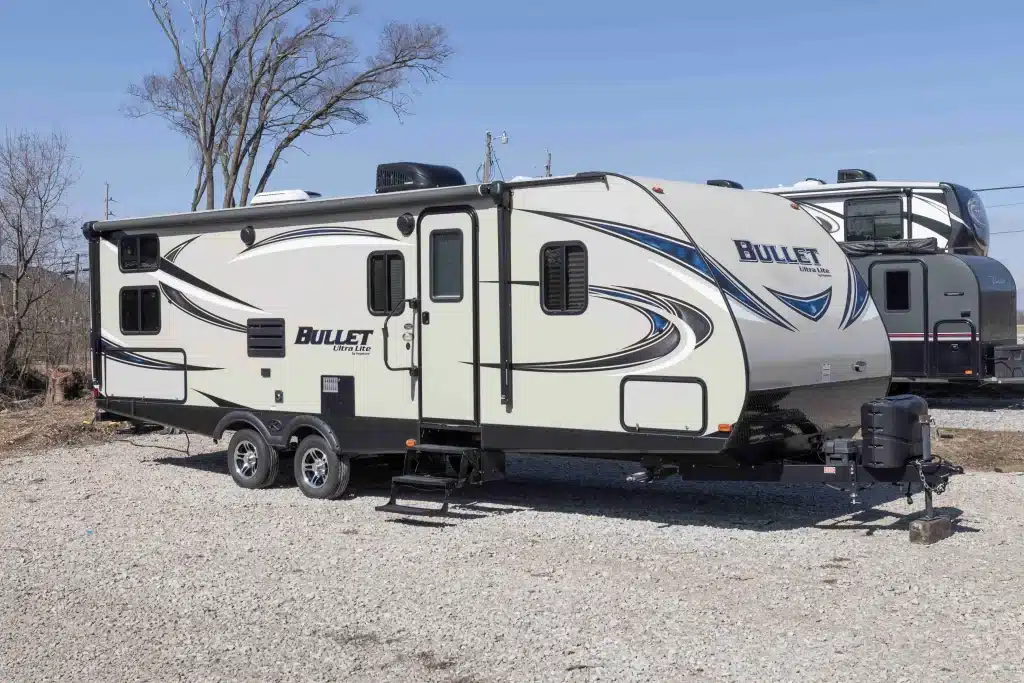
Travel trailers are a popular class of towable RV trailers that offer various options for camping and travel adventures. These trailers come in different sizes, ranging from compact units to spacious models with multiple slide-outs.
One of the advantages of travel trailers is their versatility. They can be towed by SUVs, trucks, and even larger sedans, making them accessible to a broader range of travelers.
However, the size and weight of travel trailers vary, but they generally offer a comfortable living space with amenities such as sleeping areas, kitchenettes with appliances, and storage compartments.
These trailers can be an excellent option for families, couples, or solo travelers seeking the comforts of a traditional RV with the convenience of towing.
They provide a comfortable and customizable living space for camping trips, road adventures, or long-term stays at campgrounds or RV parks.

These are a unique and versatile class of towable RV trailers designed for adventurers who want to bring their recreational vehicles and gear along on their trips.
Toy haulers feature a dedicated garage space at the rear, typically accessible through a ramp door, allowing you to bring motorcycles, ATVs, bikes, or other toys with you.
These types of RV trailers give you the option to transform the garage area into a multi-purpose space. It can serve as a living area, additional sleeping space, or even a mobile office when not used for storing vehicles.
The front portion of toy haulers resembles a conventional travel trailer, offering amenities such as sleeping areas, kitchenettes, bathrooms, and dining spaces.
It is worth noting that the size and layout of the living area vary, providing options for individuals, couples, or larger families.

Pop-up trailers, also known as tent trailers or folding campers, are towable RV trailers. They are also one of the classes of RVs that offer a unique camping experience.
These types of RV trailers are characterized by their collapsible design. This allows you to easily tow and store things while providing expanded living space when unfolded.
One of the advantages of pop-up trailers is their versatility. They are often lighter and more affordable compared to other RV options, making them suitable for towing with a wide range of vehicles.
The collapsible design also allows for convenient storage in garages or tight spaces when not in use.
They are a popular choice for campers who enjoy a mix of tent camping and RV comforts, as they provide a balance between the two.
Overall, pop-up trailers are an excellent choice for those looking for a compact and versatile RV option that combines convenience, affordability, and the joy of camping under canvas.

Truck campers, also known as slide-in campers or pickup campers. These types of RVs are designed to be loaded onto the bed of a pickup truck.
They are compact and versatile campers that provide a unique camping experience with the convenience of a truck as the base.
Despite their compact size, truck campers offer a lot of living space. They typically include a sleeping area, a kitchenette, and a small bathroom with a toilet and shower.
One of the advantages of truck campers is their excellent maneuverability and off-road capabilities. Being mounted on a pickup truck, they can navigate narrow roads and access remote camping spots that may be challenging for larger RVs.
Truck campers are popular with adventurers who want to explore off-the-beaten-path destinations and enjoy a more rugged camping experience. They also offer better fuel efficiency compared to motorized RVs.
Fifth wheels

Fifth wheels are towable RV trailers that offer spacious living accommodations and enhanced stability during towing. These types of RV trailers are designed to be towed by pickup trucks with a special hitch.
The special hitch is called a fifth-wheel hitch, which is mounted in the truck’s bed.
Fifth wheels are known for their unique layout, featuring a raised forward section extending over the truck’s bed. This design increases interior height and includes additional living space, such as a master bedroom, living area, kitchen, and bathroom.
They provide a luxurious and residential feel, making them a popular choice for full-time living or extended vacations. Their unique hitch design and generous living space set them apart as a premium option among towable RV trailers.
What is the difference between a Class B and a Class B+ RV?
The main difference between a Class B and Class B+ RV lies in their size and design. Class B RVs are compact camper vans built on a van chassis, while Class B+ RVs are slightly larger and feature an extended van or small truck chassis.
Class B+ RVs typically have a raised roofline or an over-the-cab sleeping area, providing additional headroom or sleeping space. This allows for a more spacious interior compared to Class B RVs.
In addition, Class B+ RVs also offer more amenities and storage options, making them popular for travelers who desire more space and comfort without stepping up to a full-size Class C motorhome.
What is a class A RV?
A Class A RV is a large, luxurious motorhome resembling a bus-like structure. It is the largest RV class, providing spacious interiors, high-end amenities, and a wide range of features for a comfortable and luxurious travel experience.
What are class B RVs?
Class B RVs, called camper vans, are compact motorhomes built on van chassis. They offer a versatile and maneuverable option for travelers.
Class B RVs typically feature basic amenities such as sleeping quarters, a kitchenette, and a small bathroom, making them ideal for adventurous individuals or couples seeking a relaxing and functional travel experience.
What is a Class B+ RV?
A Class B plus RV, also known as a Class B+ motorhome, is a hybrid between a Class B and a Class C RV. It offers a larger living space than a traditional Class B with an extended van or small truck chassis.
Class B+ RVs often feature an over-the-cab sleeping area and additional amenities for increased comfort and convenience.
What is a Class C RV?
A Class C RV is a motorhome built on a cutaway van or truck chassis. It features a distinctive cab-over design with an additional sleeping or storage area above the driver’s compartment.
Class C RVs offer a range of amenities and are popular among small families or groups seeking comfort and convenience on their travels.
Is my RV a Class A or C?
Consider the structure and size to determine if your RV is a Class A or C. If your RV resembles a bus-like design with a large and boxy structure, it is likely a Class A RV.
If it has a van-like appearance with a distinctive cab-over section, it is likely a Class C RV.
Choosing the Right Class of RV for Your Needs
Choosing the suitable RV class is an important decision that depends on your specific needs, preferences, and travel style.
Class A RVs are ideal for those seeking the ultimate in luxury and space. They offer expansive interiors, high-end amenities, and a home-like experience. This type of RV is suitable for long trips or full-time living and is best for travelers who prioritize comfort and are willing to invest in a larger vehicle.
Class B RVs, also known as camper vans, are compact and versatile. They offer maneuverability, ease of driving, and better fuel efficiency. Class B RVs are suitable for solo travelers or couples who prefer a smaller vehicle with basic amenities for camping and short trips.
Class C RVs provide a balance between space and maneuverability. With their distinctive cab-over design, they offer additional sleeping or storage space. Class C RVs are suitable for small families or groups who desire more amenities and comfort than a Class B RV but don’t require Class A size.
Consider factors such as the number of people traveling, desired amenities, budget, and ease of driving when choosing an RV class. Additionally, think about the destinations you plan to visit, as larger RVs may have limitations on accessing certain roads or campsites.
Leave a Comment Cancel reply
Save my name, email, and website in this browser for the next time I comment.
- More Networks
RV Companies
RV Companies – Dealers
RV Towing: Size & Weight Guide
If you’re planning an RV trip, it’s crucial to understand the RV towing requirements and capabilities based on different sizes and weights of RV. Knowing this information will ensure safe and smooth travels, as you will have the necessary knowledge to match the appropriate tow vehicle with your RV.
It’s important to note that not all vehicles are capable of towing all RV sizes and weights . Exceeding the towing capacity can be a safety hazard and may cause damage to your vehicle or RV.
In this article, we will guide you through the different sizes and weights of RVs and their corresponding towing capacities, determining RV weight classifications, matching tow vehicles with RVs, understanding hitching and weight distribution, RV towing accessories, and safety tips.

Key Takeaways:
- Understand the RV towing requirements and capabilities based on different sizes and weights of RVs to ensure safe travels.
- Not all vehicles are capable of towing all RV sizes and weights.
- Exceeding the towing capacity can be a safety hazard and may cause damage to your vehicle or RV.
- Proper hitching and weight distribution are crucial for safe towing.
- RV towing accessories, such as trailer brakes and mirrors, can improve safety and ease of towing.
Why RV Towing Requirements Matter
Adhering to RV towing requirements is crucial for a safe and stress-free journey. These requirements ensure that you are towing your RV legally and with the right equipment, minimizing the risks of accidents or damage to your RV or tow vehicle.
Without proper knowledge and adherence to RV towing requirements , you could be putting yourself and others on the road in danger. Additionally, violating towing laws could lead to hefty fines and legal repercussions.
To avoid any potential mishaps, make sure you are familiar with the safe towing practices that align with your RV size and weight classifications. By adhering to these specific requirements, you can ensure a smooth and easy journey on the open road.
“Towing without proper understanding of RV towing requirements can be a disaster waiting to happen. The key to a successful towing experience is to be well-informed and stick to the guidelines.”
Different Sizes of RVs and Their Towing Capacities
When it comes to RV towing, it’s essential to have an understanding of different RV sizes and their corresponding towing capacities. Different sizes of RVs have various weight requirements, which must be taken into account when choosing a tow vehicle.
If you’re unsure about what size of RV you have or what type of tow vehicle to use, consult your RV owner’s manual or a RV dealer near you .
As you can see, different RV types have different towing capacities, and it’s important to choose a tow vehicle that can handle the weight of your RV. Knowing the weight of your RV and the towing capacity of your vehicle will help you make an informed decision.

Determining RV Weight Classifications
In order to understand your RV’s towing requirements, it is crucial to determine its weight classification. RV weight classifications are based on the vehicle’s gross weight or the weight of the vehicle when fully loaded. These classifications determine the RV’s towing capacity and the type of tow vehicle required for safe towing.
The following table provides an overview of RV weight classifications:
Note: It is important to remember that understanding your RV’s weight classification is only the first step in safe towing. You should also consider other factors such as hitching and weight distribution before hitting the road.
Determining your RV’s weight classification can be done by weighing the vehicle when it is fully loaded with all passengers, fuel, water, supplies, clothing, and any other gear you plan to carry. You can do this by visiting a public weigh station or investing in a portable scale designed for RVs. Once you have the weight, you can refer to the weight classification chart to determine the proper towing requirements for your RV.
Disregarding weight classification guidelines can lead to safety hazards on the road. Overloading your RV can cause damage to tires, brakes, and other components, leading to costly repairs. It can also affect your ability to control the vehicle on the road. Always ensure that you are adhering to weight guidelines for the safest and most comfortable RV towing experience possible.
Matching Tow Vehicles with RVs
Matching the towing capabilities of your tow vehicle to the size and weight of your RV is crucial to ensure safe and smooth travels. Here are some tips to help you match your tow vehicle with your RV:
- Know your RV’s weight: Determine your RV’s weight, including its water, gas, and belongings. Always remember that you need to add 10% to the RV weight to account for accessories.
- Find your tow vehicle’s towing capacity: Consult your tow vehicle manufacturer’s manual to find out its towing capacity, which is the maximum weight it can tow. Make sure you take into account the weight of any passengers and cargo inside the tow vehicle.
- Match the weight: Ensure that the weight of your RV is equal to or less than the towing capacity of your tow vehicle. Mismatching the weights can lead to dangerous driving conditions and damage to your equipment.
- Consider the hitch: Make sure that your chosen tow vehicle has a hitch that can support the weight and size of your RV. Consult a professional if necessary to ensure proper installation and maximum safety.
Matching your tow vehicle’s capabilities with your RV’s size and weight is crucial to a successful towing experience. Always prioritize safety and follow these tips when selecting your tow vehicle for your RV.
Understanding Hitching and Weight Distribution
When towing an RV, proper hitching and weight distribution are crucial for safe and smooth travel. Hitching refers to the process of connecting the RV to the towing vehicle securely, while weight distribution pertains to distributing the weight of the RV evenly among all its axles.
There are various types of hitches available, such as ball mounts, fifth-wheel hitches, and gooseneck hitches. Each hitch type has specific weight ratings and capacities; therefore, it is essential to choose the right hitch for your RV and towing vehicle. You can always refer to your RV company manual.
Weight distribution is vital to prevent excessive strain on the rear axle of the towing vehicle, reduce the risk of sway or fishtailing, and ensure proper steering and braking control. To achieve proper weight distribution, you may need to use weight distribution hitch systems that utilize spring bars to distribute weight effectively.
When hitching your RV, it’s crucial to follow the RV manufacturer’s instructions and check for any wear and tear or damage on the hitch components frequently. You should also ensure that your RV’s weight is within the towing capacity of your vehicle and that all weight is evenly distributed for safe and secure towing.
Types of Hitches
It’s crucial to choose the right hitch for your RV and towing vehicle based on weight capacity and suitability. Consult with professionals if you’re unsure which hitch type is appropriate for your RV.
“Proper hitching and weight distribution can make the difference between a comfortable and safe trip and a dangerous and frightening one.”
Aside from hitching and weight distribution, there are additional steps that you can take to enhance RV towing safety. For instance, installing trailer brakes, using towing mirrors, and sway control systems can improve handling and reduce the risk of accidents.
- Make sure all the safety chains are connected properly, with enough length to turn tightly, but not dragging on the ground.
- Always perform thorough checks before driving; including inspecting all hitch components, tires, brakes, and lights.
- Avoid sudden acceleration, braking, or swerving, as it could destabilize the RV and cause an accident.
Remember that safe towing requires proper preparation, attention to detail, and adherence to all relevant regulations and guidelines. With the right hitching and weight distribution techniques, you can ensure a smooth and secure RV towing experience.
RV Towing Accessories and Safety Tips
When it comes to RV towing, having the right accessories can make all the difference for a safe and smooth journey. Here are some essential RV towing accessories to consider:
- Trailer brakes: Make sure your RV has a working brake system for added control and safety.
- Towing mirrors: Ensure you have proper visibility of your surroundings while towing.
- Sway control: Swaying can be a significant issue when towing, especially in high winds. Investing in a sway control system can make your trip more comfortable and safer.
Additionally, always follow these towing safety tips:
- Secure your load: Before hitting the road, ensure all items in your RV are securely fastened and won’t shift during transport.
- Distribute weight evenly: Uneven weight distribution can cause swaying and instability, so make sure to distribute weight evenly throughout your RV.
- Be cautious on turns: Turning with an RV requires caution as it takes longer to turn and can cause the vehicle to sway. Take turns slowly and carefully.
By following these RV towing safety tips and investing in the right accessories, you can enjoy a secure and stress-free journey.

Now that you have a better understanding of RV towing requirements and the importance of size and weight, you can confidently choose the right RV and tow vehicle for your next adventure. Always remember to refer to your RV and vehicle manuals for specific towing guidelines, and never exceed weight or size limits.
Proper hitching and weight distribution are essential for a safe towing experience, as is selecting the appropriate towing accessories like trailer brakes, mirrors, and sway control. By following these guidelines and tips, you can ensure a hassle-free and secure journey.
Remember, safety should always be your top priority when towing an RV. Implement the RV size and weight guide and enjoy your travels knowing that you are adhering to safe towing practices!
What are RV towing requirements?
RV towing requirements refer to the guidelines and regulations set forth by RV manufacturers and transportation authorities for safely towing a recreational vehicle (RV). These requirements encompass factors such as weight limits, hitching specifications, and the towing capacity of the vehicle.
Why is it important to understand and adhere to RV towing requirements?
Understanding and following RV towing requirements is crucial for ensuring a safe towing experience. Adhering to these requirements helps maintain the stability and control of both the towing vehicle and the RV, reducing the risk of accidents or damage during transit.
What are the different sizes of RVs and their towing capacities?
RVs come in various sizes, including motorhomes, travel trailers, and fifth wheels. The towing capacity of an RV depends on its size and weight. Smaller RVs, such as pop-up campers and teardrop trailers , can generally be towed by smaller vehicles, while larger RVs, like motorhomes and larger fifth wheels, require more robust tow vehicles.
How do I determine the weight classification of my RV?
To determine the weight classification of your RV, you need to know its Gross Vehicle Weight Rating (GVWR) and its unloaded weight. The GVWR represents the maximum weight that the RV can safely carry, including passengers, cargo, and fuel. Comparing the GVWR to the unloaded weight will help you determine the weight classification of your RV.
How can I match my tow vehicle with my RV?
Matching your tow vehicle with your RV involves considering the towing capacity of the vehicle and the weight of the RV. It is essential to ensure that the tow vehicle can safely handle the weight of the RV and also provide adequate stability and control while towing. Consulting the manufacturer’s specifications and seeking professional advice can help you make an informed decision.
Why is hitching and weight distribution crucial when towing an RV?
Proper hitching and weight distribution play a significant role in ensuring safe RV towing . A correctly installed hitch and properly distributed weight help maintain stability, prevent trailer sway, and minimize stress on the towing vehicle’s suspension and braking systems. Different types of hitches and weight distribution systems are available to cater to specific towing needs.
What are some essential RV towing accessories and safety tips?
Important RV towing accessories include trailer brakes, extended towing mirrors, weight distribution hitches, sway control systems, and tire pressure monitoring systems. Safety tips for RV towing include conducting regular maintenance checks, adjusting tire pressures, observing speed limits, maintaining proper braking distances, and staying vigilant while maneuvering and changing lanes.
What is the conclusion of understanding RV towing requirements?
Understanding RV towing requirements, including size and weight guidelines, is essential for a safe and enjoyable towing experience. By adhering to these requirements, matching your tow vehicle with your RV, ensuring proper hitching and weight distribution, and using the necessary towing accessories, you can minimize risks and have peace of mind during your RV adventures.

IMAGES
VIDEO
COMMENTS
Learn about the benefits, drawbacks, and best usages for each type of RV. And, discover how each different RV unlocks unique features and advantages for your camping group. Total Beginners Guide to the Different Types of RV by Size. There are different types of RVs to best fit every kind of travel and adventure. The right type of RV for you and ...
The largest type of towable RV is the fifth-wheel. Fifth-wheels are easily recognizable for two reasons: (1) Fifth-wheel trailers are towed by a truck. At minimum, a full-size, one-ton truck is necessary when pulling a larger fiver. There are also many compact fivers that can be towed by mid-sized trucks.
They are luxurious and have a range in length of 29ft - 45 ft with every facility you would like inbuilt. The Class A motorhomes are however expensive to purchase. Below is the Class A size chart. Model. Length in Feet and CM. Winnebago Grand Tour. 42-46 feet 1280.16-1402.08 cm.
The different types of travel trailers are: Classic Travel Trailers. Toy Haulers. Teardrop Trailers. Stand-up Trailers. Pop-up Trailers (aka Camper Trailers) Airstreams. Each of these individual types come with different amenities, floor plans, layouts, and dimensions. There are so many different companies and manufacturers as well, and this ...
Storage is the best feature because you have a large lockable garage space in the rear of the trailer.Most storage spaces can fit multiple vehicles, and even most of your supplies.Offer the most storage space of any of the travel trailers on this list. Sleeping Capacity. 4-8 people.
8ft - 20ft. single people or couples who own a standard vehicle and want to spend less and don't require much space. Large Travel Trailer. 20ft - 35ft. families that need space but want a more affordable option than a motorhome. Fifth Wheel. 25ft - 45ft. families that want lots of room and owns a capable vehicle to tow it.
Generally speaking, the ideal travel trailer length for a family of 4 is 25-30 feet long. With a 27-foot travel trailer, you can likely park in your driveway, camp at 93% of national parks, and still have room to sleep 4-6 people comfortably. Generally, for convenience, longer travel trailers are the best choices for a family with at least 4 ...
The ideal travel trailer size for you will depend on your unique travel situation. Generally, a travel trailer should be under 27 feet in length in order to access more parks and campgrounds. That being said they can come as small as 8 feet long to over 40 feet long and any size in between. This article will explore all the different sizes ...
Buying Guide, Class A, Class B, Class B+, Class C, Destination Trailer, Diesel Motorhome, Fifth Wheel, Find Your RV, Ice House, Motorhome, Pop Up Camper, Super C, Teardrop, Toy Hauler, Travel Trailer, Truck Camper. Though you don't need to memorize the ins and outs of all RV types before buying one, a basic understanding of the terminology ...
Travel trailers range in a variety of sizes. The most common types of size that you will find are small, lightweight, luxury trailers. ... It's important to note, however, that there are many different travel trailer sizes and designs that suit different people. Overall, if you are searching for a travel trailer, you will have to make several ...
Class C RVs: A Mid-Size Option. Class C RVs were one of the first camper types to be widely available for rentals. Photo: Shutterstock. Size: 20 to 30 feet. Weight: 10,000 to 13,000 pounds ...
Compare different types of RVs & find out which camper is right for you. As the nation's largest RV dealer, we are situated to help you make a decision. ... Travel trailers have a variety of floorplans to choose from. These RVs range from the family friendly bunkhouse model that can sleep a small army, to the lightweight couple's model perfect ...
The following are the various types of travel trailers: Classic Travel Trailers. Toy Haulers. Teardrop Trailers. Stand-up Trailers. Pop-up Trailers (aka Camper Trailers) Airstreams. Different amenities, floor plans, layouts, and dimensions can be found in each of these types.
A Class C RV or motorhome is a mid-size recreational vehicle built on a van or truck chassis specifically made to handle the extra weight of the camper framing and interior amenities. The driver's cab features an overhang that holds a platform for sleeping quarters or extra storage. Most sleep 4-6 people comfortably.
The biggest differences between the different classes of RVs are their size, shape, and cost. They are categorized into three different classes. The largest being a Class A motorhome, followed by a medium sized Class C, and a smaller class B. These range in price anywhere from $10,000 to $300,000. This illustrated guide will help you to spot ...
Bumper pull travel trailers are broken down into different camping trailer types - the traditional travel trailer, the pop-up trailer, the hybrid travel trailer, and the teardrop trailer. Because they come in such a wide range of sizes and price ranges, bumper pulls are the most popular of the different types of recreational vehicles.
To help you think through these questions, let's look at different types and sizes of travel trailers. What Are the Different Travel Trailer Sizes? Travel trailers range between 10-40 ft. Average RV lengths are between 20 to 28 feet. That means there's a perfect fit for you, so let's find it!
New Mexico: Total length: 65 feet - Travel trailer: 40 feet. Texas: Total length: 65 feet - Travel trailer: 28 feet, 6 inches. Wisconsin: Total length: 70 feet - Travel trailer: 48 feet. Since many RVers travel throughout the United States, it leads one to believe that states tend to not be overly strict with the length of RVs.
Class C Motorhome. Class C motorhomes are a good option for larger families. They can sleep between 4 and 8 people and are around 20-35 feet long. These RVs are a good mix of space and convenience, and they're often less expensive than Class A motorhomes.
Wondering, "what are the different sizes of travel trailers?" They can range in size from 13' to 40' in length, which means there's an option for everyone. They come in ultra-lite to half-ton models or more, so they can weigh between 1,585 and 12,500+ pounds. Depending upon the size you're looking for, travel trailers can sleep ...
Table attaches to the side. 7. Sports Utility RV Trailer with Garage. If you want to travel and make sure that you have all of your equipment with you so that you can spend time on your dirt bike, ATV, or snowmobile, then you will want to invest in a sports utility RV trailer.
Generally, there are different classes of RV classified into three main categories: Class A, Class B, and Class C. Class A RVs are the largest and most luxurious; Class B RVs are compact and versatile; and Class C RVs offer a balance of amenities and maneuverability. Each class has unique features, size ranges, uses, and target audiences.
Not towable; requires a tow dolly for a vehicle. Class B Motorhome. 6,000 - 8,000 lbs. Up to 5,000 lbs. Class C Motorhome. 10,000 - 12,000 lbs. Up to 10,000 lbs. As you can see, different RV types have different towing capacities, and it's important to choose a tow vehicle that can handle the weight of your RV.